
Бесплатный фрагмент - Russia the formation of the state in the 9th century Veneds and the severjans (northerners), part of the Huns, which became the basis of a new community
Foreword
This study aims to pose new questions and provide unambiguous answers in the history of the creation of the Old Russian state in the 9th century AD. This topic has always been important, because it touches the very foundation of our country, Russia, because Russia was and is the forerunner of the Russian Federation, a huge state stretching from the sources of the Dnieper, the shores of the Baltic and the Sea of Azov, Crimea and to the shores of the Pacific Ocean. Many peoples found themselves in the orbit and borders of our state, and the rights, freedoms and language of these peoples are protected by the Constitution of Russia. So a will of chance or a historical pattern was the reason for the creation of such a large and multinational country? The author will try to substantively prove that it was a natural historical process that was the reason, and not an accident or the good or evil will of several rulers. Did associations of peoples exist before the 9th century on this territory? Yes, undoubtedly, and, moreover, from time immemorial. There were attempts to find the homeland of the Slavs in the Pripyat swamps, in fact, it is not clear where and it is not clear from where. Trying to juggle more with the fact that the very name “Slovenes” or “Slavs” appears only in the 6th century AD. from Procopius of Cessaria. Yes, this is exactly the case, but there is another amendment, or clarification. In Germany, where undoubted Slavs live, the original population of these lands, the Lusatian Serbs. So, in Germany, officially the Slavs are called only SERBEN and WENDEN (Ladusch, Manfred, etc. Die Sorben in Deutschland) and no, absolutely no Slavs. So, based on the logic of these scientists, there were no Slavs on the territory of East Germany. However, this is not so and not at all so. It is on this territory since the 12th century BC. the Vendian tribes live compactly. By the way, our neighbors the Finns and the Estonians still call Russia Venaja, that is, showing the continuity from the Wends to the Russians. It was the migration of the Vendian tribes to the South and East that was described by Procopius in the 6th century, apparently the very beginning of a long process. But, it is clear that in the East, the Vendians met not an empty land, but a land inhabited by tribes directly descended from the Scythians, Sarmatians and Huns, which is one and the same, that is, the tribal union of the Northerners. But, it should be noted that Ptolemy as early as the 2nd century AD. described Sarmatia as a territory from the Oder to the Urals and further, dividing Sarmatia into European and Asian, a country with many cities. Not only Ptolemy speaks about the already formed states on the territory of present-day Russia, Poland and Germany. This is stated in the ancient High German epic “Dietrich of Berne”. Also in this context are interesting and “Vilkina-Saga” and “Ortnit”.
Geography
The very place of formation of the Slavic ethnos amazes the imagination — from the Ob River, according to “Guestrovskaya Ode” and “The Legend of Slaven and Ruse” to the Oder in the west, the Baltic Sea and the Danube. Deep rivers flow through this vast territory, which in themselves served as an obstacle to the migration of people — the Volga, Don, Dnieper, Prut, Vistula, Dvina, Danube, Elbe and Oder. As you can see, the wave of migration of the ancestors of the Slavs in ancient times was so powerful and irresistible that the tribes of the ancestors of the Slavs were able to cross these obstacles and settle over a vast territory.
This area belongs to the temperate zone, with a pronounced change in climate in winter and summer. The abundance of industrial wood made it the most common material for the craft — houses, dishes, fortified areas were built from wood, and due to the abundance of material, it was not too expensive. The downside was the frequent fires that destroyed buildings. Also, monuments and buildings made of wood are poorly preserved in the ground, often leaving only ramparts and ditches that have drifted from time to time. However, recently, researchers have learned to apply the analysis of images from space or resort to the help of aviation.
The abundance of water sources has always helped agriculture, and farming and cattle breeding. Harvests, at that distant time, of course, were not as plentiful as in Mesopotamia and Egypt. It rains regularly, and although there are droughts, they are not decisive, as there are no desert areas. However, excluding the Urals, these lands are relatively poor in copper deposits, which was important in ancient times, but the Baltic states had amber, which for many thousands of years became the basis of exchange. The culture of clay processing — ceramic production — was developed, and it was also very peculiar. In general, ceramics is one of the most important indicators of different cultures, making it possible to judge their similarities and differences. In the Volga-Don basin, such a source of exchange could only be grain and valuable fur raw materials obtained from the North and Siberia, as well as honey and wax. The ancestors of the Slavs also domesticated cattle, using cows, sheep, goats in the economy.
It may seem strange, but before domesticating horses on the farm, especially in the Northern regions, moose were used as a draft force. From agricultural products, cereals are known, cabbage, beets and carrots early came into the life of the ancestors of the Slavs, like apples. Judging by the references in the songs, grapes were also grown. Fishing was also an important craft, often replacing and supplementing bread in case of crop failures, and consequently, shipbuilding developed, which was so original that it is difficult to believe now — the boats were not knocked down by nails, but were sewn together by attaching boards to the ship’s frame. Even earlier vessels were leather, with a skin made of animal skin.
Sources
Mythology
The first, although not the most important, source of information about such a distant past is myths and fairy tales. Though not simple, but fruitful work, myths and legends reveal their secrets to researchers, like the well-known example of the great Heinrich Schliemann and Arthur Evans, who revealed the mysterious depths of the then unknown Cretan-Mycenaean culture, based on the poems of Homer and ancient Greek myths.
Fairy tales
Bear-father
These are the tales “Three Bears” and “Masha and the Bear”. Both tales are based on the myth of the ancestor bear. In the first, “Three Bears”, the girl gets into the house of bears in the forest, trying their food, and trying to sleep, and then runs away.
In the fairy tale “Masha and the Bear”, the girl Masha gets into the bear’s house, and remains to live with him. Then, the girl Masha is tricked back into her house, asking the Bear to bring gifts to grandfather and grandmother. And she climbs into the box. It is obvious that many fairy tales, such as “Beauty and the Beast”, “The Scarlet Flower” are based on this particular tale. Where, Monster Bear, then brings the girl home. Here, again, there is a tale about the First Ancestor-Bear, who returns (GIVES from the dead) a girl, and returns her to the world of people.
The bear, generally a revered animal among the Slavs, is an object of cult and respect.
Swan geese
The cult animal, along with the bear, was the swan goose, which are inseparably mentioned in the tales of the Russian people. However, similar, even more likely, identical legends are observed in Pomerania and Denmark and Sweden, where the Huns-Hans reached in the Bronze Age. The very name of this tribe is associated with the goose, because in German it is Hans-goose. And naturally, tales and legends with a goose are numerous — Geese-Swans appear in many tales. But earlier, the goose was the subject of a cult — this animal, as in the myths of Apollo, who also came from the North, carried the soul of the deceased to the Land of the Dead. This is evidenced by the numerous figurines of these birds in the burials of the Scythians, Sarmatians and Huns. But in the Bronze Age, geese were depicted schematically, in the form of a meander.
We lived with a grandmother
Two cheerful geese, —
One is gray
The other is white
Two cheerful geese.
Stretched out their necks
Who is longer —
One is gray
The other is white
Who is longer.
Washed geese paws
In a puddle by the groove, —
One is gray
The other is white
Hid in a groove
Here the granny shouts: —
Oh, the geese are gone
One is gray
The other is white
My geese, geese.
Geese came out
Bowed to the granny
One is gray
The other is white
They bowed to the grandmother.
The Sarmatians also accompanied the goose in the afterlife. Obviously, judging by the tales, he had to fly away with the soul of the deceased to the ancestral home, the distant North. In Moksha, Gus is matsi, -kht, the latter is close to the word HUNT. In German Goose is Gans. The Saks also had a swan as a sacred creature, whose function was to deliver the soul of the deceased to the afterlife. Let’s remember the team of Apollo’s swans.
The cult of the swan-goose, associated with the cult of Apollo and Artemis, also proves that the Huns-Hans in the third millennium reached Hellas. In the Russian fairy tales “Geese-Swans” Ivanushka is kidnapped, carried away to distant lands, and his sister Alyonushka (form of the name Elena) rescues him. Here, obviously, there is an overgrowth in the tale of the idea that after death the geese-swans take the soul of the deceased to the Afterlife. There are fairy tales with a similar plot in Denmark, Sweden and Germany.
Among the many living attributes of Apollo, the swan rightfully occupies the main place. The popularity of the motive “Apollo and the Swans” has been attested to throughout the whole of antiquity. This beautiful proud bird accompanies the divine twins of Apollo and Artemida “the most beautiful glorious descendants of Uranus” (Hes. Theog., 920). Sometimes on a swan (and more often on a goose, judging by the vasopis), there is a “golden Afrodite” or its fool Eros (but this is already late Hellenism).
Poets and philosophers often call the swan the bird of Apollo (H. h., XXI. 1 sq.; Sapph. Frg. 147b, Pla¬to, Phed., 85b.), “The voiceless singer of God”, “the most singing of birds” (Call. Hymn., II, 5; IV, 249), “the favorite of the muses” (Eur. Ip. Phig. T. 1103—1105), “Pythian and Delian” (Aristoph. Av., 870). “Long-necked the joy of Apollo “magnifies the swan Bacchilides (Dyph., 16). The motive of the “swan song” was not known in antiquity, it is not found in Homer, Hesiod, and also in the Homeric hymns. On the contrary, the swan in the sacred places of Apollo sings constantly, glorifying the birth of God on the Deloss (Call., II, 250—254), or before ¬sharing his appearance (II, 5; Aris¬toph. Av., 769—770), or singing hymns in the country of the Hyper- ¬shen¬no¬no¬activity¬ects. As Elian reports (De nat. An., XI, 1), at this time, clouds of swans are falling from the Ripean mountains, “they fly around the temple, as if cleansing him with her flight”, and then ceremoniously settling on the fence of the temple,” representing great in abundance and beauty. “When the singers begin to glorify God, accompanied by the kifarists, “then the swans of the message join in singing and ¬In this way, nowhere do they sing awkwardly or inaccurately, “viro-tuozy, singing the melody, like experienced singers, guided by choir- hom. And all day long “the above-named first-time singers all together glorify and rise to God.”
Epics
Russian fairy tales and epics are a whole world for inquisitive researchers and scientists. The best known to readers are the epics about Svyatogor, Ilya Muromets. Alyosha Popovich, Dobryne Nikitiche.
Svyatogor
Svyatogor, the most ancient bogatyr, a true giant, is inextricably linked with the mountains, and the earth itself carries him with difficulty. Here is a description of a titan, who has no connection with the real characters of the story, but rather in a mythological way. He carried his wife in a coffin, or a basket with him, and at the end of his life, he lays down alive in a coffin, and gives his strength to Ilya Muromets. There are no analogues of such a hero in the epics of other Slavic peoples.
Ilya Muromets
“Be you, Ilya, a great hero,
And death is not written to you in battle …”
Ilya Muromets (full epic name — Ilya Muromets son Ivanovich, there are also variants: Ilya Morovlin (Kallash: VPIM, 1889, p. 204.), Muravlenin, Murovets, Muromlyan; one of the main heroes of the Russian epic epic, a hero who embodies the common folk the ideal of a hero-warrior.According to later versions of epics, a peasant son and future defender of the Russian land from enemies, paralyzed up to 33 years old, receives strength from the elders (another option is from the Kalik pedestrians), after which he fights with the Nightingale the Robber, an idol, a Jew, Tatars and, finally, does not die, but turns to stone.
Here old Ilya built an Indian church
How did he start building the Peshterskaya Church
Tutova is old and petrified (Kirievsky, I, 86).
In a number of epics, Ilya Muromets is associated with Italy. The most interesting is a special version, recorded in 1871 on the shores of Lake Onega from an excellent connoisseur of the epic tradition Trofim Grigorievich Ryabinin. It speaks of the hero’s meeting not with his son, but with his daughter, who is looking for her father and, in response to Ilya’s questions, says that she was born in Italy, where her mother still lives. From the dialogue it turns out that Ilya lived with her mother when he helped the Italian king.
I am a native of the land and from the Talyan,
I have a dear mother, an honest widow,
Yes, honestly, she is a widow. <…>
And she let me go to go to Holy Russia
Look for a dog and my dear father <…>
Ilya, learning that this is his daughter, tells her:
“And when I was in that land in Talyanskoy,
For three years I served with the king of Talyans,
Yes I lived then yes y with an honest widow,
At the honest widow and y at the chariot <..
Our epic scholars have repeatedly noted the high artistic merits of this version. It was naturally included in the compiled by A.M. Astakhova academic anthology of epics. The geographical connection of the cited version with Italy is indisputable and its plot correlation with the role of Ilya in the monuments of the Germanic epic, also pointing to Italy, is quite obvious. Ilya Russian is mentioned in “Vilkina-Saga”, “Saga about Tidrik of Berne”, and German poems “The Legend of Dietrich of Berne”, “Ortnit”.
Alesha Popovich
Alyosha Popovich is one of the heroes who are part of the heroic trinity together with Ilya Muromets and Dobrynya Nikitich. Alyosha is not so much strong as cunning, and knows how to play the harp. The legends about the birth are similar to the legend about the birth of Volkh-Veles, the thunder roared. At once. Like Volkh-Veles, he equipped a squad, was smart beyond his years, and like Volkh-Veles, he was married to Alenushka (a variant of the name Yelenea, Volkh’s wife). So this is most likely a Christianized image of Volkh-Veles.
Volkh Vseslavovich
Volga is the son of the serpent and the princess Martha Vseslavievna. The trembling of the earth and the terrible fear of all living creatures at the minute when Volga saw the light indicate him as the personification of some elemental force.
In the garden, in the garden in green
The young princess walked and walked
Martha Vseslavievna,
She jumped from a stone to a fierce snake —
A fierce serpent is entwined
Around Chebot green morocco,
Near a silk stocking,
He hits the white quilting with his trunk. (Part of the leg from the pelvis to the knee)
And at that time the princess suffered diarrhea,
And she suffered diarrhea and gave birth to a child.
And in the sky the moon was bright,
And a mighty hero was born in Kiev,
How young Volkh Vseslavievich would be:
The earth sprouted cheese,
The Indian kingdom was shaking gloriously,
And the blue sea swayed
For the sake of the birth of the heroic
Young Volkh Vseslavievich;
Volga-Volkh-Veles grows by leaps and bounds, and soon becomes a mighty hero, possessing not only the art of fighting enemies, but also reading from books and turning around in different animals.
The epic, as you can see, tells not about a person, but about a deity. He turned his soldiers into ants, that is, like Achilles, he commanded the Myrmidons.
Veles-Volkh goes to the kingdom of Indy, conquers, conquers it, and marries Elena Azvyakovna, Elena the Beautiful. As you can see, the similarity of the legends about Achilles and Veles is obvious.
Dobrynya Nikitich
Dobrynya Nikitich, most likely, has the basis of the image of Dobrynya, a relative of Vladimir Svyatoslavovich. The epics emphasize his greatness, reason, restraint, in contrast to Alyosha Popovich and Ilya Muromets.
Danube Ivanovic
Danube Ivanovich is more reminiscent of Ilya Muromets, but with the implication that he came to serve in Kiev from foreign lands, usually from Lithuania or Poland. He, like Dobrynya Nikitich, is engaged in matchmaking, the in-law of the king’s daughter Apraksa for Vladimir. Danube himself marries Apkasy’s sister. Nastya-polyanitsa (heroic). But by chance the hero kills Nastasya, and before her death, he pulls out of the woman’s womb a miracle child — “knee-deep in silver legs, elbows in gold, braids on the head with frequent stars” (Rybn. 9). Danube throws himself on the sword and dies.
Polish epic, Leszko Popelyush
Unfortunately, the Polish epic, as such, has not reached us. Remains of retellings of individual epic legends, included in the chronicles of Anonymous Gall, Boguhval, Kadlubk, etc. In the “Great Chronicle” of the Poles, there is a legend about two brothers, sons of the legendary hero and ruler of Krak, the founder of Krakow. They fought in a duel, the eldest won, who, like his father, was called Krak.
This legend is reminiscent of the epic “The Queen of Kryakov”. It also deals with the duel of brothers, sons of the ruler, in which the elder brother, the father’s namesake, prevails. The names of the brothers in the epic are Christian, that is, later. Moreover, Luke and Peter (Luke and Moses, Luke and Matvey) Petrovichi are the general epic names of the brothers mentioned in the pair. They can appear at the heroic outpost, on the field of the Kama massacre, in the epic about their sister Alena and Alyosha Popovich, even in the epic about Vaska Buslaev.
In the West Slavic and North Russian fairy tales, the legend about a hero nicknamed Popyalov, Popyalyshka, Popelyukh, Popelvar, Popelchek has been preserved. So, the Polish hero’s name is Leszko Popelyush, the Russian one is Alyoshka Popovich. There is a certain skldstvo, especially in the description of heroes.
In the “Great Chronicle”, it is written that a certain “weaver”, the heir of the Popelyusha family, defeated Alexander the Great not by force, but by “cunning and trick”. In honor of this feat, the hero received the nickname Leshko, that is, a deceiver, a rogue. In the epics of Russia, Alyosha Popovich also often defeated his enemies with cunning.
In the epic epic, a hero is well known who conquers enemies with “cunning and trick”. His name is Alyosha — in epics more often Alyosha –Popovich. It is also important that the Polish language is the only Slavic language, besides Russian, which has retained the word “hero” (bohater, bohatyr, bohaterz) in the meaning of “hero”, a warrior with special strength and skills. The Ukrainian “rich man” is rather a later borrowing from the Russian language, the Belarusian “bagatyr”, in fact, is only consonant with the Polish and Russian words, denoting a completely different concept — a rich man, that is, one who has wealth.
Serbian hero, Doychin
Sick Doychin, or Sick Doychin, or even, as in Romanian songs, Donchile is a hero of the Serbian and Macedonian tradition, the image of a “sick hero”. Despite the specific indication of “voivode from Thessaloniki (Thessaloniki)”, he has no prototype. The plot is “wandering” in different cultures — the filthy besermians and the Black Arap city of Solun have surrounded itself, and there is no one to protect the honest people, except for the sick hero, who has been lying practically on the stove for nine years… Well, he gets up, collects weapons, a horse, says goodbye to his relatives, will beat the Araps, returns to give his dear sister… the cut out eyes of the Black Arap (Balkans, sir!) and dies… For he is sick.
The Serbian plot most of all resembles the story of Ilya Muromets. Which until the age of 33 lay on the stove, and only pedestrian kaliks revealed the hero, and then Ilya stood up for the Russian land and defended the city of Chernigov. Here the parallels with Doychin Serbsky are evident, however, the Serbian hero was ill for only nine years. Donchile Romanian is consonant with the Russian Danube Ivanovich, but even here the image of Danube Ivanovich is consonant in the deeds and accomplishment of Ilya Muromets. And I recall in this context the legend written by Alexei Maksimovich Gorky about Danko, who illuminated the way for people with his heart.
“Wilkina-Saga”, “Saga of Tidrik of Berne”, and German poems “The Legend of Dietrich of Berne”, “Ortnit”
The Tidrek saga or Wilkin saga (Thidhrekssaga, Wilkinasaga) is a collection of northern sagas, almost the only source of the Germanic heroic saga. This meeting appeared in the second half of the 13th century in Norway; its author used partly the stories of Lower German, partly the poems of his homeland. Next to the Norwegian edition, preserved in the only old manuscript, there is also an Old Swedish revision of this saga (mid-15th century), compiled by order of King Charles VIII Knutsson. Since Wilkinaland is repeatedly mentioned in the saga, the Swedish publisher Johan Peringskiöld (1715) gave it the name Vilkina Saga. The Norwegian edition was published in Oslo by KR Unger in 1853 under the title “Saga Didriks, Konungs af Bern” The enmity of the two kingdoms is described further: Vilkinaland and Rusiland. The first kingdom was ruled by Vilkinus (Norse Vilkinus), and the second by Hertnit (Norse Hertnið). After Vilkinus’ death, Gertnit conquered Vilkiniland. Before his death, Gertnit divided his possessions between three sons: the elder Ozantrix (Ósantrix) received Vilkinaland, the younger Valdimar (Valdimarr) Rusiland and Pulinaland, and the son of the concubine Ilias became the Jarl of Greece. “King Gertnit had two sons by his wife, the eldest was called Ozantrix, the younger Valdemar, and the third son, whom he had from a concubine, was called Ilias, he was a peaceful and friendly husband.”
“And the third son, whom he (Gertnit) had from his concubine, was called Ilya — he was a peaceful and affable husband.” (Chapter 25), “A little time later, King Gertnit put his son as ruler in Greece, what was called Elijah, and gave him the dignity of a jarl, he was a great ruler and a strong knight” (Chapter 26).
Before his death, Gertnit divided his possessions between his sons: the eldest, Ozantrix (Norwegian Ósantrix), became the king of the Wilkins (obviously, the Wiltsian lutichi),
(This name, Ozantrix, is more reminiscent of Asana “legends of Slaven and Rousse.” Ozant-riks, where Riks is just a title, and the name Ozant-Asan.) (Norwegian Ilias) — Greek Jarl. After the death of Gertnit, the saga reports, his sons fought bloody wars with the Huns of Attila and Tidrek, who came to his aid.
Legends and epic works of both Low German and High German origin brought to us the image of the epic Russian hero Ilya Muromets in a somewhat unusual “western” environment for him.
In the spielman’s poem “Ortnit”, created at the beginning of the 13th century in southeastern Germany, the plot is localized in the Lombard kingdom, that is, separate legends that have existed since at least the 4th-6th centuries are used.) Ilya Muromets appears in this poem as a Russian king and as a noble relative of the powerful Lombard king Ortnit. It is Ilya who advises the young king to go in search of future queens to the Middle East, to the land of the Saracens, and then accompanies Orthnita in this dangerous enterprise.
Dô sprach von den Riuzen der künic Vljas,
wan er dâ nach Ortnîden der tiweriste was.
ich weiz eine frouwen schoene und wol geborn,
der gebat nie man, er hiete daz houbet sîn verlorn.
In the Russian epic, Volkh-Veles appears as a deity born of the Dragon, here is the younger son, like Ivan Tsarevich. The form of the name Vljas, is identical to Veles or Volkh, and Ilya the Russian is identical to Veles-Volkh — he also goes on a march to the south (Hike to Syria, not India, as in the epic), where he gets a wife, though not to himself, as in the epic “Volkh Vseslavovich”, and brother Ortnit. (Probably, it is probably that the name Arthur can be traced here). This myth is similar to the legend about three brothers dividing the world — one to the left, the other to the right, and the younger one knows where, in this case, to Greece. The Spielman epic is a unique phenomenon in its own way. German spielmans of the 11th — 13th centuries represented the most democratic and mobile layer in the written literature of that time.
Written evidence
Homer can be called the oldest writer. Earlier than all, the Wends are mentioned by Homer, called the Aeneians or the Aenians, and their ruler, the king of the city of Cephas in Thessaly, is called Hunei, and here we see the Huns-Huns of antiquity.
But from Kifa Guney with twenty and two ships
He sailed, leading the Aenians and the warlike, strong Perrebians,
A tribe of men who settled around Dodona cold,
The lands of those who plowed, on whom the merry Titaresus makes noise,
Quickly in Penei rushing magnificently rolling waters,
Which he does not merge anywhere with the Penei of silver,
Homer. Iliad II 748
That is, Homer indicates where the Huns-Gants lived in a time close to him — in Thessaly, where it was possible to engage in horse breeding, and the Eneta-Venets are immediately mentioned, and next to the Huns, which will be important in the future.
And they, as part of the Huns-Hans, came to Asia Minor and Hellas at the beginning of the II millennium BC. The earliest news of the Roman writers about the Wends date back to the end of the 1st-2nd centuries. n. e. and belong to Roman writers — Pliny the Elder, Publius Cornelius Tacitus and Ptolemy Claudius, and Arrian, although apparently Herodotus mentioned the Wends in the 5th century. BC BC, when he wrote that amber was brought from the Eridani River from the Enets (Venets), Quintus Curtius Rufus also wrote about them in his book about the campaign of Alexander the Great, and says that they lived in Asia Minor. According to Pliny (I century, the Wends lived on the southeastern coast of the Baltic Sea east of Vistula. Pliny the Elder and Pomponius Mela tell the story of the proconsul of Gaul Quintus Metellus Celer about how a storm nailed a ship with merchants of the Wind people (Venets) to the northern coast of Germany. For half a century, Tacitus places the Wends in the area between the Vistula River (Vistula) and the Aestia (Zsty). Tacitus hesitated in his judgment: whether to classify them as Germans or Sarmatians. Based on the fact that they “put houses”, “use shields” and “willingly move on foot”, he nevertheless considered them different from the Sarmatians,’ who live in a cart and on horseback. ‘On the Peitinger map, edited from the 1st century AD to the 5th century AD, the Wends are localized in two places, the first time (as Venadi) from the north of the Carpathians, the second (as Venedi) in the lower reaches of the Danube (in the region of the Ipotesti-Kindesh culture).
The Gothic historian Jordan, in his story “On the origin and deeds of the Getae (Getik)” (551), described the places of residence of the Veneti
“… At their left slope [the Carpathians], descending to the north, starting from the birthplace of the Vistula River, a populous tribe of Venets is located in immense spaces. Although their names now change according to different clans and localities, they are still predominantly called Sklavens and Antes. Sklavens live from the city of Novietaunai Lake, called Mursian Lake, to Dunastr [Dniester], and to the north — to Viskla [Vistula], instead of cities they have swamps and forests. The Antes, the strongest of both [tribes], spread from Danastr to Danapr [Dnieper], where the Pontic [Black] Sea forms a bend; these rivers are removed from one another at a distance of many crossings”
In the same place, at Jordan, it is mentioned that during the time of the Ostrogoth [Ostrogothic] king Germanarich (died in 375 or 376 AD), the Wends tribe was subject to him along with other Proto-Slavic tribes:
“These [Venets], as we have already told at the beginning of our exposition, — precisely when listing the tribes, — come from one root and are now known under three names: Venets, Antes, Sklavens. Although now, due to our sins, they rage everywhere, but then they all submitted to the authority of Germanarich.”
The Byzantine writer Procopius of Caesarea wrote about the Ants and Slavs in his “War with the Goths”:
“And once even the name of the Slavs and the Antes was the same. In ancient times, both of these tribes were called disputes (‘scattered’), I think, because they lived, occupying the country ‘sporaden, scattered’, in separate villages. That is why they need to occupy a lot of land. These tribes, the Slavs and the Antes, were not ruled by one person, but since ancient times they have lived in the rule of the people (democracy) and therefore happiness and unhappiness in life is considered a common thing for them”
That is, they lived in separate cities, far from each other, according to Procopius. But-the name SPORA-has another meaning in Hellenic, in the sense of seeds and sown.
Helmold, who in his “Slavic Chronicle” writes:
“Where Polonius ends, we come to the vast country of those Slavs, who in ancient times were called Vandals, but now they are Vinites, or Vinules.”
In addition to Jordan, Latin writers of the 7th-8th centuries also identified the Wends with the Slavs: in the chronicle of Fredegar (7th century), the Wends (Winedos) are mentioned more than once in connection with the Slavs (Sclavos) in connection with the events of 623:
“Slavs, called Wends”, “Slavs, who are known as Wends.”
Jonah (eng.). from Bobbio, who lived in the 7th century, in his Life of Saint Columban wrote:
“Meanwhile, the idea came to my mind to go to the borders of the Venetians (Venetiorum), who are also called the Slavs (Sclavi) …”. Anglo-Saxon writer Alcuin, who lived during the time of Charlemagne, wrote in his letter (dated 790): “But in the past year, the king with an army rushed to the Slavs (Sclavos), whom we call the Vionudos…”.
The Oslavs were written by Patriarch Photius, Leo the Deacon described in detail the Russian-Byzantine wars.
Sigismund Herberstein argued that the word Russei comes from the translation from the Greek “sporaden”: Although rather from Rasti, Rosly.
“Your country is called Raseya because your ancestors lived absentmindedly, that is,” sporadic”
Russia, the Slavs are also mentioned in Arab sources. The “Note” by Ahmed Ibn-Fadlan is an extremely important source on the history of Eastern Europe in the 10th century. Its author visited the Volga Bulgaria as part of the embassy of the Abbasid Caliph al-Muktadir (908−932). Abu Ali Ahmed Ben-Omar Ibn-Dasta, “Al-Masoudi. Ibn Hawkal, Al-Akhtala, Al-Jarmi, Ibn Khordabeh,
Persian historian of the XIII century Fakhr ad-din Mubarak-shah Marvarrudi, Arab writer Ibn-al-Nadim in the “Book of the list of news about scientists and the names of books written by them.
Orbini mentions several times Geremia Russo, who wrote the Russian chronicles in 1227 (Orbini also calls them Muscovite chronicles). According to information from Mavro Orbini, Eremey Russian was the author of the Russian annals (Italian Annali di Russia; 1227) (sometimes as Annali di Moscovia). The composition has not reached the present time. In Orbini’s work, some passages from there are cited. His remarks about the Marcomanians, with the above inscription, show that the Marcomanians were a Slavic tribe. Eremey the Russian discovered an inscription in the mountains of Bohemia when he accompanied the ambassador of Russia (Probably the Volyn principality) to Vienna.
“This stone was placed as a sign of peace between the Crooks, us, the Marcomanians, and the Slavic brothers, the summer of our war… Let the Marcoman pass, not the Slav… the stone.. peace forever and ever.”
Mavro Orbini repeatedly mentions Eremey the Russian. Orbini mentions several times Geremia Russo, who wrote the Russian chronicles in 1227 (Orbini also calls them Muscovite chronicles). According to information from Mavro Orbini, Eremey Russian was the author of the Russian annals (Italian Annali di Russia; 1227) (sometimes as Annali di Moscovia). The composition has not reached the present time. In Orbini’s work, some passages from there are cited. His remarks about the Marcomanians, with the above inscription, show that the Marcomanians were a Slavic tribe. Eremey the Russian discovered an inscription in the mountains of Bohemia when he accompanied the ambassador of Russia (Probably the Volyn principality) to Vienna.
“This stone was placed as a sign of peace between the crooks, us, the Marcomanians, and the Slavic brothers, the summer of our war… Let the Marcoman pass, not the Slav… the stone.. peace forever and ever.”
Most likely, Eremey Russky comes from Galicia-Volyn Rus, in general, the political activity of the Volyn princes in Austria was associated with the kinship of Danila Galitsky and Friedrich Babenberg, their mothers were cousins, that is, in this vein, the embassy of Eremey the Russian to Vienna, to the court of the duke Austria is quite justified. Who can this be? Most likely, one of the close boyars Daniil Romanovich. The name Eremey (Jeremiah) was often used in Western Russia, and the most famous is the famous Jeremiah Vishnevetsky. Eremey Russian is an elderly Russian historian about whom reliable information remains.
And not only Finnish, but also Swedish. The historian Olaf Dalin writes about this in his history of Sweden, he wrote: “Hunagard (the country of the Huns). Previously, this country was called Vanaland or Vanland after the Van, that is, the Wends. “And then he clarified: “… the Vans are the ancestors of the Huns… Vanland is one with Hunagard.” [Olaf Dalin, 110] Another Swedish historian, Olaf Vereli, expressed himself no less definitely on this matter: “By the name of the Huns, our ancestors (Swedes) understood Slavs, later called Windows or Veneti.”
Slavic apocrypha, songs, legends
The study of the origin of the people is completely impossible without studying its customs, myths and songs.
History “Legends about Slovenia and Ruse”. “The Legend of Slovenia and Ruse and the City of Slovensk”, also known as the story “About the history of the hedgehog about the beginning of Rusky lands and the creation of Novagrad”, exists in more than 100 copies of the 17th and 18th centuries; the oldest dates back to 1630. Most of them belong to the second half of the 17th century, including the lists in the Chronicle of Patriarch Nikon, the Chronograph of 1679, and the Novgorod III Chronicle. Modern editions are usually based on a list from the Chronograph of 1679. Historians suggest that the Legend… was compiled by the founder of the Siberian chronicle, Metropolitan Cyprian (1626—1634)
Mikhail Zabylin, a prominent connoisseur of Russian antiquity and a collector of Slavic antiquities. Descriptions of rituals and beliefs, fairy tales, epics, conspiracies and fortune-telling conceal in themselves an inexplicable charm, accessible to the heart of everyone in whom love for the Fatherland and the beliefs of our ancestors is alive. The first edition of the book “Russian people. Customs, legends, rituals collected by M. Zapiny “was published in 1880 by the publishing house of the bookseller M. Berezin. Zabylin’s contribution is infinitely huge for the study of the mythology of the Russian people.
Start
How does the history of Russia relate to the history of the Huns? And Russia is directly related as a community of peoples, and as a state formation, is a continuous and direct continuation of the Hunnic community of peoples, and probably the state, because the peoples of Russia, and not only Russia, but also Europe were part of the Hunnic confederation before the Rhine. … It should be shown here that the peoples of the Baltic region lived here since ancient times, and were well acquainted with each other, which is proved by Edda, telling not only about the saints and Danes, but also about the Huns and the lands of Gardariki.
How is Gardarika translated literally? The land of kings, the land of rulers, or rather TSARGRAD, from Garda is the country, and Rika is the royal, Riksdag is literally the royal council, that is, the translation of Gardarik is the land of cities, this is an incorrect translation. Thus, Tsargrad, repeatedly named in the chronicles and writings, is Gardarika. The land was ruled by the Sirgle dynasty, according to Edda. What do the Finns call Russia now? Venaya, and Russians are called venelainen. Estonians call Russia Venemeia, and Russians call Venelainen too. The Veneds met in antiquity from Asia Minor, where they are ruled by Quintus Curtius Rufus, to Italy, the province of Venetia. In modern Germany, the Lusatian Serbs are called Sorbs or Vendians, and in official legal acts. But they are not called Slavs, that is, the term Slav itself is very late, and has a Roman origin, and was artificial. What does it mean? Obviously this is a religious symbol. Slav is a champion of the glorious, high path. And the German, the German? The word consists of two parts, here (Here. Herr) glorious, high, whence the name of souls in Wallgalle-Einheria, and hence the address in Germany — Herr or Nere in Denmark, means — Glorious. The parallels in the old Russian language are glorious, glorious, so refer to the young men and women in the Russian language That is, the words German and Slav are synonyms, and no matter how funny it is, literally Germany and Slovenia are also synonymous. Sweden is called either Schwerige or Svearike, that is, either the Kingdom of the Sveis, or the path of the Oath (swear), the name itself is terrible and demanding, and Norway is Norway (Norway) or Norge, which translates as the northern route. As proven by the cross translation, North is north, way is path. Germany in Swedish, Tuskland, and in Finnish Sachs. So the neighbors are well aware of the neighbors. The present territory of Russia was called in those distant times, according to the testimony of Saxon Grammar, Olaf Dalin, the Swedish historian of the 18th century, Venland, and before that Hunigard, that is, the country of the Huns, and the Russian North Saxon Grammaticus calls Gandwik, translated as “Bay of Gants”, then most likely, he is talking about the Gulf of Ob, the Yamal Peninsula, where, as you know, the Khanty and Mansi live, but the Danish historian calls the inhabitants of that land giants, and the stories about this northern land were full of legends and mysteries, these testimonies speak of enormous riches of these places, and that these extraordinary people also live on islands in the northern seas and that they all living in these mysterious places are sorcerers. Living folk tradition in all of Finland and some parts of Karelia ascribes to the unknown non-Finnish people who in ancient times inhabited all of Finland, the northern part of Scandinavia and even Karelia in the present territories of the Kemsky and Olonets provinces, to the still-preserved burial stone piles and mounds. The Finnish name for this ancient people is Hiishi. Saxon Grammaticus tells about one expedition of Gorm: “… Having reached Gandvik (Gulf of Ob Bay, the country of the Khanty) and having pulled the ships ashore, Gorm with his sailors camped. At dusk a man of extraordinary magnitude appeared to them, calling himself Godmund. “Travelers soon saw the settlement “looking more like a smoky cloud”. Entering one of the rooms, “they were amazed at the abundant treasures and various jewels and saw seven barrels girded with seven gold hoops and hung with silver chains of numerous rings, an extraordinary large bull’s horn, trimmed with precious stones and covered with artistic engraving, and, finally, a solid bracelet”. They were especially surprised to see “weapons designed by their size for some superhuman beings.” And the Scandinavian sailors could not resist, they did not have enough willpower and even a sense of self-preservation did not help this time, and the abundance and availability of jewelry. And the majority were very unlucky, many were “torn to pieces by monsters, and only twenty people were saved, who returned home with Gorn.” Numerous finds of archaeologists confirm the most terrible stories of Saxon Grammatik — the inhabitants of the North, the Volga and Don regions firmly believed that the dead could come to life, and in order to protect themselves, the dead were cut off feet and hands, and such manipulations are unknown anywhere else, and the sorcerers of these peoples were considered very strong in their craft. Such rites of rendering harmless the dead are not known in other states and among other tribes of Europe and Asia. And this rite appears on this territory at the beginning of the third millennium BC, in the Bronze Age. Further, Russia, in China, our Asian neighbor, is called Elos, and so many Indo-European states were called in antiquity — this is ancient Elam and the self-name of Greece — Ellas.
Lobulate temple rings, scapholes, and blackened ceramics, and volute (double helix) in jewelry and art
Also interesting are peculiar rings, called temporal lobular rings — the number of lobes is from two to six. The temple rings were made from the materials of the finds, from gold and silver. It is interesting to show the two-lobed ring from the Schliemann’s Treasure Catalog, inventory number Aar132, Bz50, P92 F6014 and Aar 133 Bz49, P91 A 6015. The two-lobed ring of gold from the State Historical Museum Collection (Historical Museum) photo dsc00946. These findings only confirm Taylor’s theory of the advancement of shepherd tribes to Asia Minor and Greece. The find is dated to the beginning of the second millennium BC. e.
Now let’s turn to the finds of the Abashevskaya and Andronovskaya cultures, which have developed in the forest-steppe zone of Eastern Europe, whose monuments are found from the left bank of the Dnieper in the west to the Tobol River. Dated to the beginning of the middle of 2 thousand. As a distinctive feature, one can see the use of the “meander” pattern in the decoration of vessels, as well as bipartite temporal golden rings. In the Urals, in peat bogs, wooden buckets with the figure of a swan were found
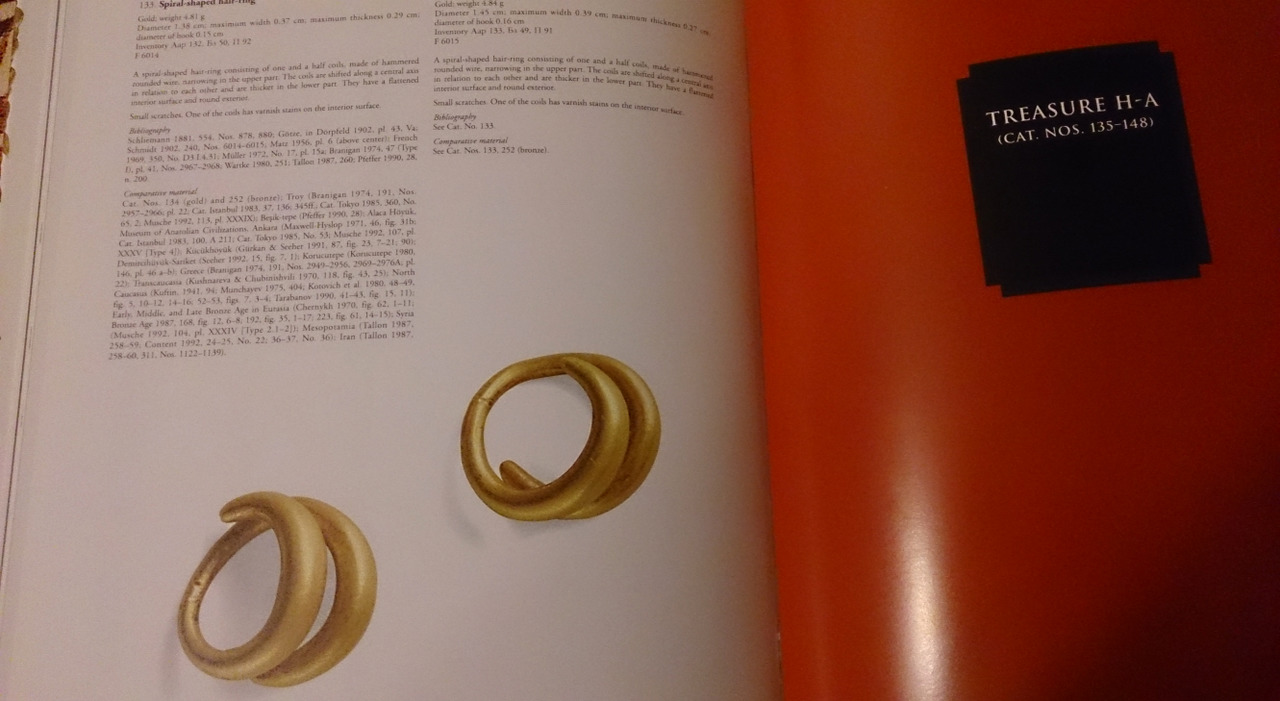
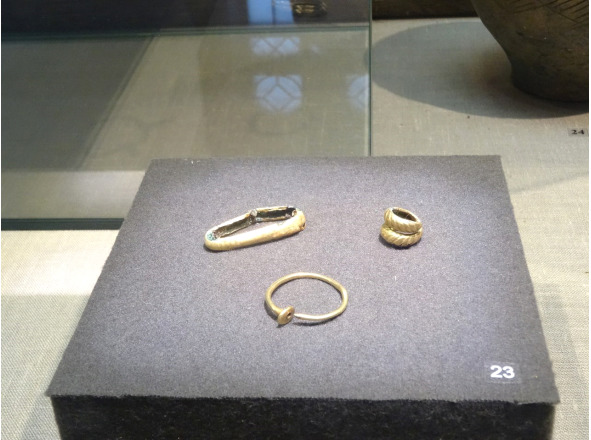
The oldest boat-shaped bucket found was found in the famous Gorbunovsky peat bog, not far from Omsk, the bucket is made of wood. Belongs to the Abashev culture, dated to the middle of the 20th millennium BC. So the use of ladles in everyday life was a characteristic feature of the Indo-European culture of the Bronze Age from Denmark and Russia, Greece, in Russia until the 20th century.
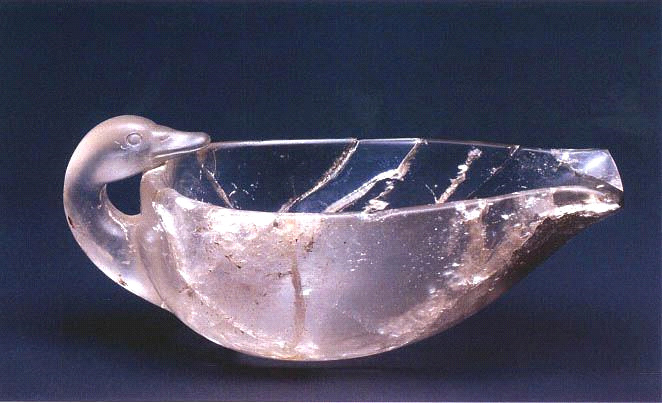
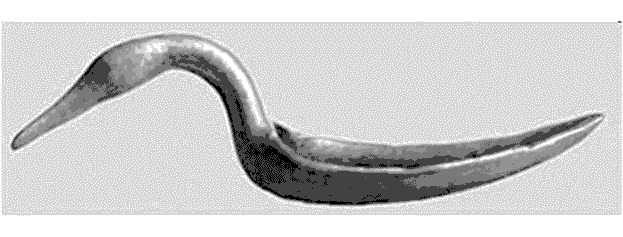
A very interesting find in Greece, a crystal ladle with a handle in the form of a duck’s head was found in Mycenae, dated to the 15th century. BC. The work, of course, is extremely difficult, how could a master make such a fragile thing, because it was not cast and was not blown out of glass? But the shape of this magnificent object copies wood products found in the distant Urals. Wooden buckets are later found in the burials of the Scythians already in the Iron Age, as evidenced by numerous finds. The culture of using ladles in everyday life was preserved in Russia until the 20th century; now these wooden objects are used as decorative dishes. That is, this ritual tableware can also be used as a kind of indicator of Indo-European culture.
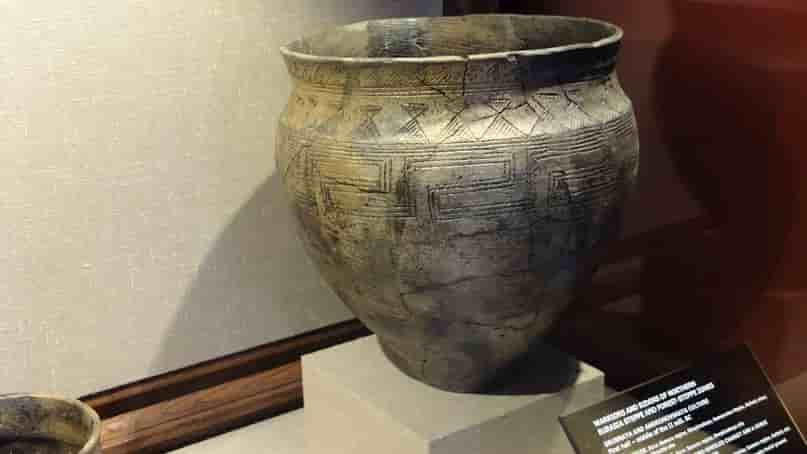
Blackened and milky pottery appears among the artifacts of the Yamnaya and Catacomb culture in the middle of the 3rd thousand BC. The method of making black-glazed ceramics was discovered in the boundless past. Who and when is now impossible to establish. It is known that the Etruscans (VIII — II centuries BC) already had a technology for making black-polished ceramics. In Russia, black-polished household utensils were widespread; the peak of its popularity fell on the period from the 3rd to the 19th centuries. The method is quite simple — the ceramics are smoothed, then the products are fired in a smoking flame without oxygen (staining). Milk is a very appetizing formulation and one of the most popular fire decorating methods. The bottom line is as follows — a sintered shard (which has passed through the roasting) is placed in milk and then baked again at a lower temperature (about 300°C). And this dish has been seen among the finds since the 3rd thousand BC. and to the present time in the basin of the Volga and Don rivers, and the steppes of the Black Sea region, and the Trans-Urals. Similar pottery was discovered by Schliemann and Taylor during archaeological excavations in Troy and Hellas, and similar utensils have been found in Crete and date back to the beginning of the third millennium BC. Bracelets, pins, wands with the image of a volute (double spiral) can also be called iconic. These finds are massive, and open bracelets with volute are one of the signs of these cultures.
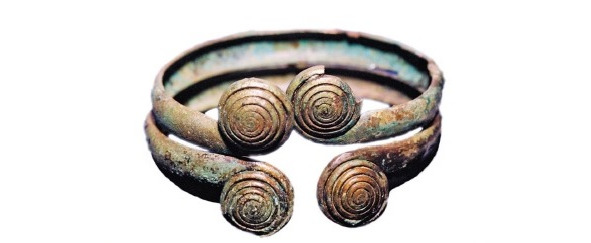
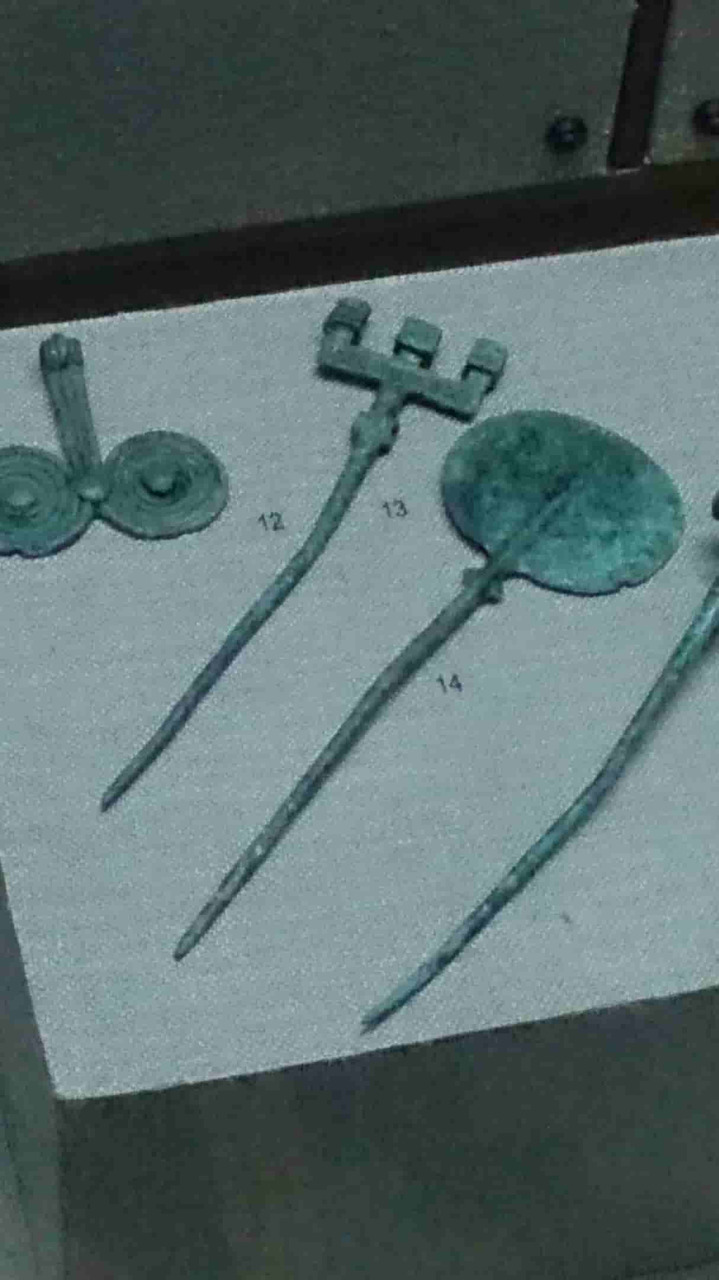
The gigantic rise of the Huns
Huns-Hans, but just real, ethnic Huns. and not members of the union of tribes who adopted the Hunnic culture, was distinguished by extremely high growth. According to the findings of the Tarim mummies belonging to the Andronovo culture, they grew up to 200 cm. The mummies were discovered in 1939. Bergman, and the most impressive finds in China were in the 1980s, where well-preserved remains were found, exhibited in the Urumqi Museum.
All the legends about the giants of Greece speak of the extremely high growth of these heroes, in Germany the Huns (Huns) are called giants, and the Burgundians, part of the Huns, also had gigantic stature according to the letters of the Romans. Savirs-Seversk-northerners of Novgorod-Seversk Land reached a height of 180 cm.
The closest to the Andronovites were the representatives of the European Corded Ware culture and the Sintashta culture, as well as modern Indian populations, according to the study by Keyser C. et al. “Ancient DNA provides new insights into the history of south Siberian Kurgan people.”
The magical power of number seven
The number seven appears to be significant for these northern tribes. There are numerous depictions of seven-pointed stars. Seven tribes of the union of Slavic tribes are known, the Union of seven Slavic tribes (Greek έptά γενεάς — “Seven clans” or “Seven tribes”) is an intertribal union of Slavs in the 7th century on the Balkan Peninsula, which, along with the Bulgars and other Slavs, became the basis of the future states of the First Bulgarian Kingdom and the Bulgarian people. The seven Hungarian tribes are Nyek (Hungarian Nyék), Meguer, Kurt-guarmat, Tarjan, Eno (Yeno) — one of the seven Hungarian tribes, Ker, Kesi. It would seem that there are different tribes, Hephtalites, Hungarians, Slavs. and everywhere the sacred union of the seven tribes. By the way, there is a Septimania region in France, and there were seven kingdoms in Britain — Mercia, Northumbria, East Anglia, Essex, Sussex, Sussex, and Kent. Seven wonders of the World that Hellas spoke about,
“I have seen your walls, Babylon, on which
And chariots; I saw Zeus in Olympia,
The Miracle of the Hanging Gardens of Babylon, the Colossus of Helios
And the pyramids are the deeds of many and hard works;
I know Mavsol’s huge tomb. But only saw
I am Artemis’ palace, which lifted the roof to the clouds,
Everything else faded before him; outside Olympus
The sun sees no beauty equal to it anywhere.”
Hellenic poet, Antipater of Sidon
Seven wise men of Ancient Greece, and not all were Hellenes by nationality.
“I call seven wise men — their homeland, name, speech:
“Measure is the most important thing,” Cleobulus used to say to Linda;
In Sparta: “Know thyself,” Chilo preached;
Restraining anger was admonished by Periander, a native of Corinth;
“Lish in nothing!” — the proverb was Pittac’s Mithilen;
“Watch the end of life,” repeated Solon of Athens;
“The worst are in the majority everywhere,” said Biant Priensky;
“Do not vouch for anyone” — Thales of Miletus word.”
Unknown ancient poet
Sometimes the Scythian sage Anarhasis is added to this list.
Seven Advisors of Alexander the Great by Arrian, this list of the most important dignitaries of Macedonia included Alexander’s friends, and this work is divided into seven books, too — also in imitation of Xenophon. Seven boyars of Russian tsars, because there were seven assessors in the boyar duma, and this figure is present everywhere Seven
Huns’ hairstyles — a shaved head, and a braid at the back of the head or on the right side of the head
Even hairstyles, such a seemingly unimportant part of human culture, turned out to be very similar in the zone of distribution of the Andronov Huns’ habitat. This tribe, or parts of it, reached China and India, and in the west to Egypt and Hellas, and left their mark even in such a part of human culture as hairstyles. It is hard to imagine that this was an accident. Obviously, it was the Huns-Hans who brought these hairstyles to this region, to Northern China. The deity GUAN-GUN (or Gun-Gong), carrying, as you can see, the Hunnic horses, is depicted in this way. Gun-gun (Chinese god of water, depicted with the body of a snake, a human face and red hair on his head. In some stories he is described as a man with a snake’s tail instead of legs. Gun-gun is a destroyer god, and in many legends it is he who causes disasters Most of the legends with him end with Gong-gong being killed or sent into exile, usually after being defeated in a battle with another major deity, such as, for example, the fire god Chzhuzhun.
Bian-fa (Chinese. “Pigtails”) — the traditional male hairstyle of the Manchus and other nomadic peoples of the Great Eurasian steppe It was a pigtail of three strands, which was braided at the back of the head or crown, while the hair was shaved off the forehead and temples.
The name of the Huns-Hans forever remained in the name of the Indian Gndhara, and the Ganges River. Krishnaites are Vaishnavas, and they wear Urdhva-Pundra on the bridge of their nose, a tamga depicted on the helmets of Urartu and Rus. For men, it is advisable to cut their hair short or shave it off, leaving a bun of hair called shikha on the back of the head. Shikha — a lock of hair on the back of the head, indicating belonging to the brahminical class. According to Vedic culture, when a person undergoes the ceremony of hair cutting (miracle-karana-samskara) and Vedic initiation (upanayana), he should shave his head, leaving only a tuft of hair called sikha. One who has a sikhu can practice different types of yajna. Therefore, according to Indian tradition, all brahmanas, Vaishnavas and others wear shikhs. According to the grhya-sutras, eccentricity should take place at the end of the first year of a child’s life or before the end of the third (Manu-smrti, II.35), but later scriptures have increased this age to seven years. First, the child’s hair is moistened, then the father cuts it while reciting prayers. After a child’s hair is cut, the father often leaves a shikha (śikhā IAST) or miracle (cūḍā). Analog-hair cutting in Hellas with ephebes.

Homer describes it as follows:
Lead and into battle led Elefenor, Aree’s branch,
The son of the Khalkodons, the head of the unrepentant Abants.
He foresaw these abants, on the rear of the hair they only grew,
Warriors of ardent, burning blows of clear copies
The copper armor of the enemies is to be smashed by hand on the Persians. Homer, Iliad.
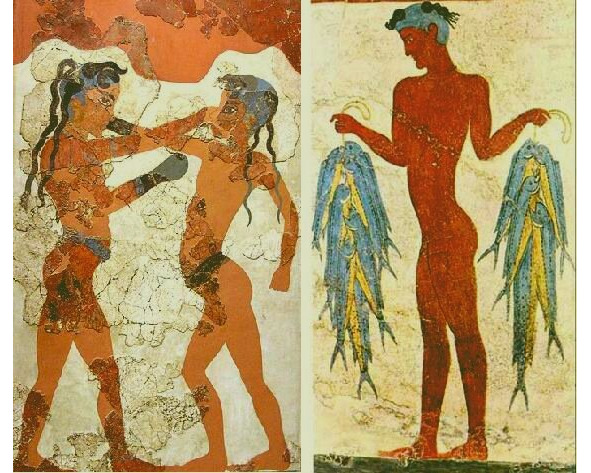
Thus, this hairstyle belonged to the Hans (Huns-Gants Andronovites) who brought it from Crete to India and China and Egypt, where they were called Hyksos (shepherd kings)
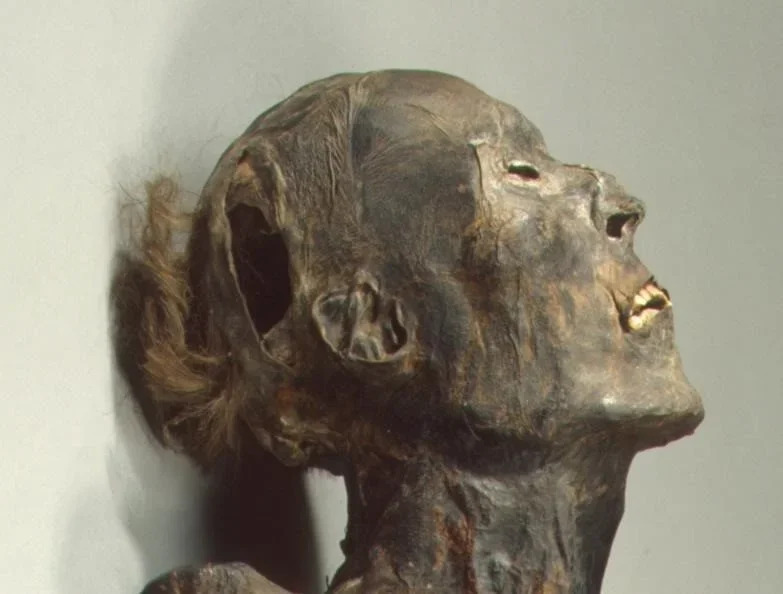

Severtsy-northerners, as part of the Hun tribe, retained their hairstyle, and the Cossacks, who come from the Severshchina, wore similar hairstyles — Oseledtsy and I \ ‘s forelocks.
The ancestral home of the Indo-Europeans. The ancestral home is Hell and Tartarus
The location of the ancestral home of the Indo-Europeans has always been a stumbling block for the scientific community and I would like to give a number of arguments for the primary habitat in the region of Obi-Yamal, Pechora, Arkhangelsk and Vologda regions and the islands of Novaya Zemlya. What makes it possible to come up with such an unconditional opinion? This geographical reference to this area is due to the myths and legends about Ganesh, Skanda, Indrik-beast. Tartar (ancient Greek Τάρταρος), in ancient Greek mythology — the deepest abyss located under the kingdom of Hades (representation, starting from Hesiod, where, after titanomachy, Zeus overthrew Kronos and the titans and where they were guarded by the hundred-handed giants of Hecatoncheira, the children of Uranus. the Cyclops are imprisoned. This is a dark abyss, which is as far from the surface of the earth as the sky is from the earth: according to Hesiod, a copper anvil would fly from the surface of the earth to Tartarus in nine days. Tartarus was surrounded by a triple layer of darkness of the god Erebus and copper walls with the copper gates of the god Poseidon. According to Hesiod, he arose after Chaos and Gaia. According to Epimenides, he was born from Aerus and Nyukta. According to other authors, as the personification of this abyss, Tartarus was the son of Ether and Gaia. From Tartarus Gaia gave birth to the monstrous Typhon and Echidna. Tartarus is mentioned by Homer (Il. VIII, 13According to the testimony of ancient Greek authors, Tartarus was in the North. Later, the authors began to consider Tartarus the most remote place in Hades. e century the most abandoned and remote corners of the earth began to be called tartar. In late antiquity, Tartarus was represented as a space of dense cold and darkness. Later, in European cartography, due to contamination, Tartarus was associated with Tartaria — northern Asia. The origin of the name of the god is not exactly clear; in any case, it was associated with the ancient Greek ἀϊδής “invisible”, ἀΐδιος “eternal”, ἀϊδνός “gloomy”, αἰδοῖος “venerable, compassionate”; αἰδώς, “awe, reverence”, but also “mercy”; ἀΐδηλος “making it invisible”, that is “destructive”, or “invisible, unknown, mysterious, gloomy”. the rivers of Hades, the most famous are Styx, Cocytus and Phlegeton, a flaming river. Hell and Tartarus are the land of the ancestors of the Huns (Hans), lands in the far North, from Yamal to Altai, the basin of the oil-bearing Ob river.
Giants, or Gants, that is, Huns-Hans, who also came from the Phlegrean fields, in myths they were described as opponents of the Olympic gods, and the Phlegrian fields are called their homeland.
In Chinese sources (Bei Shi and others), the state (and, accordingly, the people) of Yada is noted, attributed to the Xiyu region. Chinese historians found it difficult to indicate their origin; it was assumed that they were descendants of Yuezhi or Gaoju. They lived west of Khotan and south of the Altai spurs. The capital is the city of Badiyan, only 10 li in a circle. There is a palace and Buddhist stupas and pagodas adorned with gold. And in these sources the Hephthalite and Sarmatian Huns are called so. I.e. the Chinese call their land ADOM.
This geographical reference to this area is due to the myths and legends about Ganesh, Skanda, Indrik-beast. No one can argue that this is the closest place to the European part of the continent, where the remains of mammoths are massively found, and one of the most famous is Yamal, and the most famous find is the Yamal mammoth Masha. Often in the works of oral folklore, the “homeland” of the Indrik-beast is called — the Indian land full of wonders — India, which is not accidental, but there were several Indies in the history of migration of Indo-Europeans, and one was later described by Herodotus in the Caucasus as Sindika, an area in the Kuban region…
Here, as you can see, Tarja-reka is also mentioned, as the place of the ancestral home of the Indo-Europeans, which remained with the Hellenes in the form of Tartarus, as one of the places the land of ancestors.. Researchers have established an undoubted connection between the Indrik beast and the Vedic and Hindu deities Indra, and his weapon is the vajra and the vahana (carrier) is the elephant Aivarat, which also brings him closer to Ganesha (at birth Vinayak, then acquired the name Ganesha, Ganapati, Ganapati means the leader of the divine army of Shiva — ganas). Phlegrian fields also resemble Yamal and the Ob basin, where gas emissions are frequent and lead to explosions and burning of the soil. This can also explain the “milk rivers” and “jelly” banks. When condensation gets into the water. water becomes muna and resembles milk, and oil, mixing with the earth, turns it into jelly. And the slightest carelessness leads to inflammation, and here truly the hellish place is obtained. The climate here, to put it mildly, is not hot, that is, corresponds to the description of Hel of Scandinavia and Hell and Tartarus of Greece, damp, humid and cold, but the earth burns underfoot, and the water of the rivers is often poisonous from oil and gas, like the Styx of Hellas.
That is, the migration of Indo-Aryans from the coast of the Arctic Ocean is proved by the toponymy of places, the location of mammoth burial grounds in that region, and the emergence of myths about Ganesha, Apollo and Indrik-Zver, in the regions of the Ob river basin, and the present Arkhangelsk, Vologda regions and the Komi Republic, and Khanty-Mansiysk district, where there are cases of findings of mammoth remains. An additional argument in favor of the migration of Indo-Aryans from the Ob is the “Guestrovskaya Ode”, a poem published in Germany, the principality of Mecklenburg for the wedding, written by an unknown author specifically for the wedding in 1716 of Karl Leopold of Mecklenburg and Ekaterina Ioannovna, niece of Emperor Peter I, daughter of Tsar Ivan V Aleksey Tsarina Praskovya Feodorovna Saltykova, the elder sister of Empress Anna Ivanovna. This work describes the migration of the emboldened tribe from the Ob River to present-day Germany. Also, numerous finds of the most valuable artifacts in the Yamal region and the mouth of the Ob river, as well as in the area of the river. Kama of a later time, the so-called “Zakamsky silver”, which most likely were offerings from Iran, Byzantium to the sanctuaries of the Far North, described by Herodotus, who considers these places to be associated with the veneration of Apollo, and Herodotus gives evidence of Aristeus, who visited the Far North in execution vows. That is, the tradition, memories of the ancestral home, already at a later time turned out to be so strong that offerings to the gods to the ancestral home of the Indo-Europeans were sent from Iran and Greece, for which there is material evidence, these are the treasures of Yamal (as well as burials and numerous finds of people of the European type) and Zakamsk treasures. And probably, this area can be identified with Hyperborea of Ancient Greece, as the place of origin of a number of Indo-Aryan peoples.
Nobody can argue that this is the closest place to the European part of the continent, where the remains of mammoths are massively found, and one of the most famous is Yamal, and the most famous find is the Yamal mammoth Masha [Tikhonov A. N., Brave V. M. Mamontenok from Yamal // Nature. — 1989. — No. 6. — P. 46—47.]
So. What kind of Indrik is this beast, and what evidence of him remains? In the Russian apocrypha, especially in the numerous versions of The Spiritual Verse on the Pigeon Book, the name of this beast appears in different forms: Indrok, Indra, Kondryk, Beloyandrik, Vyndrik, Unicorn, Unicorn and Unicorn. The name variations can be summarized in two:
Indrik and the Unicorn (the name White is also important):
The beast is a mother to all beasts…
And he dug the earth with his mother’s horn,
Dug up the keys all deep I took out all the boiling water.
This animal lives across the ocean-sea,
And he walks here in the dungeon…
It passes all the white stone mountains,
Cleans streams and depressions,
It misses rivers, cold stores…
“Pigeon Book”
In different lists of the Pigeon Book verse there are different features in the image of Indrik, but in all he is called “the father of all beasts.” He walks through the underground, “misses rivers and wells, or lives on Tabor-mountain (that is, the Mountain of Light,”; “when he turns, all the animals worship him.” Or he lives on the Holy Mountain, eats and drinks from the Blue Sea, does not hurt anyone. Or he walks with a horn through the dungeon, like “the sun through the skies.” “The Dove Book” is a collection of East Slavic folk spiritual verses of the late 15th — early 16th centuries, the questions and answers of which provide information about the origin of the world. The book united both Christian and pagan motives. The book was preserved thanks to the tragedy of the schism in Orthodoxy, and was preserved among the Old Believers. According to Russian folklore, Indrik is endowed with the features of the master of the water element, springs and wells, and acts as an enemy of the snake.
Indrik, as the master of the water element, is close to the mythical bird Sirin — the symbol of water and fertility. Images of Indrik are often combined with “braid”, which in ancient times meant water. Often in the works of oral folklore, the “homeland” of the Indrik-beast is called — the Indian land full of wonders — India, which is not accidental, but there were several Indies in the history of migration of Indo-Europeans, and one was later described by Herodotus in the Caucasus as Sindika, an area in the Kuban region…
“And somewhere else, you can hear a foolish live,
Yes, stupid to live, unreasonable?
And where, you can hear, is the Indian land,
Indian land, all rich?
As there is a lot of gold and silver,
Yes, more than that kind pearls.
In the Indian land, the steppe is wild,
The steppe is wild, the forests are dark.
Indrik the beast lives in those forests:
He has all pearl little shorts on him,
And the mane-tail is gilded,
And his hooves are all damask,
Fire blazes from his nostrils,
A column of smoke comes from his ears.
He runs to drink in the Tarja River,
He runs, he runs — the whole earth trembles.”
Here, as you can see, Tarja-river is also mentioned as the place of the ancestral home of the Indo-Europeans, which remained with the Hellenes in the form of Tartarus, as one of the places of the land of their ancestors.. Researchers have established an undoubted connection between the Indrik beast and the Vedic and Hindu deities Indra, and his weapon is the Vajra, vahana bearer) is the elephant Airavata, which also brings him closer to Ganesha, and on whose behalf the name of the country — India, and the sacred river — Indus, and the people — Indians, and religion — Hinduism are formed. And in the Russian North there are still many names of rivers with the most ancient common Indo-European root “ind”. For example, the Indiga River is the river basins between the Pechora and Mezen rivers, the river flows into the Barents Sea, and one of the Indiga tributaries is the VYREY river (and it is known that Iriy-Vyri is the name of the Kingdom of Heaven in Slavic myths). from Yamal, west of the Ob, in the same administrative district. It is also interesting that there are places in the Russian North with the sacred name “Ida”. Scientists suggest that in the era of the ancient Indo-European ethnocultural community, Indra was the single supreme god of the Indo-Europeans. After the disintegration of the Indo-European conglomerate of tribes and the departure of the Aryans from the North to the Indian subcontinent, in the memory of the Proto-Slavs, and later the Russians, one of the many incarnations of Indra — “The King of Beasts”, “Mother of all beasts” was preserved. “A brief description of the Ostyatsky people” by Novitsky says: “some who want to confirm the narrated for the reliable, so His likeness is described: with a height of three arshins, almost an arshin length, his legs are like those of a bear, his horns, folded crosswise, he wears on himself, and when he digs caves, then he bends and stretches like a crawling snake. Some, contradicting this, argue that these bones belong to unicorns or some other beasts of the sea, during the flood of Noah, they were applied and dried up on the earth by water, but by antiquity they went into the earth.
“And the beast Indrik appeared. And the beast Indrik became a father to all beasts, a beast to all beasts. The beast Indrik itself is blue, and his eyes are golden. And maybe even the beast Indrik turns into a mighty blue warrior. His eyes are golden, he glows with a blue radiance of inner light, he holds a stone club in his hands, and he is dressed in stone armor. And so it is huge, higher than the mountains it is underground. The beast Indrik, the giant underground warrior, rides through the underworld in a stone chariot (that is, similar in skin color to Krishna and Yama (blue skin))
The wheels of that chariot are huge stone millstones, and monstrous black stone dogs, giant dogs, are harnessed to that chariot. And the eyes of those dogs burn like the fires of a thousand bonfires. And those dogs roar like a thousand thunders. And those dogs breathe fire and smoke. The beast Indrik, the giant underground warrior, rides through the underground world in his chariot. And he fights with lizards and underground dragons. And the Underground Lizard crawls away from him into his inferno. And he closes his inferno on the brass door.”
Throughout the Russian North and even farther — in Manchuria and China — legends about a strange creature of unprecedented growth called the indrik-beast are widespread. It is supposedly the size of an elephant and is endowed with horns that serve as a digging device. Descriptions of a giant mole named ting-shu or in-shu (“the mouse that hides”) we find in ancient Chinese books. Despite the hyperbolic dimensions of the incredible beast, it should be recognized that folk art is by no means a baseless fantasy. Life and real observations gave the narrators quite reliable material for this legend.
As said, this creature lives in the earth. It digs passages and tunnels with a horn and thereby opens keys, cleans springs and fills lakes and rivers with water. And if the indrik-beast under the ground makes noise, “the whole Universe will shake.” True, this is not a predatory beast, but a completely peaceful giant: “he does not hurt anyone,” apparently feeds on plants or what he finds underground. Well, it is quite possible that in this case we are talking about real mammoths, whose tusks and frozen carcasses are often found in Siberia. Apparently, both the legendary giant mole Tin-Shu, and Fan-Shu, and the Indrik-beast, and the Finnish Mamut are one and the same creature. The modern Russian name “mammoth” just comes from the old Russian word “mamut”. The Russians borrowed it from the Finnish tribes inhabiting European Russia. In many Finnish dialects, “ma” means “earth”, and “mut” means “mole” in Finnish, that is, mamut is an earthen mole.
“The mountain gave birth to a mouse” is a famous saying in ancient Greece and Rome. What does it mean? Apollo Sminthias Sminfey (Σμινθεύς), in Greek myth-making, the epithet of the god Apollo in the northwest of Asia Minor in Troas. The very name Sminfei is derived from the word αμίνθος, which meant a mouse among the Cretans. In this regard, the mouse was an attribute of the prophetic god Apollo, hence its name ζωον μαντικώτερον (prophetic animal). One of the months (Σμίνθειον) was named after Sminfei; in addition, ancient Greek authors mention the Rhodes festival of Sminfey. Pisarevsky writes that “The mouse in the cult of Apollo with Asclepius corresponds to the mole in the cult of Rudra with Ganesha” [Pisarevsky p.5] (The legend that only a mouse is afraid of an elephant). That is, the migration of Indo-Aryans from the coast of the Arctic Ocean is proved by toponymy of places, the location of mammoth burial grounds in that region, and the emergence of myths about Ganesha, Apollo and Indrik-Zver, in the regions of the Ob river basin, and the present Arkhangelsk, Vologda regions and the Komi Republic, and Khanty-Mansiysk district, where there are cases of findings of mammoth remains. Also, numerous finds of the most valuable artifacts in the Yamal region and the mouth of the Ob river, as well as in the area of the river. Kama of a later time, the so-called “Zakamsky silver”, which most likely were donations from Iran, Byzantium to the sanctuaries of the Far North, described by Herodotus, who considers these places to be associated with the veneration of Apollo, and Herodotus gives evidence of Aristeus, who visited the Far North in execution vows. That is, the tradition, memories of the ancestral home, already at a later time turned out to be so strong that offerings to the gods to the ancestral home of the Indo-Europeans were sent from Iran and Greece, for which there is material evidence, these are the treasures of Yamal and the Zakamsk treasures.
White gods of the Indo-Europeans
The Baltic Slavs had a deity BEL-God, his name was interpreted as kind, good. But the main thing is that he is WHITE. Bel-Bog sometimes became Chernobog, in a rage. And then it becomes clear why. Indrika, in the legends of the North is also called Blue.
Diomedes wounded Aphrodite at Troy according to the legend set forth by Homer:
The moisture that flows from the inhabitants of the happy sky:
For they do not eat brushes, nor do they partake of grapes of wine;
That is why they are bloodless, and they call them immortals.
With a loud cry, the goddess threw her son out of her arms;
Apollo quickly took him into his arms and accepted and rescued him,
ἰχώρ, οἷός πέρ τε ῥέει μακάρεσσι θεοῖσιν:
οὐ γὰρ σῖτον ἔδουσ᾽, οὐ πίνουσ᾽ αἴθοπα οἶνον,
τοὔνεκ᾽ ἀναίμονές εἰσι καὶ ἀθάνατοι καλέονται.
ἣ δὲ μέγα ἰάχουσα ἀπὸ ἕο κάββαλεν υἱόν:
καὶ τὸν μὲν μετὰ χερσὶν ἐρύσατο Φοῖβος Ἀπόλλων
And ICHOR, the transparent blood of the gods, flowed from the WOUND. So it is ichor that flows in the veins of the gods, making them immortal. BUT — the blood is transparent, namely the blood passing through the smallest capillaries gives the skin a pinkish tint. Blue, hesbej or irtiu, was made from a mixture of copper oxide with iron oxide, or from ground precious lapis lazuli or turquoise. Blue and blue — a semblance of the vast heavens and endless waters of the eternal ocean of Nun, symbolized life, rebirth and the blessed floods of the Nile. The feathers of the sacred bird Benu and the flesh of the universal god Amon-Ra were blue. THAT IS THE GODS EXACTLY WHITE IN THE DIRECT, AND NOT THE PORTABLE SENSE OF THE WORD. Sometimes in India, Krishna is portrayed not even with white skin, but with a bluish tinge of face. Here we should remember the legends about the BLUE BLOOD of the Chosen.
And in a rage the Gods terrified. After all, it is known that when a person is angry, the adrenaline rush and more blood enters the capillaries, that is, the face turns red. And what will happen to the Blue Blood, Ichor???
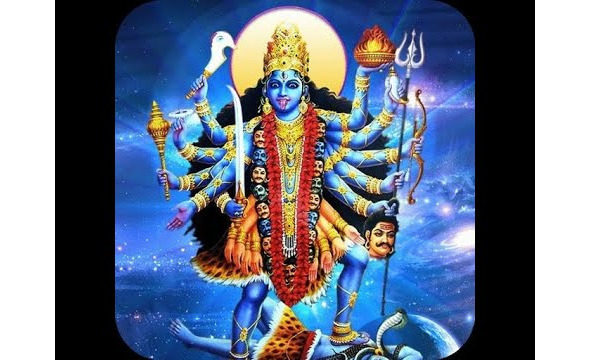
RIGHT. WE WILL SEE A BLUE (BLACK) FACE OF DEITY full of rage. Kali’s anger is so terrible that it threatens the existence of the world, therefore a special theme in mythology is the pacification of Kali. Also in mythology, Kali is the protector of the gods and bestowing liberation.
The presence of heads adorning the deity is also important here. The Sarmatians also have a similar image.
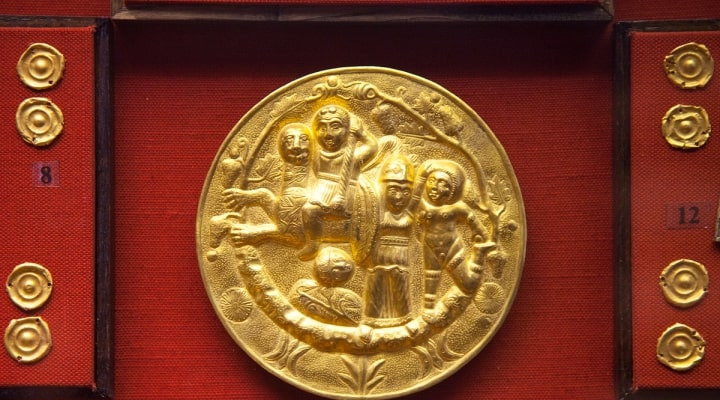
Initially, Achilles, according to Agamestra of Pharsalus, the son of Peleus and Thetis bore the name Pyrrisius (“Ice”). That is, it was also called snow-white.
There were such sayings associated with the blue blood of aristocrats, apparently based on memories of IKHORA. So the Deities are most similar in the Representation of Indo-Europeans, and indeed the Chinese and Japanese, as Shining (emitting light) and with a WHITE skin color (almost like vampires in a movie).
And among the Ugric, Volga tribes, the gods are called WHITE. The Mari worshiped many gods known as Yumo, while recognizing the supremacy of the Big White God (Osh Kugu-Yumo).
BUT — without red eyes, and the lips should be blue, like the nails. This is well described in the book of Solovyov The Dead Princess and the Seven Dreamers)
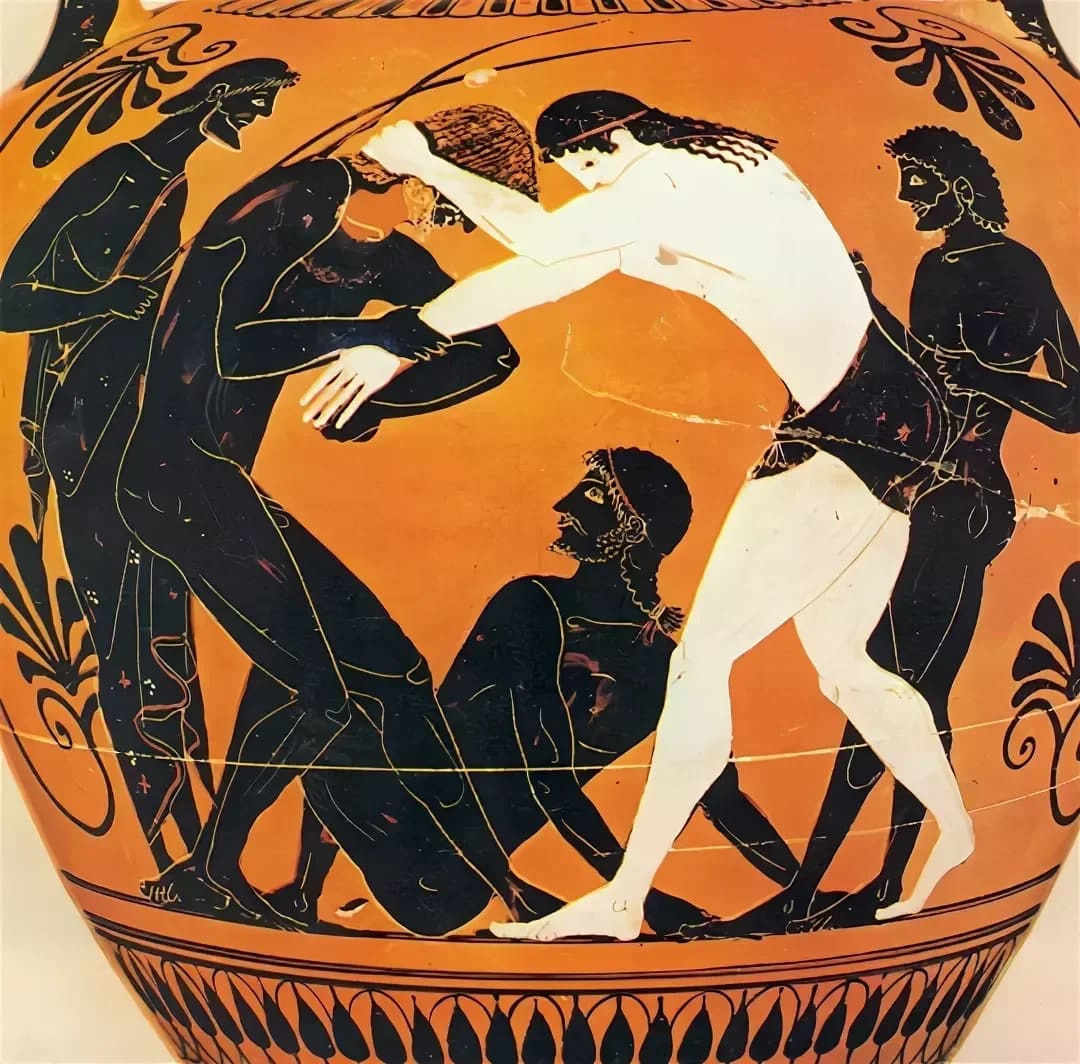
Opponents will say, where is the evidence!!! Actually, here is the image of Apollo wrestling with Hercules. The Greeks were dark-skinned, and by no means Negroes, but APOLLO WAS WHITE. Yes, he is depicted on the Vase. Do other peoples have memory? Remained, and even what! everyone’s favorite fairy tales “Snow White and the Seven Dwarfs”, as well as “The Dead Princess and the Seven Bogatyrs” and “Snow Maiden”. There is a legend about this custom in the tale of Snow White and the Seven Dwarfs, and the Snow Maiden. Snow White and the Princess in the fairy tale do not die, but only fall asleep, and even after three days are not subject to decay. That is, there is a memory of the appearance of goddesses who did not die, and had an unnaturally WHITE complexion. And one more thing — these girls were UNNaturally loved by animals, they were not afraid.
In fairy tales, girls are mentioned with unnaturally white faces, similar in color to ice, that is, really WHITE. Most likely, the matter is in IСHOR, the divine transparent blood (or, hence the legend about BLUE blood of the chosen ones), and then, of course, the skin color due to the capillaries will be whiter than snow (or slightly bluish).
In English, cold also means cool, and cool means cool, shameless. But — direct translation — cold, cold.
In Russian legends about Indrik:
“And the beast Indrik appeared. And the beast Indrik became a father to all beasts, a beast to all beasts. The beast Indrik itself is blue, and his eyes are golden. And maybe even the beast Indrik turns into a mighty blue warrior. His eyes are golden, he glows with a blue radiance of inner light, he holds a stone club in his hands, and he is dressed in stone armor. And so it is huge, higher than the mountains it is underground. The beast Indrik is a giant warrior underground in the underworld in a stone chariot.
Well, of course, people tried to be like gods, and therefore the custom of whitening of faces appeared.
“Women in Muscovy have a graceful appearance and a specious beauty of the face, but their natural beauty is spoiled by useless rubbing. They smear their faces so that almost at the distance of a shot you can see the paints stuck on their faces,”
The Church extremely disapproved of this practice, but could not do anything, and Archpriest Avvakum in vain complained:
“Other women will disgrace their face, and put on packs of colors — otherwise scarlet, other white, other blue, which is like a vile beast licks”
That is, the church was against this custom, and it is archaic to the extreme. This custom was reflected in the Tashtyks of Siberia, who used plaster or chalk to make up the dead, making them similar to Gods.
The idea of people in Eurasia that the gods can be ONLY WHITE is reflected in the canonical art of Christianity.
Yamal mummies
During the excavation of the Zeleny Yar archaeological site in the Yamalo-Nenets Autonomous Okrug, scientists discovered several mummified remains of ancient people. One of the mummies belonged to a beautiful young woman.
Specialists from the Institute for the Problems of Northern Development, together with colleagues from the National University of Seoul, began to study the mummies found during excavations of the archaeological complex “Zeleny Yar”, located 40 kilometers east of Salekhard. It consists of three monuments: a bronze casting workshop of the 6th-7th centuries. AD, burial ground VIII — IX centuries. and a burial ground of the XIII century. The first excavations were carried out here in 1976; since then, scientists have uncovered 70 burials, including collective ones. Fragments of ceramics, remnants of fur clothing and shoes, as well as copper objects: a bracelet, a cauldron and plates from a cauldron were found in them. The burials date back to the VIII — IX and XIII centuries; either men or children were laid to rest in them, but not a single adult woman has yet been found. The first female burial was opened only in the 2017 field season. The woman lived in the 12th century. A copper mask covered her face, which ensured his safety. Scientists managed to restore the appearance of the deceased — during her lifetime she was quite beautiful, had thick hair, long eyelashes and strong teeth. Fragments of the body, wrapped in birch bark and fur, are worse preserved. To date, scientists have only managed to establish that her height was 155 centimeters, and she died at the age of about 35 years.
The archaeological complex near the village of Zeleny Yar was discovered in 1997 during the work of the Russian-American expedition under the “Living Yamal” project. Excavations began there in 1999. It soon became clear that the complex consists of three parts: a bronze casting workshop of the 6th-7th centuries AD, a burial ground of the 8th-9th centuries and a burial ground of the 13th century. In 1999—2002, scientists uncovered 35 burials, 14 of which belonged to an early burial ground, and the rest — to a burial ground of the 13th century. The mummified remains of people were first discovered there: one adult man and four children aged one to two and six to seven years.
The medieval necropolis near the village of Zeleny Yar was discovered in 1997. Consists of three monuments: a bronze casting workshop of the VI — VII centuries. AD, a burial ground of the 8th — 9th centuries. and a burial ground of the XIII century. In 1999—2002, 35 burials were uncovered. For the first time, the mummified remains of one adult man and four children aged 1—2 and 6—7 years were discovered.
In July 2015, scientists found a birch bark cocoon, 1.3 meters long and about 30 cm wide, in which they found the mummy of a boy, presumably who died at the age of six to seven years. In a late burial ground, the remains of people buried in wooden sarcophagi, boats or wrapped in birch bark were found. All buried persons are dressed in fur clothes. In the space between the graves, they found bronze (copper) cauldrons with deliberately punctured bottoms, silver dishes and jewelry made of silver and bronze.
The mountains of the modern Urals in ancient times were called by the name of Yama-Ima — the mountains of Imaum. So they are signed on most ancient geographical maps. In the Middle Urals, one of the highest mountains bears the name of Yama (in India, the creator of the World) — Mount Yaman-tau. In the Northern Urals and in Yamal, near the Oka Bay, there were sacred Russian places — the abode of Maya Zlatogorka. In ancient times, on Yamal, there was a monument depicting Maya Zlatogorka (lit. Zlata Baba) and her two children — Kupala and Kostroma. This monument is depicted on many maps. There are similar images of Aphrodite with two children. In pre-Christian times, that is, until the 15th century, the Axis of Peace passed through Yamal. She was portrayed by the famous traveler Willem Barentsz on his map of the North Pole in 1598.
Migration of Indo-Europeans to the West, East and South
Yamnaya culture
The beginning of the formation of the culture of the Indo-Europeans is associated with the Yamnaya culture. In European historiography, it is the Yamniks who are considered the ancestors of all Europeans. In the passports of the Anglo-Saxons, the term “Caucasus” is written, meaning a Caucasian.
The Yamnaya culture (more precisely, the Ancient Pit culture and historical community) is an archaeological culture of the late Copper Age — Early Bronze Age (3600—2300 BC). It occupied the territory from the Southern Urals in the east to the Dniester in the west, from the Ciscaucasia in the south to the Middle Volga in the north. The Yamnaya culture was predominantly nomadic, with elements of hoe farming near rivers and in some settlements. The hoes were made of bones (horns). Pottery of the Yamnaya culture is becoming more perfect. And blackened dishes appear, although, possibly, milky (the film is formed due to milk.

Pottery of the Yamnaya culture.
Yamniks created wheeled carts (carts). The earliest finds in Eastern Europe of the remains of four-wheeled carts were found in burials under the burial mounds of the Yamnaya culture (for example, the “Watchtower” on the territory of the Dnieper, the burial ground near the village of Yasski in the Odessa region, the Shumaevsky burial ground in the Orenburg region, etc.). A characteristic feature of the Yamnaya culture is the burial of the dead in pits under the mounds in the supine position with bent knees. The bodies were showered with ocher. Burials in the mounds were numerous and were often carried out at different times. Burials of animals (cows, pigs, sheep, goats and horses) were also found. In the steppe zone from the Danube River in the west to the headwaters of the Manych River in the east, there are about 160 burials of the Yamnaya culture with the remains of wheeled vehicles (wheels, carts), as well as their clay models and remains of drawings. The oldest finds date from a calibrated scale to the 32nd century BC. e.
Four-wheeled carts were found on the banks of the Yalpukh River in the south-west of Moldova, near the village of Mayaki on the left bank of the Lower Dniester, near the village of Sofiyivka on the Ingulets River, in another burial on Ingul. The remains of a two-wheeled carriage come from the pit burial of the Watchtower burial mound near the city of Dnipro. Another carriage was found in the Pervokonstantinovka burial ground near Kakhovka, and the remains of a two-wheeled carriage were found near the village of Akkermen in the Melitopol region. One wheel each was found in a pit burial near the city of Rostov, in burial mound 7 of the Gerasimovka I, Shumaevo II burial ground in the Urals. In Shumaevo OK II / 2 3 wheels were found, Izobilny I 3/1 — 4 imitation wheels. Both wheels of a two-wheeled wooden cart from the Sentinel grave of the Yamnaya culture near the city of Dnipro (III millennium BC) were made of a solid piece of wood, cut longitudinally, with round holes for the axle and thick hubs.
In the region of Samara, a burial of two people was found with an antiquity of 3 800 years. The bodies are laid next to each other, face to face. As shown by the analysis of the genetic material, both people died from the plague bacillus, which had a genetic type similar to Justinian’s plague, and had the ability to live in fleas and thus rapidly spread from person to person. Considering that the plague stick from near Samara is the oldest example of such a mutation in the plague, scientists have confirmed that the massive migration of the population from the Yamnaya culture reached Europe, eventually giving rise to the Corded Ware Culture, and in Central Asia and Altai — the Afanasyev culture. Analyzes of the remains of other European cultures — Srubnaya, Sintashtinskaya, Potapovskaya and Andronovskaya, confirm that the plague bacillus has genetically related lines with the one that was found near the village of Mikhailovsky. These crops represent an example of the reverse migration that the farmers of these crops carried out from Europe, all the way to Central Asia. Yamnaya culture originates from the Khvalyn culture in the middle reaches of the Volga and from the Sredniy Stog culture in the middle reaches of the Dnieper, and it is also genetically called with the culture of funnel-shaped cups. The Yamnaya culture is replaced by the Poltava culture. In the west, the Yamnaya culture is replaced by the catacomb culture. In the east — the Andronovo and Srubnaya cultures. The Kemi-Obinsk culture of Crimea is a derivative of the Yamnaya culture.
And in the Yamnaya culture, the rite of rendering harmless the dead can already be traced. Double pit burial Tamar-Utkul VIII. The upper skeleton is abundantly sprinkled with ocher, the lower one is dissected and placed in the legs. Speaking about the dismemberment of the dead among the Yamny tribes, we should also mention a somewhat similar custom of demembration. The rite of demembration, in its basic understanding, means the deliberate displacement of the bones of the human skeleton from their original position and placing them either in disorder or in an order directly opposite to the original position in which the deceased was at the time of burial. Not taking into account the cases when dismembered skeletons play an accompanying role with undisturbed skeletons, it can be reliably judged that demembration observed in the burials of the Yamnaya culture of the region is a sign of a certain social stratum of society in the Early Bronze Age.
However, it is also important that to the east of the Dniester, pit burials with the use of reingumation are much less common than on the territory of the Prut-Dniester interfluve. This observation, to a certain extent, can serve as proof that demembration and the custom of laying the bones of the buried in a “package” is a narrowly local feature for the Yamna culture of the Dniester-Danube region.
No traces of the archaeological influence of the Yamnaya culture in South Asia, including Tajikistan, have been found. Linguistic research also suggests that the languages of the Indo-Iranian group could have come to South Asia not 3000—2500 BC, but later — between 2300—1200. BC. These findings prompted a new search for a source for the languages that were spreading during that period. As a result, the study showed that there is no mass migration of nomads-steppe people to South Asia from the Yamnaya culture in the Early Bronze Age and the like; however, it is possible. there was a migration from steppe cultures in the late Bronze Age. Metal raw materials were mined in the Kargalinsky mining and metallurgical center.
Catacomb culture
The catacomb cultural and historical community is an ethnocultural association of the Middle Bronze Age (XXV — XX centuries BC), widespread in the steppe and forest-steppe zone from the Urals and the North Caucasus to the lower Danube. It was originally identified as an archaeological culture in 1901—1903. V. A. Gorodtsov.
Later, researchers identified local variants, which were identified as independent archaeological cultures. The concept of “catacomb cultural and historical community” was introduced into scientific circulation. Presented by the monuments of the following catacomb cultures:
— Early Catacomb (XXV — XXIII centuries BC),
— Donetsk (XXIII — XX centuries BC),
— Middle Don (XXVIII — XXVII–XX centuries BC),
— ingul (XXVIII — XX centuries BC).
The pioneer of the catacomb culture was V.A. and a burial chamber (burial place). In accordance with the design features of the burial structure, the culture allocated by him was called the catacomb culture. Catacomb burials are known in the same region much later, both in the Sarmatian time, and in the burials of the Saltovsko-Maetskaya cultures. The very structure of the grave — consisting of a dromos and a burial chamber, often with a dome, has parallels in the famous tomb of King Hinze in Germany, and probably with the device of the famous domed tombs of Hellas. The southernmost monuments are known in the Crimean steppes, and the most northern ones are near Kursk and Yelets. Catacomb settlements are known on the Don (near Rostov), Kibikinskoye near Lugansk, Ternovskoye near Kamyshin on the Volga, etc. Later, researchers turned their attention to the heterogeneity of catacomb sites in various territories, which contributed to the identification of a number local options. With the accumulation of archaeological material, the prerequisites were created for understanding local variants as independent archaeological cultures of a single catacomb cultural-historical community, which was ultimately done in the early 1970s by researchers L. S. Klein and O. G. Shaposhnikova.
The problem of the origin of the catacomb culture (later the catacomb cultural and historical community) was posed at the beginning of the 20th century by V.A.Gorodtsov, almost immediately after the discovery of burial burials in the catacombs on the Seversky Donets, but it still remains controversial. Researchers are discussing autochthonous and migration theories of the origin of the tribes of the catacomb community. The adherents of the autochthonous theory believe that the emergence of the catacomb community should be associated with the further development of the local Yamnaya population. Supporters of the migration theory express the idea that the catacomb tribes go back genetically to the Yamnoye, but arise under the strong migration influence of the populations of the Ciscaucasia. The type of economy of the carriers of the catacomb cultural and historical community was determined by the ecological conditions of the steppe and forest-steppe zones. So, in the steppe, pastoral or distant pasture cattle breeding of the nomadic type, which was based on the breeding of cattle and small ruminants, took root. In the forest-steppe, the model of pastoral or stall cattle breeding is spreading with a predominance of cattle and pigs in the herd. The catacomb cultural and historical community is characterized by ancestral settlements and low (up to 1 m) burial mounds without cremation. Catacomb burial device, ritual ceramic censer, cord stamp ornament, flat-bottomed cups, twisted corpse position on the side. Wooden carts are found in the burials. Ceramic implements contain elements of the globular amphora and corded pottery cultures of Central and Eastern Europe.
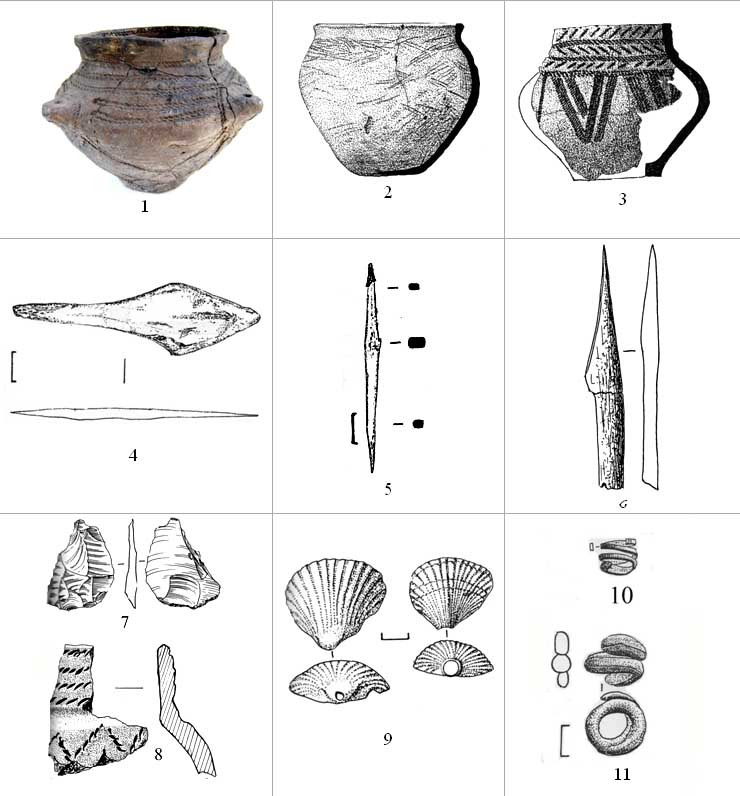
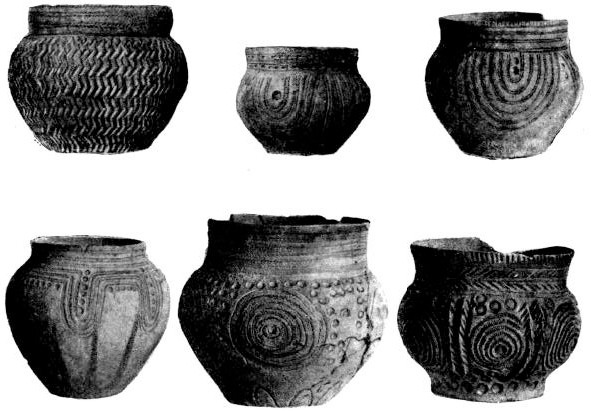
Temple lobed rings Blackened dishes with spiral patterns
The pottery is also blackened, with a relief pattern, often spiral, which brings them closer to the Tripillian ones, but the people of the Catacomb culture did not apply the pattern to the dishes, but squeezed it out. This brings the ceramics of the Catacomb culture closer to that of the Middle Hellenic culture.
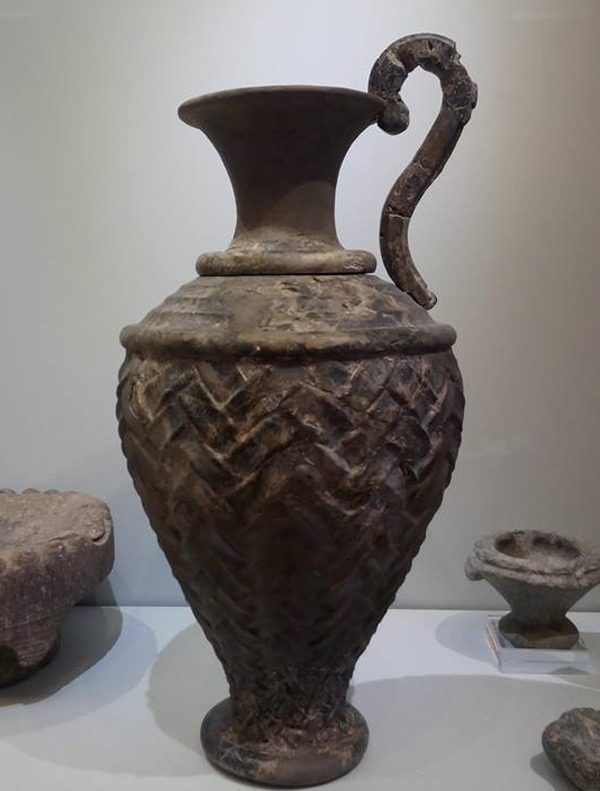
The pottery of the Catacombs differs from the primitive and uniformly shaped dishes of the ancient pit culture. Known flat-bottomed pots with convex sides and a narrowed neck, the surface of which is decorated with an ornament applied by prints of a twisted rope, comb teeth or just a sharp object. The motives of the ornament are triangles, zigzags, but circles and spirals are more common, reflecting the cosmic ideas of the ancient farmers about the solar deity and mysterious plant principles that turn grains into stems, which in turn give rise to many of the same grains.
A metallurgical center was located on the territory of Donbass. This is also confirmed by the finds in the Donetsk catacomb burials of stone beaters, which were used for crushing ore before washing and smelting. In the inventory of the catacomb culture, there are bronze items: leaf-shaped knives, axes with eyelets, awls and bronze decorations, but most of the tools were still made of stone and bone. In the Dmitrovsky mound No. 6 in the Zaporozhye region, at the entrance to the burial chamber, a wooden catacomb cart with a fully preserved wheel, 5 thousand years old, was found. A two-wheeled cart with a preserved wheel 0.6 m in diameter is known from the Tyagunova Mogila catacomb burial in the Zaporozhye village of Maryevka. In the burial complex Ulan IV of the Western Manich catacomb culture in the Rostov region, a four-wheeled carriage was discovered, made in the XXIII century BC. e.
Skulls of the catacomb stage are distinguished by brachycrania and a higher vault than in the Yamnaya culture. Male skulls are characterized by a high mesocranial cranium, a highly profiled wide face, wide cheekbones, a high nose bridge, and a very large protrusion of the nasal bones. In the steppe Dnieper region, there are three craniological options:
— brachycranial — does not find analogues of the Bronze Age.
— mesocranial — reveals a distant resemblance to the skulls of the Afanasyevsk culture of Altai.
— dolichocranic — similar to the Noua and Srubnaya culture groups.
If we talk about the catacomb culture, apparently, the rite of rendering harmless the dead, dismembering dead bodies to neutralize their harm to the living, was not only inherited from the pit, but also received further development. So, among the catacomb tribes, the custom of decapitation (separation of the head) became widespread, which can be considered on the example of the Middle Don catacomb culture.
Finds of burials with detached skulls are recorded throughout the entire territory of the Middle Don catacomb culture from the Seversky Donets to the Don-Volga interfluve (the Khoper River). On the territory of the Middle Don, among more than 400 burials of the Middle Don catacomb culture, five burials with skeletons are known, in which the separation of the skull of the buried person has been reliably recorded.
All examined burials were accompanied by ocher, which was located both in separate burial places and completely covered the skeleton of the deceased. In each burial, ocher, as it were, emphasizes the special ritual significance of the objects it accompanies. This type of “special burial” is distinguished by a variety of accompanying inventory. The set of implements in each burial is individual, but a common feature for all burials is its originality. Almost all decapitated burials were accompanied by animal bones. In addition, a particularly interesting find is two divination bones. According to some researchers, “dice”, but rather oracle bones, that is, the buried person was a representative of the priestly group. “Dice with signs” or dice, namely the oracular dice, originally had a cult character, were the prerogative of a certain class associated with the performance of priestly functions. The flute and the bone hairpin (Vlasovka 12/3) are among the cult objects. The deceased already have an artificial deformation of the skulls. According to A.T. Sinyuka, all burials, where the burial rite was used under the mound, indicate the high social status of the deceased. Only prominent representatives of society and their immediate entourage could claim burials under the mound. But even from this series of burials, decapitated burials stand out according to special features. Researchers believe that it is possible to assert with a fair degree of confidence that decapitated burials are not a specific feature of a particular culture of the catacomb community, but most likely have a supracultural nature, reflecting the complex social structure of tribes — carriers of catacomb traditions. The burial place of a teenager girl was found. It was hammered in with boulders weighing hundreds of kilograms, which speaks of a lot of fear inspired by such a young creature. But the belief in the “malefic” dead seems obvious and proven.
Srubnaya culture
Srubnaya cultural-historical community is an ethnocultural association of the late Bronze Age (XVIII — XII centuries BC, according to other estimates — XVI — XII centuries BC. Some scientists, like I. Berestnev S.I., that the Timber culture existed until IX BC, widespread in the steppe and forest-steppe zones of Eastern Europe between the Dnieper and the Urals, with individual monuments in Western Siberia and the North Caucasus.It was originally identified as a culture in 1901—1903 by the Russian archaeologist V.A.Gorodtsov, but in the 1970s, N. Ya. Merpert and E. N. Chernykh drew attention to local differences within culture and introduced the concept of “timber-frame cultural and historical community” into scientific circulation. Represented by monuments of the Pokrovskaya (XVIII — XV centuries BC) and Berezhnovsko-Mayevskaya (XVII — XII centuries BC) log cultures, representing settlements, necropolises, workshops, mines, treasures and single finds. Dwellings — dugouts, semi-dugouts and ground. Necropolis are represented by burial mounds and soil commodity burial grounds. In the kurgan stratigraphy, log burials occupy the upper position in relation to the tombs of the pit and catacomb communities. The ceremony provided for the burial of the deceased in pits or wooden log cabins in a bent position, on the left side, hands in front of the face. There are also known cases of cremation. Burial items are represented by sharp-ribbed and canned vessels, less often — metal items. Changing climatic conditions, depletion of natural resources and overpopulation led to a sharp decline in the population and cultural transformation of the tribes of the Timber community. The pioneer of the log culture was V. A. Gorodtsov, who in 1901—1903, in the process of researching the barrow antiquities of the Seversky Donets, turned his attention to twisted burials in wooden frames — log cabins. In accordance with the design features of the burial structure, the culture allocated by him was called Srubnaya. The concept of the origin of culture from the Poltava monuments of the Volga region and its migration at a later stage was developed in the mid-1950s by O.A. In the 1970s, N. Ya. Merpert and E. N. Chernykh turned their attention to local differences within the Srubnaya culture, but the selection of individual local variants or cultures, in their opinion, at that time was problematic. Later, in the course of scientific research, a number of researchers turned their attention to the anthropological, chronological and cultural differences between steppe and forest-steppe monuments, which confirmed the hypothesis of local differences in the environment of the logging cultures. N. Ya. Merpert and E. N. Chernykh introduced the concept of a “log-house cultural-historical community” into scientific circulation, which reflects its cultural heterogeneity. In the mid-1970s, NK Kachalova, based on materials from the Lower Volga, identified the Berezhnovsky type of monuments, and IF Kovaleva, based on materials from the Mayevsky burial ground (Dnepropetrovsk), identified the Mayevsky type of monument]. In the 1990s, N. M. Malov and O. V. Kuzmina, based on materials from the Pokrovsky burial ground, distinguish a separate Pokrovsky culture. The common features of the burial rite of the Berezhnovsky and Mayevsky types of monuments allowed V.V. Otroshchenko to combine both types into a separate Berezhnovsky-Mayevsky culture as part of the Timber Cultural-historical community of the Late Bronze Age. Yu. M. Brovender identified the Stepanov type of monuments in the environment of the Berezhno-Mayovskaya logging culture. Thus, the Pokrovskaya and Berezhnovsko-Mayovskaya logging cultures and the Stepanovka type of monuments are distinguished in the environment of the Timber Cultural and Historical Community of the Late Bronze Age, which reflects its cultural heterogeneity and formation features. The problem of the origin of the Srubnaya culture (later the Srubnaya cultural and historical community) was posed by V.A.Gorodtsov in 1907, almost immediately after the discovery of burials under the kurgan in log cabins on the Seversky Donets. The researcher formed the migration concept of origin, which was finally formalized in the mid-1950s by O. A. Krivtsova-Grakova. The researcher believed that the Srubnaya culture was formed in the Volga region on the basis of the Poltava culture of the Middle Bronze Age. One of the variants of this hypothesis is V.S.Bochkarev’s concept of the Volga-Ural cultural genesis. Migration theory has not received absolute support in the scientific community. N.N. Cherednichenko spoke in favor of the autochthonous origin of the Timber culture. In his opinion, all local variants of the Srubna culture are synchronous, and there was no single center of culture origin, and the formation of each variant should be explained proceeding from the specifics of the local archaeological situation. V.V. Otroshchenko developed in the 1990s the concept of the development of the Timber Cultural and Historical Community from the Sintashta, Don-Volga Abashev, Baba cultures and monuments of the Potapov type of the Middle Volga region in the process of their ethnocultural interactions. In accordance with it, the researcher identified the Pokrovskaya and Berezhnovsko-Mayovskaya log cultures among the community, which, in his opinion, developed on a different basis. The Pokrovskaya Srubnaya culture develops in the forest-steppe interfluve of the Don and Volga due to the political and cultural influences of the carriers of the Sintashta culture on the late Bashevo population, from where it spreads to other regions.
Protoberezhnovskie sites are common in the Lower Volga region, where, according to the researcher, the Novokumak ethnic component, which came from the east, is layered on the Late Catacomb population. Later, the tribes of the Pokrovskaya Srubnaya culture moved to the left bank of the Seversky Donets, where they were completely assimilated by the bearers of the Baba culture. As a result of the assimilation of the Pokrovsky population by the Babinsk tribes Berezhno-Mayovskaya Srubnaya culture is being formed. The Pokrovskaya Srubnaya culture (XVIII — XV centuries BC) is widespread in the steppe and forest-steppe zone from the Seversky Donets to the Volga. Some monuments are presented in the Urals. An eponymous monument is the Pokrovsky burial ground in the Saratov Volga region, which was investigated by P.S. Rykov in the 1920s near the town of Pokrovsk (now — Engels). Highlighted in the early 1990s by N.M. Malov and O.V. Kuzmina as the Pokrovskaya culture. It was formed on the basis of the Don-Volga Abashev culture under the direct influence of the Sintashta and Potapov-type monuments of the Middle Volga region. Monuments are represented by settlements, burial grounds, treasures, mines, workshops and accidental finds. The settlements were located in the immediate vicinity of rivers on small heights. The most studied settlements are Lake Usovo, Mosolovka, Kapitanovo, Yanokhino, Rubtsy and Prokazino.
Dwellings of that time, above-ground, dugouts and semi-dugouts of a frame-and-pillar structure with a gable or hipped roof. The walls are made of turf, logs, rarely of stone. In large buildings, the residential part is most often separated from the utility part. Inside the dwellings there were one or more hearths, pits, and sometimes a well. Funeral monuments are represented by burial mounds and ground burials. They are mainly located on terraces or hills along river banks, less often on watersheds. The burial mounds of the Pokrovskaya culture include a small number of embankments — from 2 to 15. Single burial mounds and huge necropolises are rare.
The mound was erected after the last burial. The number of burials in the mound varies from 1 to 100. The deceased were buried in sub-rectangular pits, sometimes in log cabins in a crumpled position on their left side, in an adoration position, with their head to the north. Vessels serve as burial implements, less often weapons and jewelry. The graves also contain animal bones — the remains of meat food. The most studied burial grounds are Pokrovsky, Staroyabalaklinsky and Novopavlovsky. The ceramic complex of the culture is represented mainly by sharp-ribbed pots with geometric patterns. Tools and weapons made of stone are represented by a variety of axes and maces, arrowheads, scrapers, hammers, knives, anvils, miners and abrasives. Ornaments are also known — earthenware beads, grooved temple pendants and bracelets. Bone products are widespread: cheekpieces, awls, polishes, punctures, needles, knitting needles, arrowheads. Tools made of metal are represented by axes, sickles, testers and chisels, punctures, cutting knives with a wide rhombic crosshair and daggers with a cast-in handle. Decorations made of bronze, antimony and gold are also widespread: rings, temporal lobular rings, plaques, spiral-shaped bracelets and open bracelets with a spiral ending. In general, the spiral pattern was widespread.
The basis of the economy of the carriers of the Pokrovsk culture was stall and distant pasture cattle breeding. Ethnically, the population of the Pokrovskaya Srubnaya culture represents an Indo-Iranian ethnic group and had certain signs of an Indo-Aryan ethnos at an early stage of its development.
The Berezhnovsko-Mayevskaya Srubnaya culture (XVII — XII centuries BC) is widespread in the steppe and forest-steppe zone from Ingulets to the Volga. Eponymous monuments are the Berezhnovsky burial mound in the Volga region and the Mayevsky burial ground near the city of Dnepropetrovsk. In the 70s of the XX century, N.K. Kachalova identified the Berezhno type of monuments, and I.F.Kovaleva — the Mayev type. The general features of the funeral rite made it possible for V.V. Otroshchenko to combine both types into a separate Berezhno-Mayev culture as part of the Timber Cultural-historical community. Yu. M. Brovender distinguishes the Stepanov type of monuments in her environment. It was formed on the basis of Babinskaya and Pokrovskaya Srubnaya cultures. Monuments are represented by settlements, burial mounds and earthen burial grounds, mines, workshops, treasures and random finds. The settlements were located in the immediate vicinity of rivers on small heights. Dwellings are represented by dugouts, semi-dugouts and ground structures with stone walls. Fireplaces were used to heat the dwellings. Funeral monuments are represented by burial mounds and ground burials. Kurgan necropolises are located mainly on terraces or hills along river banks, less often on watersheds. They include a small number of fillings, usually with several fillings. The construction of long mounds was practiced. The deceased were buried mainly in sub-rectangular pits, sometimes in stone boxes, in log cabins in a crouched position on their left side, with their heads to the east. Cremation is also known. Soil burial grounds of the Berezhnovsko-Mayevskaya culture are located mainly on the edges of the indigenous banks, the first terraces above the floodplain, and on small natural elevations in the floodplain — in the immediate vicinity of rivers and settlements synchronous to them. Burials are represented by inhumations and cremations. Burials according to the inhumation rite were performed in sub-rectangular pits and stone boxes. Burials in log cabins on the territory of ground burial grounds were not recorded. The deceased were located in a crumpled position on their left side, with their heads to the east. Cremations are represented by burials in urn vessels and in small ground pits. Vessels are used as burial implements; metal products are less common.
Ceramics is represented by jars, pot-shaped and sharp-ribbed vessels with geometric patterns in the form of horizontal and inclined lines, flutes, zigzags, Christmas trees and other geometric shapes. Sometimes on vessels, mainly in their upper part, there is a cord ornament and various signs in the form of crosses, solar signs, rectangles, schematic anthropomorphic and zoomorphic images. At a later time, the swastika and meander pattern began to be depicted. A number of researchers see them as primitive pictographic writing. The content of these signs has not yet been deciphered. The burials also contain wooden cult utensils, sometimes with bronze fittings. Tools and weapons made of stone are represented by a variety of axes and maces, side-scrapers, hammers, knives, anvils, miners and abrasives. Bone products are widespread: cheekpieces, awls, polishes, punctures, needles, knitting needles, arrowheads. Tools made of metal are represented by axes, sickles, whips and chisels, punctures, needles, cutting knives with a marked crosshair and daggers with a ring stop.
Metal jewelry is also widespread: rings, temporal lobed rings, wire pendants, spiral bracelets, and open bracelets with double volute. Volute, appears in the form of hairpins and images. The basis of the economy was stall and distant cattle breeding, which supplemented agriculture. Ethnically, the carriers of the Berezhno-Mayev culture represent the Iranian-speaking group of the Indo-European language family. Recently, there has been an active scientific debate regarding the upper chronological limit of the Timber Cultural-historical community. … S. I. Berestnev in his work “The Timber Culture of the Forest-Steppe Left Bank of Ukraine” extends its existence up to the 9th-8th centuries BC, that is, the Timber culture is replaced by the Cimmerian-Scythian culture.
Neutralizing the dead
Gubin A.S. In his article, “Uncommon Burials Burials of the Timber Culture of the Ural-Volga Region,” he writes that, according to excavations, in the Ural-Volga region, and conducting a study of materials from excavations of the Timber culture burials, it was possible to establish that signs of neutralization were found in 7 cases out of 30 (23, 3%). The term “neutralization” by Gubin means deliberate mutilation of a corpse: cutting off the head, limbs, and other parts of the body. A burial with a missing skull was recorded at the Kachkinovskoye burial ground (burial mound no. 15, burial no. 1), here in burial no. 1 of mound no. 20 the skull was present, but it was located 50 cm to the north of the ridge [5: 13]. In a single burial of kurgan No. 37 of the Staro-Yabalaklinsky burial ground, there were no hand bones, and in adolescent burial No. 1 of kurgan No. 104, hands, feet, and a skull were missing from the skeleton [6: 47]. Gubin notes that grave goods were present in all burials with signs of neutralization.
Culture
The type of economy of the carriers of the Srubna cultural and historical community was based mainly on stall and distant pasture cattle breeding, which, among the population of the Berezhno-Mayovskaya Srubna culture, partially supplemented agriculture. In the Dnieper-Donetsk interfluve, single grains of cultivated cereals were found, which indicates the presence of floodplain agriculture in the economy of the Timber tribes. In the Ciscaucasian and Caspian steppes and semi-deserts, it is possible that semi-nomadic livestock raising was practiced. Nevertheless, the basis of the economy of the sedentary log house population of the Late Bronze Age was stall and distant cattle breeding. The priority was the breeding of cattle, a smaller percentage of the herd were horses. An important role in the economy of the population of the Srubna cultural and historical community was played by mining and metallurgical production, which was based on cuprous sandstones of the Urals (Kargalinskoe deposit) and Donetsk ridge (Bakhmutskoe deposit), ore occurrences of the Middle Volga region were also used. The basic production of metal products was predominantly located in several villages of metallurgical foundry workers — Lake Usovo (Podonechye), Mosolovka (Podonye), Lipovy Ovrag (Middle Volga region), Gorny 1 (Urals).
The tools required for metalworking are represented by axes, hammers, hammers, ore grinders, flat and grooved tesserae and chisels, “log” type cutting knives and daggers. In the late Timber period, the Timber blacksmiths master the secret of obtaining critical iron, from which the first few items are forged, mostly small in size and weak in workmanship. There are also gold jewelry.
The absence of written sources significantly complicates the solution of the issue of the ethnicity of the tribes of the Timber Cultural and historical community of the Late Bronze Age. Thus, the main method for determining ethnicity is to establish a connection between the area of the tribes of the Timber community with the spread of Indo-Iranian hydronyms and toponyms. Their pre-Scythian origin was convincingly proved by the linguist V.I. Abaev. Later, N.L. Chlenova traced the Iranian hydronyms in the steppe and forest-steppe zone from the Dnieper to the Ob, which completely coincided with the distribution area of the tribes of the Timber and Andronov cultural and historical communities and proved their belonging to the Iranian-speaking group of the Indo-European language family.
According to V.V. Napolskikh, borrowings in the Finno-Ugric languages indicate that the carriers of the Bronze Age steppe cultures spoke the language of the Indo-Aryan type. Such attribution, as evidenced by the phonetics of borrowings, has traditionally been rejected for historical reasons. The Eastern Iranian speech spread in the steppe only with the culture of roller ceramics at the end of the 2nd millennium BC. e. The bearers of the Srubna culture chronologically preceded the Scythians and Cimmerians. For this reason, the Srubnaya culture is often regarded as an archaeological analogue of the first Iranian dialects of the Northern Black Sea region. In other words, the carriers of culture are the predecessors of the Scythians and their kindred peoples. However, there is another point of view: the area of the Srubnaya culture is a bridgehead from which the migration of ancient Iranians to the northwest of modern Iran took place. According to this point of view, the semi-nomadic cattle-breeding tribes of the Timber and Andronovo cultural and historical communities represent the Iranian group of the Indo-European language family at an early stage of its development.The early and middle phases of the Late Bronze Age in Eastern Europe coincide with favorable climatic conditions — mainly humid and warm weather. There is a sharp rise in the productive forms of the economy. Accordingly, in the XVIII — XIII centuries BC, the maximum population density of all regions of the Eastern European steppe and forest-steppe is observed. The Srubna cultural and historical community is born, which was destined to complete the tradition of the formation of great ethnocultural associations in Eastern Europe in the Bronze Age. The demographic explosion in the environment of the Timber Community, which peaked in the forest-steppe in the 16th-15th centuries BC, and in the steppe in the XIV — XIII centuries BC, led to the depletion of natural resources and the collapse of the Timber-Cultural and Historical Community. Aridization (drying out) of the climate at the end of the Bronze Age (XI — VIII centuries BC) led to the degradation and disappearance of the Timber culture.
The change in climatic conditions for dry and cool weather, together with total overpopulation, led to disastrous consequences. The population is sharply decreasing, which according to archaeological data is recorded in a decrease in the number of settlements and their cultural transformation. The bearers of the Srubna cultural and historical community took a direct part in the formation of the Belozersk and Bondarikha cultures of the final stage of the Bronze Age and had a noticeable impact on the population of the forest belt of Eastern Europe in the form of the Pozdnyakovsk and Prikazan cultures.
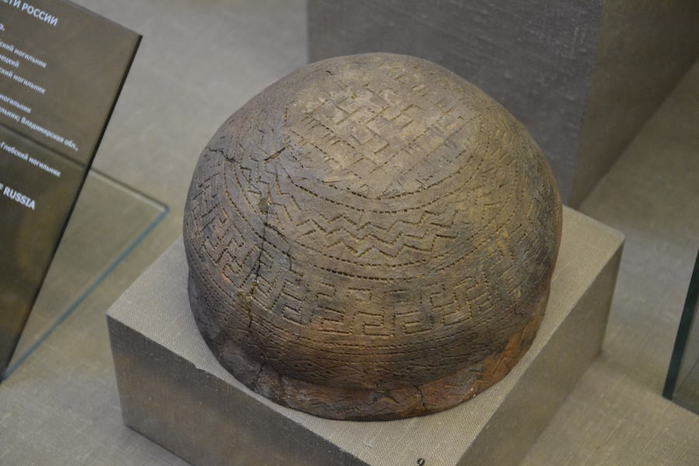
Pozdnyakovskaya culture, swastika pattern, State Historical Museum
Abashevskaya culture
By the middle of the II millennium BC. e. in the forest-steppe zope of Eastern Europe, the Abashev cultural and historical community of mainly cattle-breeding population has developed, whose monuments are now known on the territory from the left bank of the Dnieper in the west (the Desna and Seim basins) to the river. Tobol is in the east, and the chronological limits are determined by the second — third quarter of the 2nd millennium BC. e. the study of Abashevo antiquities is more than 100 years old (Pryakhin, 1981). The very same Abashev culture was first identified only after the excavations of prof. VF Smolin in 1925 of the Abashevsky burial ground in the territory of Chuvashia (Smolin, 1928; Smoline, 1927). Intensive studies of the Abashev burial grounds on the territory of Chuvashia and the Mari ASSR in the post-war decades (Merpert, 1961; Khalikov, Lebedinskaya, Gerasimova, 1966a) gradually outlined the idea of the Abashev culture in the Middle Volga region and determined the comprehension of all Abashev antiquities (Yevtyukhova, 1964; N., 1961; Khalikov, 1966).
The people of the Abashev culture are mainly engaged in cattle breeding with a subordinate importance of agriculture. The herd was dominated by cattle, with a significant role for small ruminants. The latter is especially characteristic for the early stage of development of this population and for those groups of Abashevites who continued to maintain a certain mobility at a later time. Separate groups in the late Bashevo time show a tendency towards the development of a settled cattle-breeding and agricultural economy (the emergence of significant long-term settlements, the presence of pig bones in these settlements, an increase in the number of evidence of farming, etc.) — a whole group of late Abashevo settlements in the lower reaches of the river is especially indicative. Voronezh. There are horses in the herd of this population. In the more northern regions, on the territory of the modern Mari-Chuvash Volga region, the Abashev population was more mobile and, obviously, to a greater extent engaged in pastoral cattle breeding. But I must say that in this region, and even now, people have always been mainly engaged in dairy farming, which did not make them nomads. In modern Finland, agriculture is also predominantly occupied by dairy farming, which does not make them nomads. The level of development of cattle breeding led to ample opportunities for the use of livestock by the Abashevites for transport and military purposes. The latter, in turn, not only contributed to their spread over large territories, but was also one of the conditions for the formation of a huge cultural and historical community. Here you need to understand the specifics of breeding cows and their needs, the abundance of water and grass, and besides, the cow loves to sit in the water in summer, fleeing from the gadflies. It was among the Abashevites, especially at a later stage of their development, that disc-shaped cheekpieces with thorns became widespread; the most impressive are two ornamented cheek-pieces made of ivory from the main burial of mound 2 of the Staro-Yuryevsky burial ground in the Upper Don region. Finds of this kind of cheekpieces record the first appearance of chariot transport in the Eurasian steppe and forest-steppe (Pryakhin, 1972, p. 238; 1976 a, p. 124; Cherednichenko, 1976, pp. 147 — 148; Smirnov, Kuzmina, 1977, p. 42 — 45,) The very fact of the use of disc-shaped cheekpieces in the harness of chariots found indisputable confirmation during the excavations of the Sintashta burial ground in the Trans-Urals, in whose burials it was possible to trace the very remains of this kind of chariots (Gening, 1977: 59, 66).
This population was the first on a fairly large scale to begin the development of the Ural copper deposits, especially the Trans-Ural copper deposits Tash-Kazgan and Nikolskoye using cuprous sandstones of the Urals, as well as the Volga region (Salnikov, 1962; Chernykh, 1964; 1970, pp. 27—28, 108—111, etc.). Abashevsk craftsmen developed their own form of tools, weapons and jewelry. The Abashevites know lamellar tools (knives, sickles, scrapers), which had different functional purposes, and their own types of shaft-hole axes: Kamsky, according to B.G. Tikhonov (Tikhonov, 1960, pp. 59—62), narrow-hole axes, according to E.N. Chernykh (Chernykh, 1970, p. 58, fig. 50), Abashevsky, according to S. A. Korenevsky (Korenevsky, 1973, pp. 44—47, fig. 4), flat axes-adzes, according to B. G. Tikhonov (Tikhonov, 1960, p. 66), the type of elongated adze axes with an extended heel, according to E.N. Chernykh (Chernykh, 1970, p. 62), forged spearheads with an open sleeve, several varieties of knives and daggers, etc. Abashevo craftsmen made petal-shaped rosette plaques, bracelets with open, often pointed ends, small grooved pendants, etc. Abashevo people are characterized by rich decoration of clothing, especially headdress, with small sewn semicircular plaques, wire beads and other decorations.
The very scale of development of Abashevsk metallurgy is also determined by the finds of a series of Abashevsky metal, considered in the literature under the concept of “treasure”, which geographically gravitate towards deposits in the Urals and in the Trans-Urals (Krasnoyarsk, Verkhne-Kizylsky, near Dolgaya Gora, etc.). Their finds do not cross over to the right bank of the Volga. Moreover, some of the “treasures” are hardly left directly by the Abashevo population. Some of them (Galichsky, Korshunovsky, Morozovsky) may testify not so much to the direct settlement of the Abashevites in the forest regions of the Volga region, as to the spread of the Abashevsky metal to more northern territories. This population first erected large in area two-chamber or multi-chamber, with a gable roof, slightly deepened into the mainland dwellings, and then large in area, also slightly deepened into the mainland, but already single-chamber buildings with an adjoining vestibule part.
The Abashevo population is characterized by a burial ritual under the kurgan with the construction of flattened embankments. The presence of an interval between the time of the burial and the erection of the embankment is noted. A feature of the burial rite of this population was the erection of circular (less often rectangular) extra-grave structures, limiting a significant area around one or several graves. The presence of independent rectangular pillar structures around individual burials is sometimes noted. The burial rite of the Abashev population is characterized by a cult of fire that manifests itself to varying degrees (burning of ground structures, pouring burning coal into the grave, etc.) and animal sacrifices (the position of parts or skins with head and legs). The grave pits are most often elongated rectangular, sometimes they have a wooden or stone design. The dead were laid on their backs with their legs extended or raised. The eastern and southeastern orientation of the dead is more common. The presence of dismembered, partial, i.e. repeated burials was noted. Finally, the complete absence of skeletons in a number of burial pits testifies to cenotaphs, which confirms the presence of some complex, so far incomprehensible burial traditions among the Abashevs, which also brings them closer to the Hellenic tradition. Single burials are common. But in the outlying areas, especially in the zones of contacts with foreign-cultural tribes, collective burials of the type of mass graves are not uncommon: the Pepkinsky and Staro-Ardatovsky kurgans in the Middle Volga region, the I Yukalekulevsky kurgan in Bashkiria. The most characteristic of the kurgans are stone extra-grave structures that are not characteristic of other Abashev cultures. Only here the stone was widely used in the design of grave pits. In a number of cases, powerful bonfires are noted that burned over the grave pits after the burial. More often than in other territories, the presence of partial and repeated burials is recorded. The dead were laid on their backs stretched out or with their legs raised. There is no stability in the orientation of the dead.
Among the forms of ceramics, most of all bell-shaped bowls and fewer bell-shaped pots. The bell-shaped vessels here often have a significantly lower rim height. Images of a meander and a swastika appear on the vessels. The dishes are also blackened or dairy, traditional for Indo-Europeans.
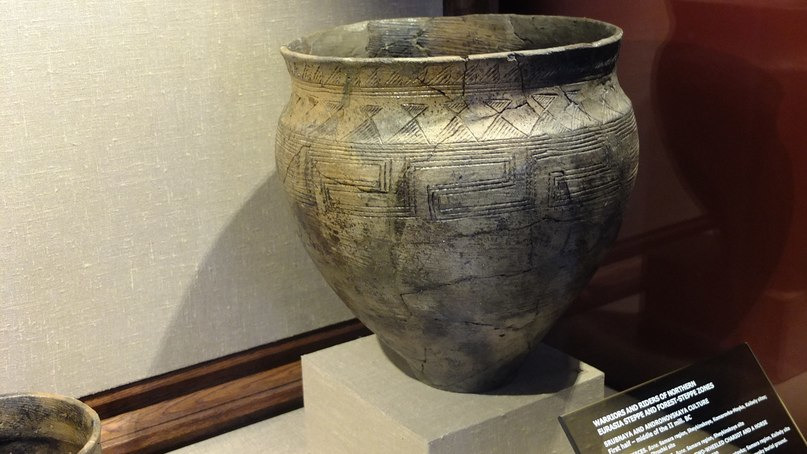
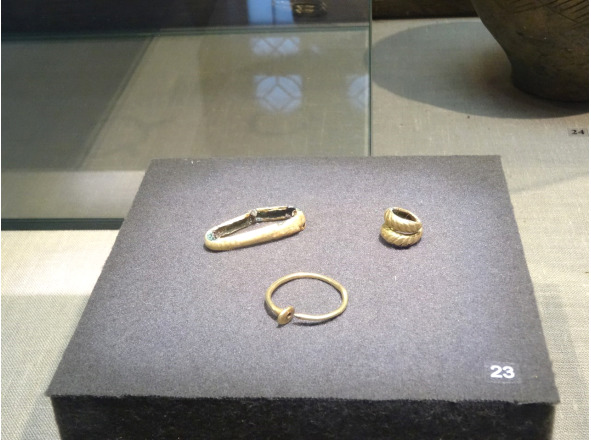
Differences are manifested even in small sharp-ribbed vessels — the presence of a direct fall in the neck region from the inside is especially indicative. In the decoration of vessels, meander and lobed patterns are much more often noted, the tradition of decorating their lower part with a vertical herringbone, etc. In the Ural territory, bracelets rounded in cross section with open blunt ends, metal onlays, and plate plaques are widespread. The bracelets are spiral, and also from the time of the catacomb culture, temporal lobed rings have been used.
Only here are multiturn small grooved pendants and metal beads known. The set of metal tools and weapons is significant. The outlined solution to the question of the origin and further fate of the Abashev population also determines the approach to clarifying the ethnos of this population. The denial of the genetic relationship with the Abashevs of the previous cultures of the forest Volga region, as well as the absence of direct inheritance of the Abashevo traits by the Finno-Ugric cultures of the early Iron Age of the Volga region, is a serious argument in favor of the denial of the Finno-Ugric ethnos of the Abashevites. At the same time, the definition of their ethnos as Indo-Iranian is becoming more and more obvious (for the first time such a point of view was expressed by A. Kh. Khalikov). This interpretation of the ethnos of the Abashevs receives additional argumentation in connection with new arguments in favor of the fact that the Abashevs, by their historical roots, development and further fate, are connected with the world of the massifs of the population of the ancient Pit, Timber and Alakul cultural and historical communities, which are now more and more definitely considered in direct connection with the problem of the early history of the Indo-Europeans, and then their group of Indo-Iranian offshoots.
Andronovo culture
Andronovo culture (cultural and historical community) is the general name for a group of closely related archaeological cultures of the Bronze Age, which covered in the 17th-9th centuries BC. e. Kazakhstan, Western Siberia, the western part of Central Asia, the Southern Urals, as well as Northwestern China, the Gansu province (article by A. Bekhter, S. Khavrin V. Steppe bronzes from the Gansu province and Xinjiang Uygur Autonomous Region of China and east sync line). The people of this culture were called, already Huns or Hans, from a totem or farn, a sacred animal, a swan. This is where the name of Ganxi Province comes from. Here it is also necessary to remember the discovery of Tarim mummies belonging to the Andronovo culture, according to the ceramics monuments. A Swedish archaeologist excavated in 1939. there are almost a dozen mummies and about 200 artifacts. Bergman left a detailed description of his findings in a work entitled “Archaeological Researches in Sinkiang Especially the Lop-nor Region” (Archaeological Research in Xinjiang, especially in the Lop-nor Region). By the early 1990s, more than 1,000 Nordic mummies had been unearthed in China’s Wapu province, but in 1998, the Chinese government banned further excavations, apparently out of concern that even more startling evidence would come to light. the presence of Caucasians in ancient China. So researchers in 1980, deep under the “sea of death”, found the mummy of a beautiful girl, nicknamed the sleeping beauty Lulan. According to scientists, the remains are 3800 years old. One of the famous Tocharian mummies, known as “the beauty of Loulan” and reconstruction. It belongs to a young Caucasian woman (180 cm tall and locks of light brown hair) and was found in 1980 in the vicinity of Loulan. Approximate age 3800 years. And what is important, the extremely high growth of the deceased — men 200cm tall, women 180cm.
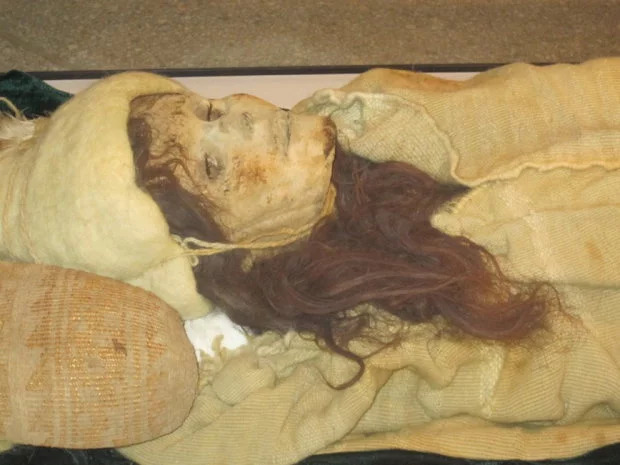
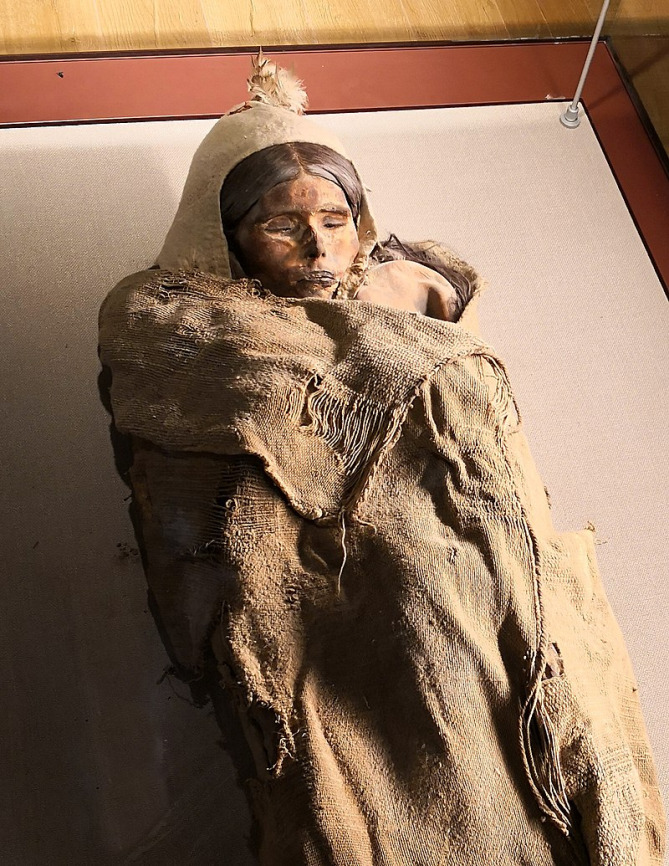
In China, obviously, the people of the Andronovo culture founded the Shang-Yin state, here the parallels in the manufacture of bronze cauldrons of the Shang-yin and later Sarmatians and Huns are extremely interesting. The Andronovites-Huns-Hans, gave the name to China and the Chinese. The self-name of the Chinese is hànzú. (Gansu). Even in the hairstyles of the Chinese-ban-fa there was a trace of the Andronov-Gans.
One of the deities of China is still called Gong-Gong, the Deity of water. The Chinese imagined him with a snake-like body and a human head. Let us recall the giants-giants of Greece, half-snakes, Erichthonia of Athens, also a half-snake. At the crown of Gong-gong there is a thick head of red hair, that is, the traditional Huns’ hairstyle is a shaved head, and the hair is only on the back of the head, and red. In myths, the main enemy of Gong-gong is Chzhuzhong, and even here the legend of the confrontation between the Gongs (Gans) and the Chou (the Chinese proper) remains.
Another interesting find of the Seima-Turbino period is a scraper knife, whose handle is parallel to the blade, that is, the blade is inserted with its lateral edge into the bone handle. The knife was found at the Weijiatai monument, Linxia county, Gansu province (Tian Yuzhan, 1983, p. 76, Debaine-Francfort 1995, fig. 49.8) The name of the whole culture comes from the village of Andronovo near the city of Achinsk, where in August 1914 A. Ya. Tugarinov discovered the first burials.
The formation and formation of the Andronov cultural and historical community took place over several centuries, starting from the turn of the III — II millennium BC. e. The Andronovo culture as a single community took shape on the territory of Kazakhstan by the 16th — 15th centuries. BC.
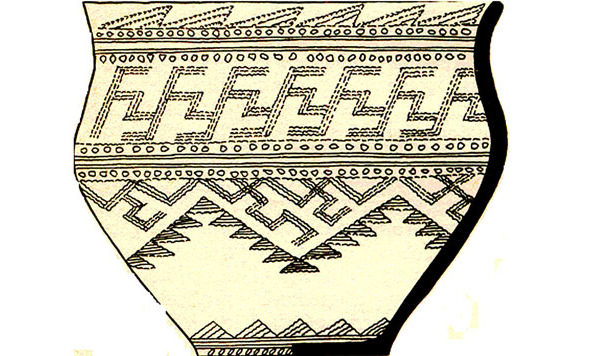
Within this unity, the Alakul and Fedorov cultures are formed. Alakulskaya spread in Central and Western Kazakhstan, and Fedorovskaya — in the territory of Eastern Kazakhstan. In Central Kazakhstan and Semirechye, signs of both cultures are found simultaneously. Subsequently, the tribes migrated from the territory of Kazakhstan to the east and south, up to Iran. M.P. Gryaznov singled out the materials of the burial grounds he studied in the basin of the river. Ural is the western version of the Andronov culture, which dates back to the XIV — XI centuries. BC e. The Andronovo culture was identified by the Soviet archaeologist S.A. Teploukhov in 1927. Research was also carried out by archaeologist K.V. Salnikov, who in 1948 proposed the first classification of the Andronov culture monuments. He identified three chronological stages: Fedorov, Alakul and Zamaraevsky.
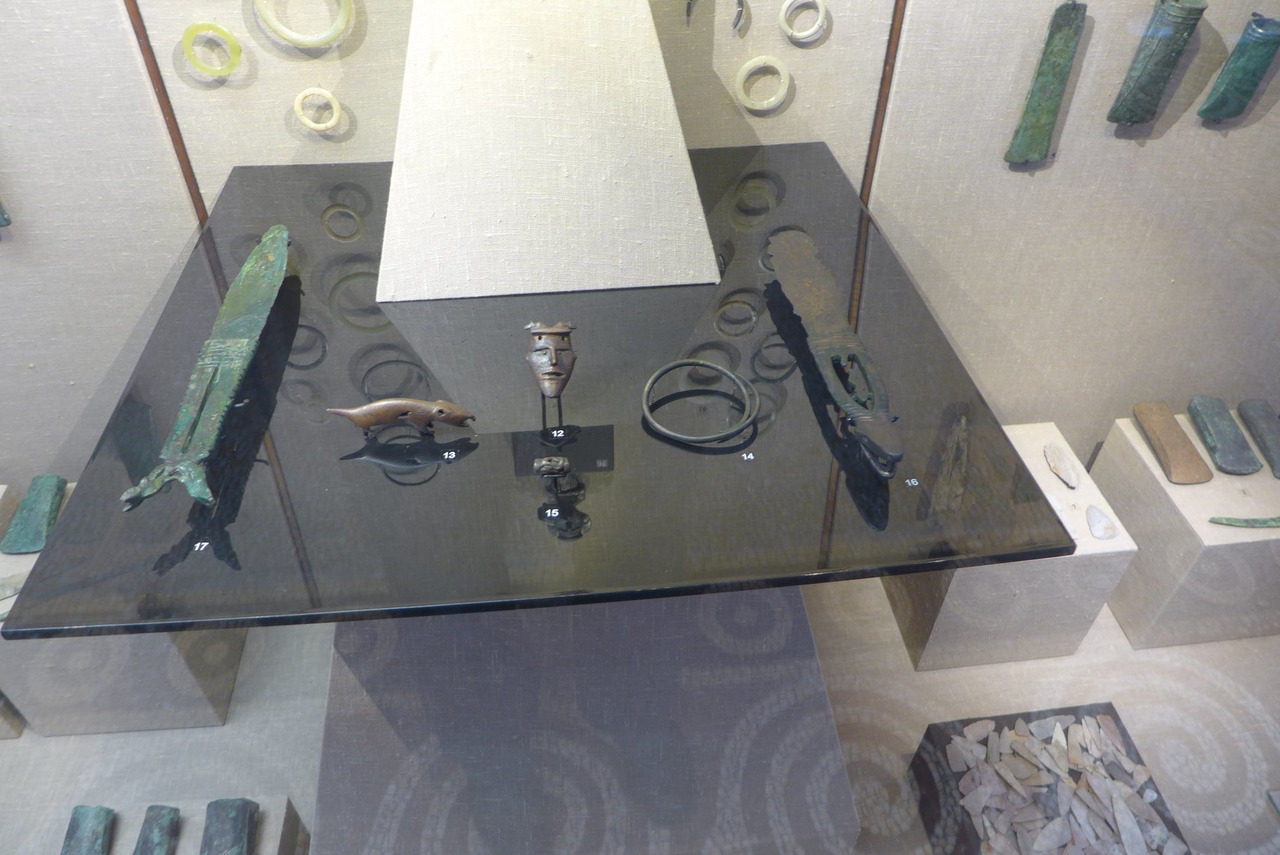
Currently, the Andronovo culture includes at least four related cultures:
Sintashta-Petrovka-Arkaim (South Urals, northern Kazakhstan, 2200—1600 BC,
— This is the fortification of Sintashta in the Chelyabinsk region, dating back to 1800 BC. e.,
— The settlement of Arkaim, also in the Chelyabinsk region, dating back to 1700 BC e.;
— Alakul (2100—1400 BC), in the area between the Amu Darya and Syr Darya rivers, Kyzyl Kum desert;
— Alekseevka (1300—1100 BC) in eastern Kazakhstan, the influence of Namazga-Tepe VI in Turkmenistan
— Ingalskaya valley in the south of the Tyumen region, in which the monuments of the Alakul, Fedorov and Sargat cultures successively replace each other
— Fyodorovo (1500—1300 BC) in Southern Siberia (for the first time there is cremation and the cult of fire);
— Beshkent region — Vakhsh (Tajikistan), 1000—800 BC e. The spread of the Andronov culture was uneven. In the west, it reached the region of the Urals and the Volga, where it came into contact with the log culture. In the east, the Andronovo culture spread to the Minusinsk depression, partially including the territory of the early Afanasyev culture. In the south, individual material monuments were found in the region of the mountain systems of the Kopetdag (Turkmenistan), Pamir (Tajikistan) and Tien Shan (Kyrgyzstan), in the area of settlement of Dravid-speaking tribes. Considering the problems of the history of the Andronovo cultural unity of metal products, N.A. Avanesova proposed the following periodization scheme: 1) pre-Alakul stage (XVII — XVI centuries BC); 2) the Andronovo culture (XVI — XII centuries BC);
— alakul stage (XV — XIV centuries BC);
— Kozhumberdinsky stage (XIV century BC);
— Fyodorov stage (XIV — XIII centuries BC);
— Zamaraevo-Begazin culture (XII — IX centuries BC) (1979, p. 20—21).
In the late 70s. OH. Margulan, without changing the sequence of genetic succession in the development of the tribes of Central Kazakhstan, proposed a new chronological framework for the stages, lengthening the Nurin stage (synchronous with Fedorov’s) from the end of the 3rd to the beginning of the 2nd millennium BC. e., almost 5 centuries; Atasu (synchronous with Alakul) until the 18th century. BC e., i.e. for 4 centuries, and the transition period to the Late Bronze to the XIII century. BC e., i.e. for one century, leaving the same dating of the Begazy-Dandybaev culture — X — VIII centuries. BC e.
The northern border of the distribution of the Andronovo culture coincides with the border of the taiga. In the Volga basin, there is a noticeable influence of the Srubna culture. Ceramics of the Fedorovo type were found in the Volgograd region. Questions of chronology and cultural affiliation of the Late Bronze Age monuments in Northern Kazakhstan were developed by S. Zdanovich, who singled out the Sargarin culture of the final stage of the Bronze Age, dating it to the X — VIII or even IX — VIII centuries. BC.
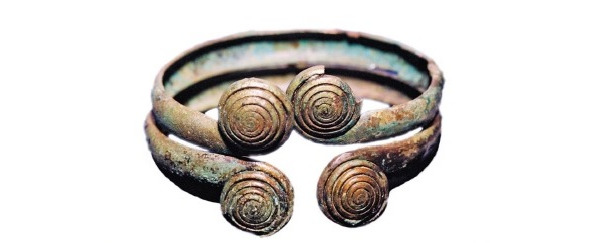
In the Siberian steppes, a single economic and cultural type of shepherds-cattle breeders and farmers developed for all Andronovites, the Andronovites lived settled in long-term semi-dugouts. Their settlements were located in river valleys rich in pastures and fertile lands suitable for agriculture. The herd was dominated by cattle, sheep, horses. The Andronovites became the first riders in the Asian steppes. Livestock was kept in pastures for most of the year under the supervision of shepherds, and in winter in special pens. Cereals were cultivated on easy-to-cultivate floodplains. The soil was cultivated by hand with stone and bronze hoes. Hunting and fishing did not have much importance in economic life. They lived poorly, settled in large families in dugouts located quite far from each other; Many times they created settlements, but chaotic, spontaneous, not having a clear plan. Settlements in the form of 10 — 20 large dwellings.
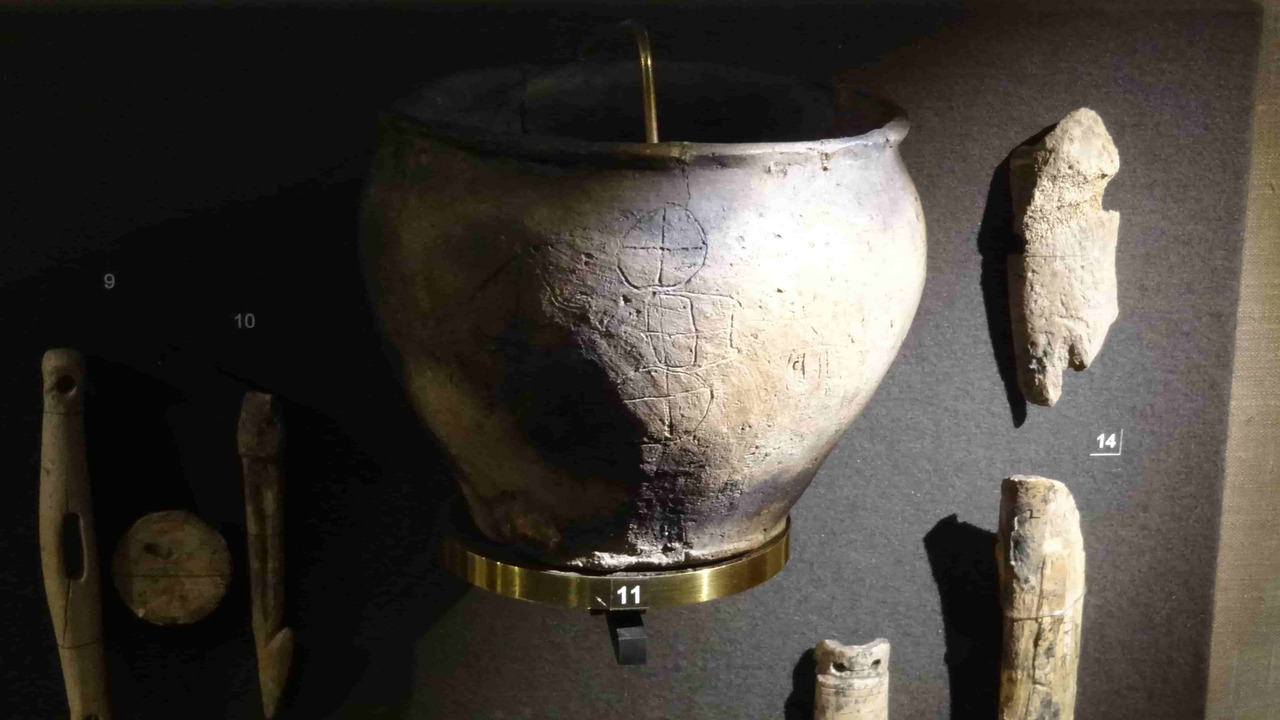
The dwellings were semi-dugouts and ground log huts. Some settlements (for example, settlements in the area of Petrovka and Bogolyubovo) were surrounded by ditches and ramparts, the land for which was taken from a fragment of the ditch. A wooden palisade was built on top of the ramparts. For passage inside, jumpers were left in the ditch, and a gate for the passage of chariots was arranged in the shaft.
Andronovtsy were the tribes of metallurgists. They possessed copper and tin mines and supplied the metal far to the west. Their foundry workers provided widespread production of tools (sickles, axes, Celts) and weapons (daggers, socketed points, spears with a leaf-shaped feather), including outside the Andronovo area. Deposits of copper ore were developed in Kazakhstan, as well as in the Altai Mountains. Burials were made in pits with stone embankments, sometimes surrounded by fences made of stone slabs. There are burials with wood cladding. The dead were laid in a crumpled position, the hands were laid in front of the face. The burials contain flint arrowheads, bronze tools and weapons, jewelry, and ceramics. The deceased was sometimes burned. Vessels with a flat bottom were decorated at the top and at the very bottom with imprints of a thin comb stamp or carved lines, often in the form of various geometric shapes — meanders, triangles, crosses, swastikas and meanders. Of the jewelry, again, spiral bracelets, temporal lobular rings, bracelets open with volute, drawing below.
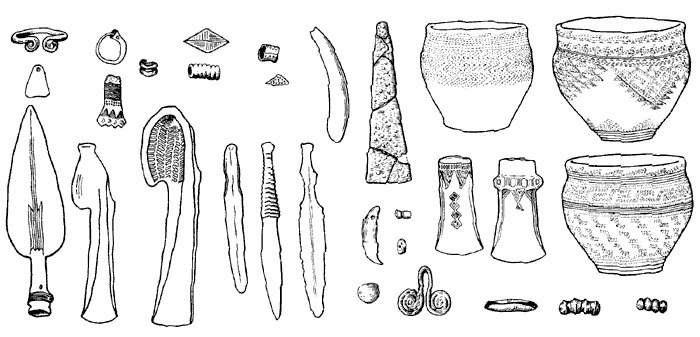
Country of Cities
The country of cities is the name of the territory in the Southern Urals, within which ancient settlements of the Sintashta culture of the Middle Bronze Age (about 3—2 thousand years BC) were found. In historical science it is called the “Volga-Ural focus of cultural genesis.” The most famous settlement of the “country of cities” is Arkaim. The settlements were discovered in the 1960s — 1980s. One of the first (in 1968) a settlement was found near the Sintashta River (a tributary of the Tobol), due to which the found settlement itself received the name of the aforementioned South Ural river. Soon after the discovery of other settlements, archaeologists began to use the term “Sintashta culture”. Probably, judging by the finds, this culture is similar, if not identical to Andronovskaya and Abashevskaya. Most cities are round in plan-8.
— round (9 cities)
— oval (about 5)
— rectangular (about 11)
The houses gathered in a circle, and a kind of reinforcement was obtained from the end walls of the houses. The settlement was surrounded by a moat and a rampart. The outer rampart and wall were made of clay and stones, with a wooden frame. The houses and walls resembled FACHWERK houses in Germany, that is, they were frame.
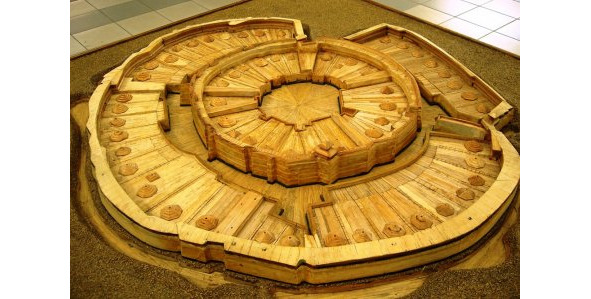
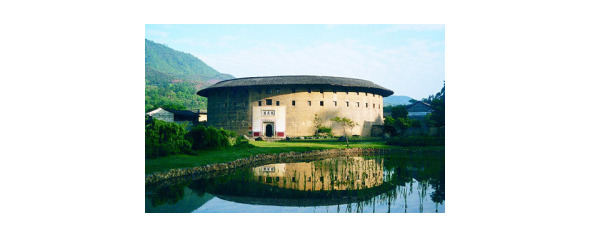
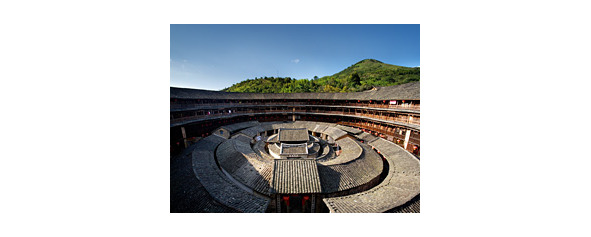
The settlements most of all resemble the so-called fortress houses of China, Tulou, pinyin Fújiàn Tǔlóu, literally “earthen [high] building”) — in Chinese architecture, a fortress-type residential complex common in the provinces of Fujian and Guangdong. There are square or round shapes. That is, the Tulou were also rectangular. The first tulou were built by representatives of the Hakka people, who, during the internecine wars, migrated from the north to the southern regions of China during the Tang Dynasty. Faced with hostile attitudes towards themselves from the local population, migrants were forced to build closed serf-type residential buildings..
Round-shaped tulou have a diameter of 50 — 90 meters, the thickness of the outer walls is from one to two and a half meters, they have narrow loopholes on the upper tiers and a minimum number of powerful entrance gates. Inside the fortress there were living quarters, a well, there were large supplies of food. In Tulou, 500—600 people can live, representing three or four branches of one clan. Tulou can accommodate 500—600 people, representing three or four branches of the same clan. For example, Chengqilou, a four-story round tulou in Gaotou Parish, Yongding County, was once home to more than 600 people from the Jiang clan. Now there are only slightly more than 60 residents (over 20 families) left, but, as they proudly note, if anyone wanted to live one day in each room of this building, it would take him almost a year.
“Tulou” can be translated as “earth castle” (tu = earth, low = building of several floors); however, both brick and stone were often used in construction (boulders in mountain districts, granite blocks in coastal areas). As a rule, a foundation was laid from stone (which made it difficult for enemies to dig during a siege) and the lower part of the wall was built, to a high enough level so that even in the highest floods, water would not erode the earthen part of the wall. The main material, however, in most cases was still a composite mixture of clay, sand and lime, laid and dried directly in the sun. As a rule, all residents of one tulou (except for wives who came to the clan from outside) had the same surname.
Probably, the culture of Northern China, the skill of building such fortress houses was brought to China by the Andronovites.
Deity of water Gong-Gong. The Chinese imagined him with a snake-like body and a human head. At the crown of Gong-gong there is a thick head of red hair, that is, the traditional Huns’ hairstyle is a shaved head, and the hair is only on the back of the head, and red. Shang-Yin ceramics has an undeniable resemblance to the Cretan one, and this is noticeable to everyone.
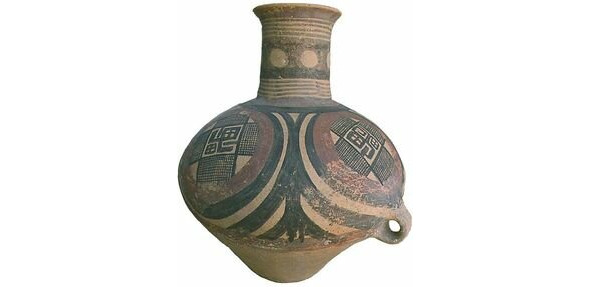
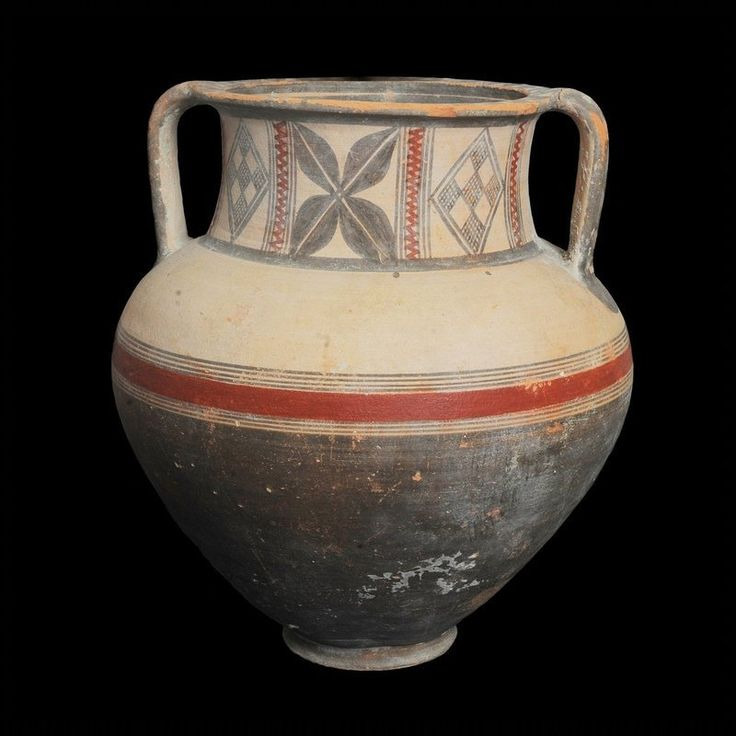
The Shang-Yin state was created by the Europeans, the Andronovites, who were called Gans, from this ethnonym the name of the Gansi province originated. The self-name of the Chinese is HUNZA (hànzú, (The Palladian transcription system is a generally accepted system of transcription of the Chinese language into Russian.), And the country is HAN.
These settlements of the Country of Cities are named:
— Arkaim — Bredinsky district (Chelyabinsk region), on the cape of the Bolshaya Karaganka river. Found in 1987 (preliminary found 1957). Shape: round.
— Fortified settlement Alandskoe — Kvarkensky district (Orenburg region), on the cape of the left bank of the Suunduk river (discovered in 1987, shape: oval, egg-shaped).
— Fortified settlement Andreevskoe — Bredinsky District (Chelyabinsk Region), on the peninsula of the left bank of the Sintashta River. Discovered in 1990 when analyzing aerial photography. Shape: rectangular.
— The fortified settlement of Bersuat — Bredinsky district (Chelyabinsk region), on the left bank of the Bersuat river, in the confluence of a small tributary of the Yagodny Dol. Discovered in 1987 (when analyzing aerial photography of perfect 1957) Shape: oval. Dimensions: 200 × 150 m.
— Fortified settlement Bakhta — Agapovsky district (Chelyabinsk region), on the left bank of the Gumbeyka river (on the cape formed by Gumbeyka and the ancient channel of the Bakhta river). Discovered in 2000 (when analyzing aerial photography made in 1955 and 1956). Shape: square. Dimensions: 165 × 165 m.
— Fortified settlement Zhurumbay — Kartalinsky district (Chelyabinsk region), on the right bank of the Karagailly-Ayat river (on the cape formed by the Karagayly-Ayat river and its tributary — the Zhurumbay stream). Discovered in 1987 when analyzing aerial photography.
— The complex of fortified settlements of Isiney — Varnensky district (Chelyabinsk region), on the right bank of the Karagailly-Ayat river. Discovered in 1991 when analyzing aerial photography.
— The fortified settlement of Kamenny Ambar (Olginskoe) — Kartalinsky district (Chelyabinsk region), on the right bank of the Karagailly-Ayat river. Discovered in 1982 when analyzing aerial photography.
— The fortified settlement of Kamysty — Northern Kazakhstan, on the left bank of the Kamysty-Ayat river. Discovered in 1991 when analyzing aerial photography. The monument is badly destroyed and is located under the outbuildings.
— Fortified settlement Kizilskoe — Kizilsky district (Chelyabinsk region), on the right bank of the Ural river. Discovered in 1968 (there is information about the discovery in 1948).
— Fortified settlement Konoplyanka — Kartalinsky District (Chelyabinsk Region), on the right bank of the Akmulla River (upper reaches of the Karagailly-Ayat River). Discovered in 1988 when analyzing aerial photography.
— Fortified settlement Kuisak, Kizilsky district (Chelyabinsk region), on the right bank of the Zingeyka river. Discovered in 1987 when analyzing aerial photography.
— Fortified settlement Paris (Astafyevskoe) Nagaybaksky district (Chelyabinsk region), on the right bank of the Kizil-Chilik river. Discovered in 2002 when analyzing aerial photography.
— The fortified settlement of Rodniki Kartalinsky District (Chelyabinsk Region), on the right bank of the Akmulla River (upper reaches of the Karataly-Ayat River). Discovered in 1987 when analyzing aerial photography.
— The fortified settlement of Sarym-Sakly — Kizilskiy district (Chelyabinsk region), on the right bank of the Zingeyka river. Discovered in 1987 when analyzing aerial photography.
— Cultural and historical complex Sintashta — Bredinsky district (Chelyabinsk region), on the left bank of the Sintashta river. Discovered in 1972 (found in 1968).
— The fortified settlement of Sintashta 2 (Levoberezhnoe) — Bredinsky district (Chelyabinsk region), on the left bank of the Sintashta river. Discovered in 1990 when analyzing aerial photography.
— The fortified settlement Stepnoye — Plastovsky district (Chelyabinsk region), on the left bank of the Uy river. Discovered in 1987 when analyzing aerial photography.
— The fortified settlement of Ustye — Varnensky district (Chelyabinsk region), on the right bank of the Nizhny Toguzak river near the mouth of the Kisinet river. Discovered in pre-2004
— Fortified settlement Chekatay — Varnensky district (Chelyabinsk region), on the eastern shore of Lake Chekatay. Discovered in 1991 when analyzing aerial photography.
— The fortified settlement of Chernorechye 3 — Troitsk district (Chelyabinsk region), discovered in 1977 on the eastern shore of Lake Chekatay.
Others:
— Nikolskaya 1
— Petrovka 2
— Bogolyubovo 1
— Streletskoe 1 Troitsky district
That is, as you can see, the settlements of the Urals of the Bronze Age, by analogy with Chinese houses, were a kind of fortress houses, maybe several floors, with a courtyard inside a fortress house.

Similar settlements were found in Rostov, this is the famous Liventsovskaya fortress, consisting of two fortress houses. The first inhabitants and builders of the settlement were tribes of the Yamna and catacomb culture of the Don, the military defensive structure dates back to the 17th century BC. The length of the foundation of the Liventsovskaya fortress along the perimeter today reaches 280 meters, and the area of the Karataevskaya fortress is more than 425 square meters. As you can see, this fortress resembles the fortresses of the Country of Cities and the Tulou houses of China.
Weapons, decorations
The horse was a common and important character among the decorations characteristic of bronze combat knives. A stocky horse with a thick mane, large head and sensitively alert ears froze on the top of a crooked knife. A short man grasped the reins tightly and glides on widely spaced skis. This, already famous, sculptural group from the Rostovka burial ground points to one of the most ancient ways of man’s movement in tow after a fast-jumping animal.
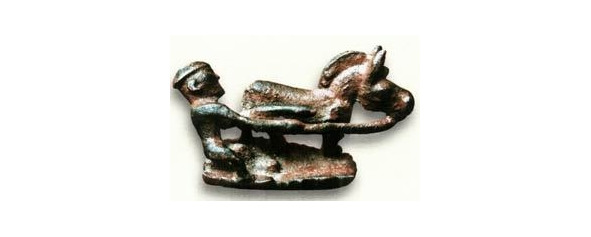
Elk was also a domestic animal in Siberia. It is known that, until recently, sled and draft moose were widely used in northern Europe. Moreover, it is difficult to say who — an elk or a deer — was tamed before. So, back in the XV century. The moose was a riding animal in the Swedish army, and an engraving from the book of O. Mangus in 1555 depicts an elk carrying a sled with riders. Russian and Soviet zoologist, academician N.M. Kulagin wrote that “according to old legends, moose were allegedly used in Sweden for riding, as if riding on them was so fast that the police had to prohibit the use of moose in order to prevent criminals from hiding from persecution with the help of swift moose”; He also points out that moose in captivity in a stall, if not driven and not allowed to run, die after 2 years, and when used under saddle and harness live up to 35 years. In the 18th century. Swedish couriers used to ride moose in a sleigh, and in the Baltics from the time of Peter the Great, a decree has been preserved prohibiting “moose riding in the city”.
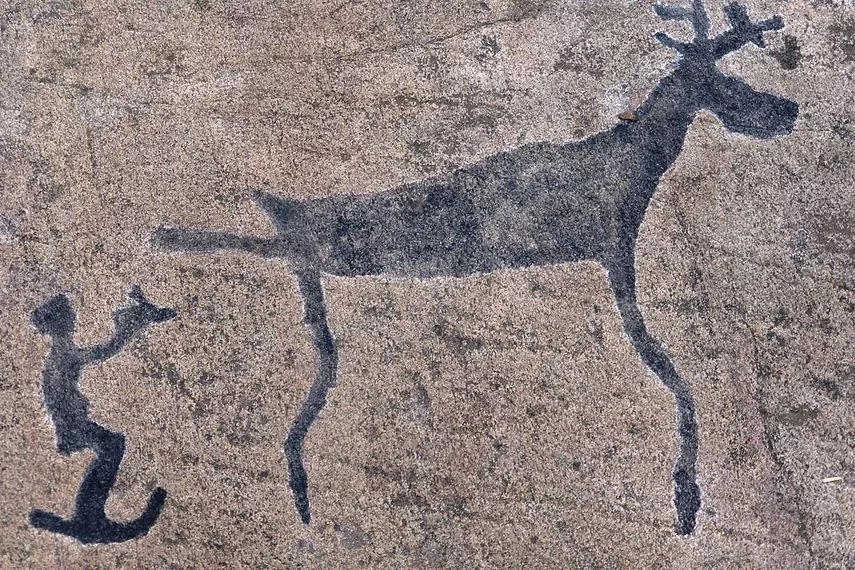
That is, earlier people as mounts, in the Bronze Age and later used the moose as draft and riding animal. An elk is much larger than a horse, and even a deer, but it does not tolerate heat at all.
Genetic studies of the remains of the Andronovites showed the presence of Y-chromosomal haplogroup R1a1, R1b M73, Q1a and Y-chromosomal haplogroup C (prd M48) and mitochondrial haplogroups U, Z, T, H, K and HV in representatives of the culture. In one 2015 study, the Y-chromosomal haplogroup R1a1a1b2a2-Z2124 and the mitochondrial haplogroup U2 were found, in another 2015 study, the mitochondrial haplogroup A10 * was found in a representative of the Fedorov culture (Tartas-1). The closest to the Andronovites were the representatives of the European Corded Ware culture and the Sintashta culture, as well as modern Indian populations, according to the study by Keyser C. et al. “Ancient DNA provides new insights into the history of south Siberian Kurgan people.”
What did all these peoples call themselves? I would venture to suggest that the Huns or the Ghans, or rather, the Hans, and this is confirmed by the myth of the Gannimede of Asia Minor. Tsar Hunei from Thessaly, as well as the names of the mounds in Russia and Germany, and in Russia it literally means “KUR-GAN” — “the possession of the Gans”, kur-possession, then the Cossack kuren, and the name of the city of Kursk. And in Germany there are also such “Hünegrab” — “grave of the hun (giant)” and “Hünebett” — “bed of the hun (giant)”. In Dutch also — Hunebed — a giant’s bed. It is very likely that it was at this time, and these peoples. Judging by the legends of the Narts and the legends of the Egyptians, the Huns-Hans were the mysterious Hyksos-kings-shepherds, because the cities founded by these tribes in the Nile Delta were named in honor of the distant ancestral homeland — Tanais (Tanis) and Avaris, and here on the historical stage The Uary-Avars, who became the ancestors of the present Avars, came out.
So fortified cities, boat-shaped buckets, axes with bushings of a certain type, meander, swastika, cross, and temporal lobular rings, as well as blackened dishes, ornaments in the form of volutes are all signs of Indo-Europeans who began their migration to the West, East and South from their homeland, Ob and Urals.
Asuras and Vainaras
Asuras in Hinduism are deities of low rank, sometimes called demons, titans, demigods, anti-gods, giants. This is due to the fact that the asuras are in binary opposition to the suras, the gods of Hinduism, similar to the opposition “gods-titans” or “gods-giants” in ancient Greek mythology. In Zoroastrianism, the opposite is true. Asuras there are declared gods, devas — demons.
In the Vedic period, the word “asura” most likely meant “possessing vitality” (to the word asu (“vital force”), M. Mayrhofer etymology). In the Rig Veda, many gods are called asuras — Savitara, Agni, Mitra, Varuna, Surya and others. Asuras are mentioned mainly in the Puranas, they are actively trying to overthrow Indra from the throne and expel the gods from Paradise. Vishnu, Shiva, Shakti and Kartik help the Virgos defeat the Asuras. However, even among the asuras there are positive characters, for example, the King of Bali mentioned in the Puranas.
Thus, the main difference between the asuras and the Rakshasas is that the asuras challenge the dominion of Vishnu, Shiva and Brahma and try to take over them.
Most asuras also have superpowers, which they can develop through performing spiritual practices dedicated to Trimurti, especially Brahma.
In the Ramayana it is also described that the Rakshasas received their bodies as a result of a curse, which can only be overcome by accepting death from one of the Vishnu avatars.
The division of deities into two rival camps is also characteristic of the Avestan religion, where there is an inversion in relation to Hinduism, and “ahura” in the name of the supreme deity Ahura-Mazda, apparently, is a variant of the word “asura”.
Varuna is one of the names of Ahura Mazda in Zoroastrianism. Also Krishna in the Bhagavad-gita says: “I am Varuna.”
Ramayana is an ancient Indian epic in Sanskrit, the author of which in the tradition of Hinduism is considered to be the legendary sage Valmiki, whose name is mentioned in Vedic literature as one of the teachers of Taittiriya-Pratisakhya. It is one of the most important sacred texts of Hinduism in the smriti canon.
…The Vanar are very strong warriors, and in war they usually uproot a tree and use it as a weapon against enemies. according to the Ramayana, the Vanaras are brave, curious, somewhat irritable, active, adventurous, very loyal and honest. Their appearance is characterized by somewhat smaller stature than humans, as well as thin fur covering the body. The most famous Vanaras are: Hanuman, the leader of the Vanaras Sugriva, brother of Sugriva Bali, Angada, Nila and Nala.
Ramayana, in contrast to the “Mahabharata”, to which the epithets of itihasa (legend, saga) and purana (epithets) are attached, Ramayana refers to kavya, that is, to artificial poems. It is usually assumed that the Ramayana plot has an allegorical character and depicts under the guise of Rama’s exploits the spread of Indo-Aryan tribes to the south of India to the island of Sri Lanka; but there is nothing improbable in the suggestion that some ancient myth was put at the basis of this allegorical legend. The word Sri-means sacred, it is often an epithet that refers to Rama and other heroes of the Ramayana — Sri Rama, for example.
The Ramayana shows the conflict between the Asuras and the Vanaras, and this conflict is shown in Indo-European myths more than once, for example, and in the Scandinavian myths the Vanis and the Ases also conflict.
Asy (Old Scandalous noun áss (ǫ́ss, ás), plural æsir; plural ásynja, plural ásynjur) — in German-Scandinavian mythology the main group of gods. The supreme god and leader of the Aesir is Odin.
Saxon Grammar calls asdings Danes. According to legends, the Aesir live in Asgard, the city of the Aesir gods located in the sky.
The Vans (Old Scandal. Vanir) are a group of gods in Germanic-Scandinavian mythology, whose clan gave way to the cult of the Aesir (Aisir), with whom they either enmity or enter into an alliance. As you can see, in the Scandinavian spelling vanir is identical to the Indian vanar. The war of the Aesir and the Vanir is one of the key events in Scandinavian mythology, an armed conflict between the groups of the gods of the Aesir and the Vanir.
The war began due to the murder of the sorceress Gullveig by the Aesir, created by the Vans from gold and sent to Midgard (lands inhabited by people) to spoil the customs of its inhabitants (since the Vans were unhappy with the fact that people glorify only Ases). The Vans laid siege to Asgard, and the Aesir King Odin, who threw his spear at the Vans, began the battle. During the war, the Vanir destroyed the walls of Asgard, but in the street battles the Aesir began to gain the upper hand. As a result, a peace treaty was concluded between the Aesir and the Vanir and an exchange of hostages was carried out: Mimir and Hoenir went to the Vanir, and Nyord went to the Aesir, followed by his children, Freyr and Freya. This war, according to Scandinavian mythology, marked the end of a golden age. Asdings are Danes, Vans are Vends. The 19th century Slavist P. Shafarik brought the name of the Vanir closer to the ethnonym Wends (Fin. Venäläinen “Russians”), as well as the toponym Vantit. A similar conflict took place in the Caucasus, between the Aysors (Assyrians) and the Vani (Urartu). It is very likely that, judging by toponymy, the Urartians were called Vans (Lake Van of this region)
So we see that the Ases and Vans have spread around the world from India to the Caucasus and to Scandinavia itself. And it turned out, as in the proverb “And together it is cramped, and apart it is unbearable”
Three paths of the Indo-Europeans — West, East, and South
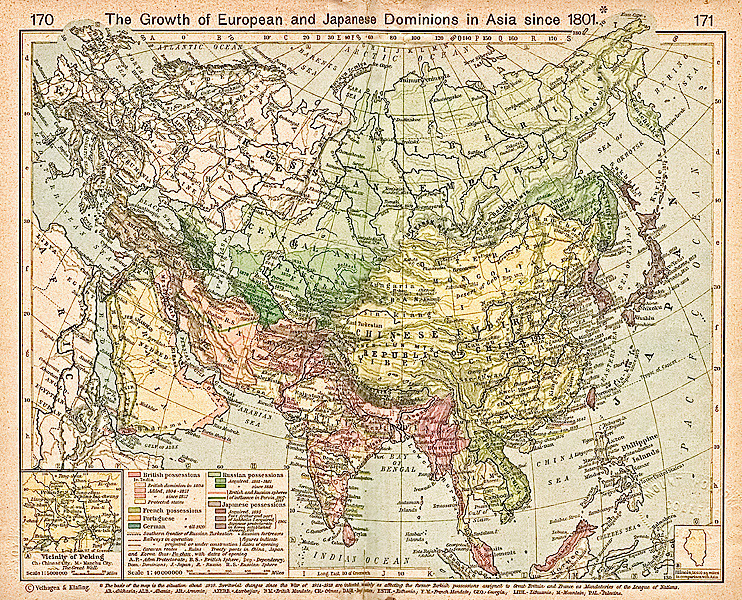
India
Migration to India from Semirechye is possible through the Hindu Kush in Afghanistan, and inevitably wanderers end up in the North of India. To get to the Indian subcontinent, you don’t need to go through the Iranian plateau. You can recall the path of Alexander the Great, who went to India through Bactria, and came exactly to Gandhara.
Ganesha, or Ganapati (Skt. Gaṇeśa)) in Hinduism is the god of wisdom and prosperity. This is one of the most famous and revered gods of the Hindu pantheon. The respectful prefix Sri is often added before his name. One of the popular ways of worshiping Ganesha is chanting Ganesha-sahasranama, “a thousand names of Ganesha”), Brother of Ganesha — Skanda (Kartikeya, Murugan). In the northern part of India, it is believed that the eldest of the brothers is Skanda. In the southern part, the primacy of birth is attributed to Ganesha. Skanda was revered as an important warlike deity from the 5th century BC. e. to VI century AD e. Mass worship of Ganesha began after the decline of the Skanda cult. Ganesha is also the ruler of the Ghana (Shiva’s army-retinue). There is a legend that Ganesha and Skanda (both sons of Shiva) fought for this post, and as a result, Shiva decided that he would be the ruler of the Ghans, who would quickly run around the Galaxy. Skanda immediately jumped off and began his long journey, and Ganesha slowly walked around his parents in a circle, because it was Shiva and Parvati who were the personification of the Galaxy. And after that, Ganesha received the nickname “Ganapati” (lord of the Ghana). And here is the name of SCANDA. As you know, many tribes took their ancestral home from the island of Scandia. Gandhara (also Gandara, Ghandara, Chandhara, Ganghar,) is the northwestern region of Greater India and the name of an ancient kingdom stretching from Pakistan to the eastern provinces of Iran. Gandhara is concentrated around the southern part of the Kabul river valley. In the east, it extends beyond the Indy River and includes the border areas of the Kashmir valley. The historical capital, the city of Taxila, is named after the rajah who fought in alliance with Alexander the Great. The extreme northwestern province of Hindustan (now on the border of Afghanistan with Pakistan) was called Gandharva. Now the sound has changed: Kandahar. The name comes from “the country of Gants, Gant-gar, or now Kandahar, which also translates as the country of Gants, Shiva’s warriors).
The name of the Gandhari is found in the Rigvedea in the Atharvaveda. Gandhars are mentioned in the section of Uttarapathai’s puranas in Buddhist sources. Aytareya Brahmana speaks of the Gandhara king Naganajita, a contemporary of King Janaka of Videha. According to the Mahabharata, the Gandharians took the sides of the Kauravas against the Pandavas in the war and were at the same time brave and sophisticated warriors. In Gandhara, the influence of the culture of the south of Central Asia of the Bronze Age and the Gandhara cave culture, most likely corresponding to the migration of Indo-Aryans to the centers of the Vedic civilization, is traced. The Gandhara culture, or the Gandharian burial culture, or the Swat Valley Culture, or the Swat culture existed in the period 1600—500. BC. in the Gandhara district of Pakistan. Finds related to this culture have been found mainly in burials located along the banks of the Swat and Dir rivers in the north, Taxila in the southeast and Gomal in the south. The found pottery reveals a clear similarity with finds from the same period from Central Asia (Margian civilization) and the Iranian plateau. Archaeological cultures commonly associated with the migration of Indo-Iranian peoples (according to the Encyclopedia of Indo-European Cultures). Most often, the Andronovo, Margian and Yaz cultures are associated with these peoples. And here, in the myths of India, there is a name-Ganta, attributed to the Andronovites Huns (Hans), and is confirmed by gray (Minyan) ceramics.
Vedic literature is characterized by the use of ārya- as a common ethnonym for all Aryan tribes who professed the Vedic religion and opposed to anārya- “non-Aryan”, dasyu-, dasa “enemies-aborigines” (das), mleccha- “barbarian”. In the meaning of “noble”, he united three “twice-born” varnas (brahmanas, kshatriyas and vaisyas), opposed to the sudras as varna of non-Aryan origin. In the meaning of “people” they designated mainly the vaisyas (that is, “common people”) in contrast to the brahmanas and kshatriyas. That is, the actual Aryans, who came to India from China, lived south of the Ganta Gandhara. But numerically, the arty prevailed, but the gants managed to retain their distinctiveness. Ganty are Vaisnavas, and aryas are Saivists, and even their tilaka is different.
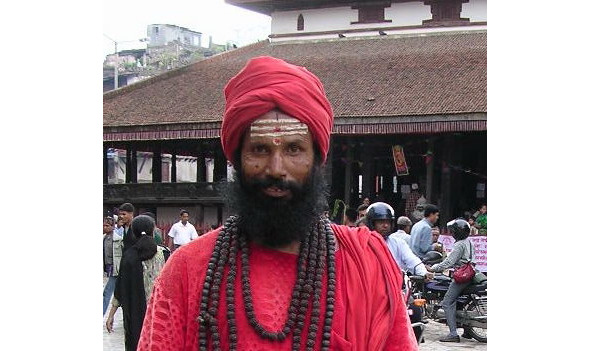
In the Rig Veda, the ethnonym is mentioned 36 times in 34 hymns. The Aryan world in the Rig Veda includes primarily Sapta Sindhavaḥ (Semirechye, Punjab rivers) and unites 5 large tribes: Anu, Druhyu, Yadu, Turvaśa and Pūru. In the era of the later Vedas, the center of the Indo-Aryans shifted to the east, to present-day Haryana, where the Bhārata tribe rises. The meaning of the word ārya- is increasingly associated with the Vedic religious cult, the concept of vratya- (“apostates”) appears — groups of people of Aryan origin who do not adhere to all the precepts of the Vedas. The tribal names will then be extremely important in the future. And here is the union of SEVEN tribes, no more and no less. Anu, Druhyu, Yadu, Turvaśa and Pūru. Also mentioned are the Bharat and Tritsu tribes. Perhaps this is all seven tribes. India’s official name is now BHARAT.
It is in India that one of the symbols that scientists do not want to see, Urdhva-Pundra, remained. In the Vaishnava tradition, tilaka is called urdhva-pundra. Tila — a small dot that is placed on the forehead — literally means “sesame, sesame.”
“An intelligent person who daily wears the twelve signs of tilaka on his body knows what is religion, dharma, and what is godlessness, adharma. He understands the difference between religious and non-religious principles. One who sees the difference between religious and non-religious principles is called a Vaisnava.”

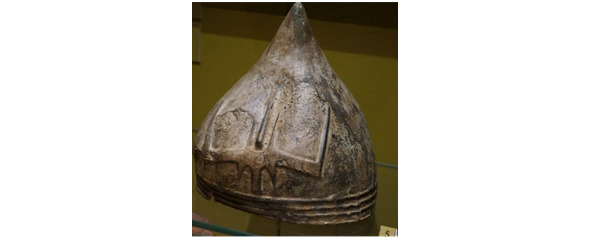
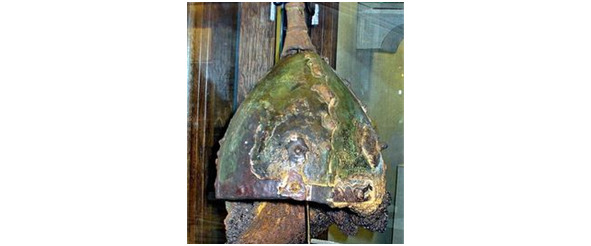
In the Brahmanda Purana it is said, “If a person is impure, lacks proper etiquette, or commits sins in his mind, he always remains pure if he wears tilaka.” The Supreme Lord further states: “Even if a person who adorns his body with tilaka is born in a dog-eating family or leaves his material body in a place other than a holy place, he will go on a heavenly ship to My transcendental abode, where he will enjoy eternal blissful life.” bhakti-vilasa, 4.202).
The tale of Ali Baba was very popular in Europe already in the 18th century. The earliest version of the tale “Ali Baba and the Forty Thieves” is found in the French translation of Galland, who was accused of falsification before the discovery of the original of the tale in Arabic at the beginning of the 20th century. After the death of the merchant, his eldest son Kasim inherits his business and, having married a wealthy woman, succeeds. The youngest son of Ali Baba marries a poor girl and becomes a beggar lumberjack. (A lumberjack in Baghdad is something already. Where is the forest there? This speaks of a borrowed plot, most likely of a more northern origin) Once, collecting brushwood in the forest, Ali Baba accidentally witnesses the conversation of forty robbers. The entrance to the cave, where the looted treasures are kept, is opened with the help of the magic words “Simsim, open” (in the classic translation of Mikhail Salie — “Sesame, open your door”). Having learned this secret, Ali Baba, after the bandits left, enters the cave and takes with him a bag of gold coins.
Mardjana is also mentioned in the tale, probably Margiana. That is, in the original, the action may be tied to Central Asia. Kasim enters the cave, but the robbers kill him.
So SESAME. Tilaka or tilak (tilaka IAST) is a sacred sign that the followers of Hinduism apply with clay, ash, sandalwood paste or other substance on the forehead and other parts of the body. The types of tilaka differ among followers of different directions of Hinduism and, among other things, serve as an identification mark, speaking of belonging to one or another religious tradition. Tilaka can be applied daily or only on special occasions.
“Urdhva” means “up” and “pundra” means “light”, therefore, applying tilak is a way to remind, first of all, to oneself, about one’s values and goals. In the Vaishnava tradition, tilaka is called urdhva-pundra. Tila — a small dot that is placed on the forehead — literally means “sesame, sesame.” here there is an association with the tale of Ali Baba and 40 robbers. The tale shows the philosophical overtones of the sesame, the password for entering the cave with riches is only possible for the bearer of Tilaki. There is Tilaka on your forehead — you will enter the Kingdom of Heaven, there is no Tilaka or you have forgotten about it, its true meaning — the passage to the Golden Kingdom is closed for you).
Iran
It must be remembered that “Aryans” is a self-name and scientific designation only for Indo-Iranian peoples. Arians (Avest. Airya-, Old-Ind. Ā́rya-, Old Persian ariya-) or Aryans (also Indo-Iranians) — the name of the peoples speaking the languages of the Aryan (Indo-Iranian) group of the Indo-European family, derived from the self-name of the historical peoples of the Ancient Iran and Ancient India (II — I millennium BC). The linguistic and cultural affinity of these peoples makes researchers assume the existence of an original Pra-Aryan community (ancient Aryans), the descendants of which are the historical and modern Iranian and Indo-Aryan peoples.
But, as you can see, the Aryans are at some distance from the Andronovites-gans (gants). Those who came to China, India, and reached Europe. Toponymy with word formation from the ethnonym Aryan in Europe is vanishingly small, as is the mention of the Aryans in the form of forefathers, ancestor spirits. In Europe, in the form of forefathers, spirits, only manna and huns are present.
In linguistics, the Aryans (or Indo-Iranians) mean only two groups of Indo-Europeans: all peoples speaking the languages of the Indo-Aryan group, and all Iranian-speaking peoples. The ancestral home of the Aryans, according to some assumptions, was located between the Dniester and Ural rivers (Yamnaya culture).
The Iranian group of peoples includes modern Ossetians, Persians, Tajiks, Afghans, Kurds, Baluchis and some other peoples. All of them speak languages derived from the common Iranian language-base, which in the II millennium BC. spoke the Iranian Aryans.
At the end of the 2nd millennium BC. the Iranian community split into two groups of tribes. Northern Iranians included the ancestors of the Scythians, Sogdians, Bactrians, Khorezmians. The southern group of tribes included the ancestors of the Medes, Persians, Kurds, Baluchis, and other Iranian peoples. This group of tribes can be called southern because they left the European ancestral home to the south and occupied the Iranian Highlands, that is, the territory of the modern states of Iran and Afghanistan. But the northern Iranians also went far beyond the boundaries of the Aryan ancestral home. The Bactrians, Sogdians, Khorezmians advanced to Central Asia.
Vedic literature is characterized by the use of ārya- as a common ethnonym for all Aryan tribes who professed the Vedic religion and opposed to anārya- “non-Aryan”, dasyu-, dasa “enemies-aborigines” (das), mleccha- “barbarian”. In the meaning of “noble”, he united three “twice-born” varnas (brahmanas, kshatriyas and vaisyas), opposed to the sudras as varna of non-Aryan origin. In the meaning of “people” they designated mainly the vaisyas (that is, “common people”) in contrast to the brahmanas and kshatriyas.
In the Rig Veda, the ethnonym is mentioned 36 times in 34 hymns. The Aryan world in the Rig Veda includes primarily Sapta Sindhavaḥ (Semirechye, Punjab rivers) and unites 5 large tribes: Anu, Druhyu, Yadu, Turvaśa and Pūru. In the era of the later Vedas, the center of the Indo-Aryans shifted to the east, to present-day Haryana, where the Bhārata tribe rises. The meaning of the word ārya- is increasingly associated with the Vedic religious cult, the concept of vratya- (“apostates”) appears — groups of people of Aryan origin who do not adhere to all the precepts of the Vedas. The tribal names will then be extremely important in the future. And here is the union of SEVEN tribes, no more and no less. Anu, Druhyu, Yadu, Turvaśa and Pūru. Also mentioned are the Bharat and Tritsu tribes. Perhaps this is all seven tribes. Yadu, Yada is also mentioned much later, in Chinese sources, both Hephthalite Huns and Sakas were called so.
Takhir and Zuhra
One of the tales that have come down to our time, Takhir and Zuhra, is very similar in plot to the myths of Dionysus. Takhir, like Dionysus, Perseus and Guidon, is thrown into the river (not the sea. There are no seas in Central Asia), and the barrel is washed ashore, where Zukhra saves him.
Shukra is Venus in the representation of the Hindus. Shukra (Śukra IAST “clear, pure, white”) or Shukracharya is the son of Bhrigu in Hinduism, the teacher of the Daityas and the guru of the asuras, who has the knowledge of the resurrection of the dead. As you can see, Zukhra reminds Elena the Beautiful of Russian fairy tales, Elena the Beautiful Hellas. After all, Elena literally from Greek is a light. Yes, and Aphrodite herself or Venus. The name Takhir is undoubtedly identical to the name of Targitai of the Scythians and Tarh of the Rus, Tarhunt — “thunder and lightning”, Tarhunt (Tarhun) — the Hittite god of thunder, the Etruscans also had the legendary first king Tarhunt or Tarhont.
That is, earlier, the Aryans of Iran constituted a cultural community with other tribes of Indo-Europeans.
Hyksos. The Andronovites reach Egypt. Three horses harnessed to chariots
The Hyksos is a union of tribes, according to legends, which conquered Egypt in the 2nd quarter of the 2nd millennium BC.
According to the Greek-language “Egyptian History” of the Egyptian priest Manetho (III century BC), the Asian people of “unknown origin” invaded Egypt and under the leadership of their leaders, who fortified in the eastern part of the Delta in the city of Avaris (Egyptian Hat-Uar or Hut -Uaret), for a long time held power over the Egyptians, cruelly oppressing them; however, after a long war, the Hyksos were expelled from Egypt by the local rulers of Thebes, who reunited the country under their rule and restored its independence (Manetho. Fr. 42—52). According to Manetho, the Egyptians called the conquerors a phrase meaning “shepherd kings” and sounds in Greek transcription like the Hyksos (ὑκσώς).
The Hyksos invaded with chariots, armor, bronze weapons, and compound bows. It was from the Hyksos that the Egyptians borrowed such inventions as the war chariot and the composite bow, which was distinguished by a greater range. It is believed that a Hyksos chariot drawn by two or three armored horses usually had two warriors. One of them, a charioteer, drove a team and held a small shield in his hand, protecting himself and the archer standing next to enemy arrows and javelins. The archer, on the other hand, was dressed in a helmet and scaled or plate armor made of bronze. His neck was securely covered by a strong wide collar. In case of close combat, the archer and the driver had swords. But in the Homeric tradition of Homer’s Iliad, and according to the image on the stele from Mycenae, the chariot’s main weapon was the longest peak.
However, judging by the well-known episode of the battle of Ramses II with the Hittites: “And there were three of them (enemies) per chariot,” and with him (Ramses II) there was not even “neither a marianne (charioteer) nor a shield-bearer” — the crew of the Hittite chariot consisted of three people. In the legend about Karatu, who besieged (Post-Hyksos period) Udm (Edom) the Great, the capital of the kingdom of the Hurrians, the father of the Hurrian maiden, the king, wishing to pay off, suggests: “Take silver and gold, as much gold as you want; take three horses and a chariot” … Karath needs a wife, and he rejects the offer: “Why do I need… a chariot with three yokes, well fitted.” Consequently, three horses were also harnessed to a Hurrian chariot (possibly a royal one). And here an interesting detail opens up — troikas harnessed to carts. The author knows of no other triplets in antiquity, except in Russia.
“No, — so that no one, on the art of driving and on strength,
Before others, I didn’t blaze in front with sopostatami to beat or turn back: you will weaken yourself.
Who, in his chariot, will come to another chariot, with a lance ahead: the best way for horsemen.
Doing so, both ancient walls and hailstones were smashed,
keeping the mind and spirit in the valiant Persians “Iliad, Homer
But all the same, the battle was fought by chariot fighters with shock long spears, in the manner of medieval knights. The formation of the chariot fighters was relatively free, linear, for possible maneuver. The goal was to knock an enemy soldier off the chariot, and the spear had to break, otherwise the impulse would have thrown the warrior out of the chariot. In the event of an attack by the chariot fighters of the enemy infantry, the maneuver was even more difficult. The chariot was supposed to attack the infantry not head-on, into the front, but at an acute angle — that is, the driver ruled along the enemy formation, and the warrior smashed the infantry with a heavy spear. If the chariot fighter used a ramming blow, then the spear broke, and the warrior used a spare. Horses, unlike war elephants, cannot push through infantry. Therefore, chariots cannot and could not break through the infantry formation, they only inflicted huge damage on the infantry, remaining invulnerable. Later, the Klibanarii acted in the same way against the infantry — they drove up to the ranks, struck a terrible blow with a spear, and drove away, remaining invulnerable. Moreover, the rider’s spear must break, otherwise he could fly out of the saddle. The union of the Hyksos tribes included the Danaans, as the Hellenic myths say. They say that Danai and Egypt were brothers, Danai ruled Libya, and Egypt ruled Egypt, that is, the Danai ruled northern Egypt, such data remained in Greek myths. Having quarreled, Egypt expelled Danae and his daughters from Egypt, and they settled in the Peloponnese. The names of the cities of the Hyksos, Tanais and Avaris, are also important, obviously from the names of the tribesmen (Varov-Avars and Danes-Danai). In Greek sources, there is also the leader Hunei, who remained in Egypt after the Trojan War.
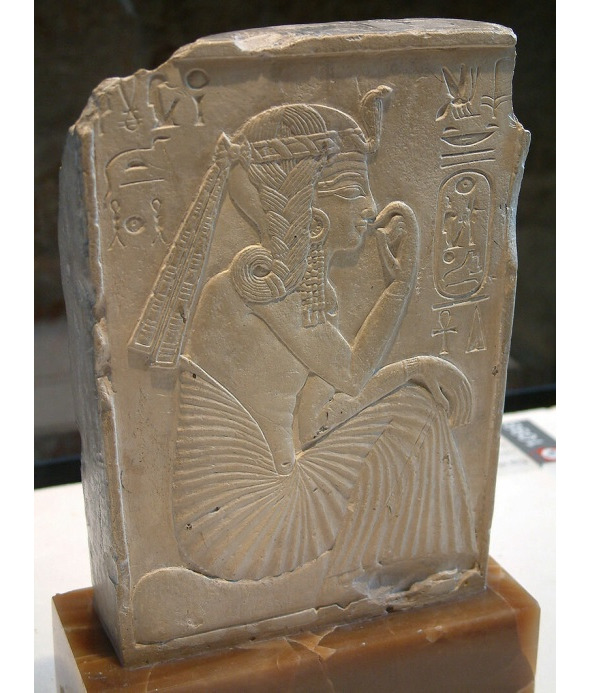
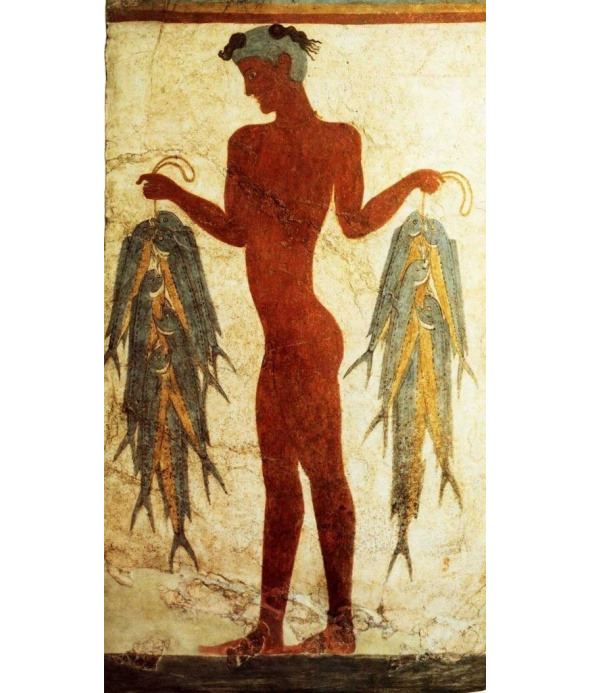
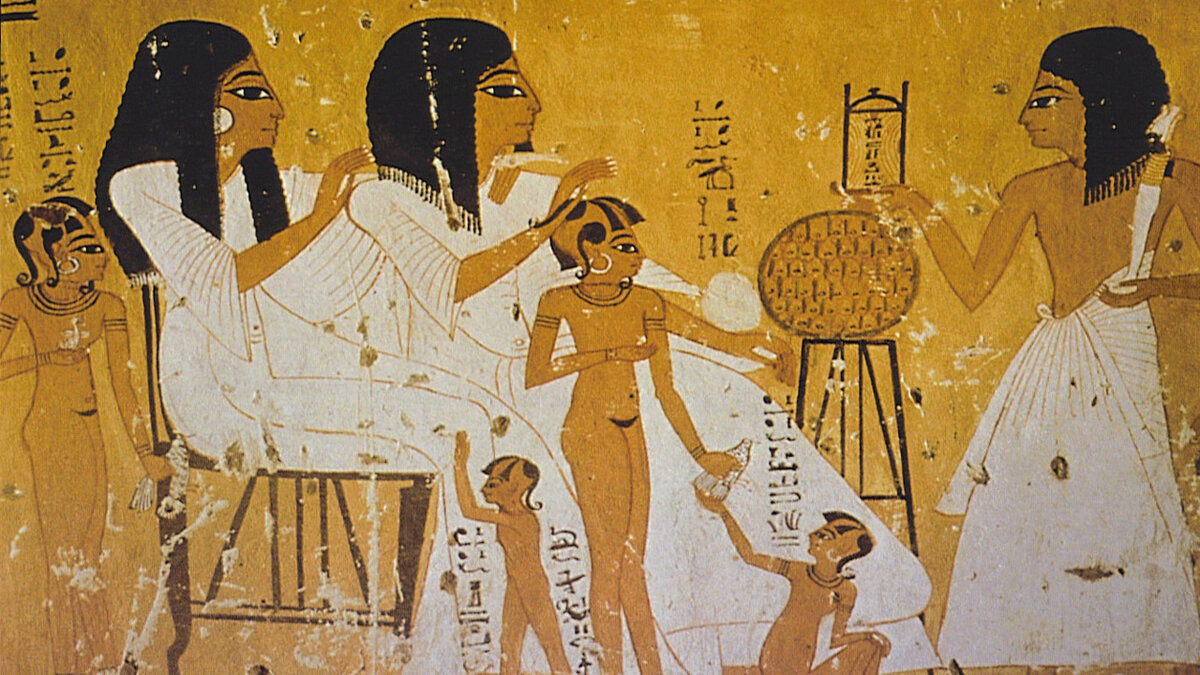
That is, as you can see, the Huns-Hans, having passed from the Ob basin to Egypt, India and China and reaching the banks of the Oder, shared such a peculiar cultural tradition, as well as peculiar views on children’s hairstyles. But the tradition has remained, judging by the images. And, as you can see, the memory of this remained in the myths of other peoples.
The word Γίγαντες consists of two words Gaea (Old Greek) Γῆ, Γᾶ, Γαῖα — “Earth” and γαντες. The name of the giants of Hellas is also similar to the Pomeranian Huns, and the Slavic Gans (Kans, Velikans) and are associated with the serpent cult, like the Huns of Eurasia.
And this is what Homer writes about a leader named Guney. (Guney (ancient Greek Γουνεύς)) is a character of ancient Greek mythology. He is the son of Okita and Avrophyta, from Keith, from northwestern Thessaly he brought the Enians under Troy on 22 ships, Hunei was named the leader of the Enians and Perrebians, and upon his return he got into a storm near Mount Caferea. Having left the ships, he arrived in Libya and settled on the banks of the Kinipa River. Here, under the name Enian, Homer gives the earliest mention of the Wends (Eneds, whom Quintus Curtius Rufus also calls genetics. It must be said that the word WANAX, king, was pronounced by the Greeks as ANAKS).
But from Kifa Guney with twenty and two ships
He sailed, leading the Aenians and the warlike, strong Perrebians,
A tribe of men who settled around Dodona cold,
The lands of those who plowed, on whom the merry Titaresus makes noise,
Quickly in Penei rushing magnificently rolling waters,
Which he does not merge anywhere with the Penei of silver,
Homer. Iliad II 748.
That is, Homer indicates where the Huns-Gants lived in a time close to him — in Thessaly, where it was possible to engage in horse breeding, and the Eneta-Venets are immediately mentioned. And next to the Huns, which will be important in other parts of the book. The leader of the Huns of Asia Minor was obviously also Gannimed, the hero of the Hellenic epic. According to myths, he was a Trojan prince, and for his beauty was taken alive to heaven by Zeus himself. And here, it should be remembered that, judging by the finds in the Three lobular temporal rings, jade axes, incredibly similar to the stone axes of the Borodino treasure, attributed to the Seima-Turbino culture, then Troy apparently belonged to this culture of the same time. And the name Gunnimed — “Leader of the Ghans” here no longer looks like an accident, but shows that the Greeks remembered the name of that tribe that came from Asia.
Minos founded the cities of Knossos, Festus and Kydonia. Once every nine years, he retired to the cave of Zeus, the city of Ida, (by the way, the city of Ida near Troy) in order to receive laws from him. Minos is considered the founder of the Cretan maritime dominance. Festus can be translated from Greek as shining, shining from φάe shining. Pasiphae (ancient Greek.
Menes (the name “Menes” (“Men”) is described by the ancient Egyptian historian Manetho, other forms of his name are Mina (according to Herodotus) and Menny; translated from the ancient Egyptian Mena means “Strong”, “Strong”, “Eternal”) According to the late Egyptian and ancient tradition, Menes was an experienced warlord of Egypt. Selket (also known as Selchis, Selkis, Selkhit, Selkit, Serkhet, Serket-hetit and Serkuet) is a goddess in Egyptian mythology — the patroness of the dead, the daughter of Ra, who helps him to hit enemies. Especially revered in Lower Egypt. The sacred animal Selket is a scorpion. Images of Selket in the form of a woman with a scorpion on her head were often placed (along with images of Isis, Nephthys and Neith) on sarcophagi and canopic boxes. The Selket cult is closely connected with the story of the great warrior Menes (King of the Scorpions). Under the auspices of the Scorpion Goddess, Menes won many wars and became her faithful priest. The king loved and respected the goddess and therefore wore the coat of arms with the image of a scorpion and called himself the Scorpion King. In the death of a warrior, Selket took him to her service in heaven, thereby forever taking away from the soul the opportunity to reincarnate. (i.e. it is possible that the scorpio zodiac sign comes from Menes)
So the legend of Menes is similar to the legend of King Minos from Crete and, obviously, the legend was brought to Egypt by the Danians, which proves this and the worship of the four gods in Egypt under Akhenaten, who carried out a religious reform (Aton is the sun god, Hator is the goddess of the earth, Shu is the god air and Selket — the goddess of the underworld) is similar to the Cretan Pantheon. (Ilios is the sun god, Summer is the goddess of the Earth, Ill is Apollo the god of light, Elicia is the goddess of the underworld. Menelaus (ancient Greek Μενέλᾱος, dor. Μενέλᾱς, Ion attorney Μενέλεως) is the legendary hero of Homer’s epic Iliad”, Helena’s husband. Called fair-haired (IV, 183). According to myths, Menelaus was the son of Atreus (according to the version, Plisthenes) and Aeropa, the younger brother of Agamemnon.
XXXI. ANTHEM TO THE SMOKE
Oh jumpers, the smokes that circle in a military dance,
Leaping wildly with a stomp, uttering shouts of exultation!
Lyra — not for you, violators of the harmony with a flying foot,
Armored guards, beauticians, bright with glory!
You are both retinue and orgiophants of the violent mother in the mountains!
Oh, appear favorably at the word that glorifies you,
With affection for that booss, who is forever welcomed by the soul!
That is, judging by the words of the Hymn, the Shepherd-Tsar is Apollo-Illus, and it was he who was their leader, with which the mention of the Kurets in Dionysus’s campaign to India is indicated, and Dionysus is the ambivalent essence of Apollo-Illus.
The Shepherd King, also called Van-Gopal, or Van Kupala. (Cows love water, and Apollo in myths very often appears as a shepherd of cows. Gopal in Sanskrit is a shepherd)
Herodotus told the truth. How did the Ethiopians get to the Caucasus and became Colchians? Abkhaz myths and Herodotus speak about this, complementing each other. And it seems that it was Apollo Illus, also called the King-Shepherd, who led the warriors from the steppes of Eurasia to distant Egypt, and there were traces of both the campaign and the retreat.
“The sleds, all one hundred brothers, once saddled their horses — araschi — and set off on the road-road, as always, to get glory. They ride, they ride, where the night falls, there and lodging. In the morning they saddle their horses and on the road-road. They traveled for a year and a half, and one evening they stopped under the shady branches of a large, spreading tree in the middle of a wide field, jumped off their horses, let them graze. to the sky, and the people who lived half a day’s journey from the place where the sledges were resting noticed this smoke. They were black people — Negroes. They were all so black that a brave horseman would have been frightened if he saw them. Black people equipped warriors and ordered them to find out what kind of smoke it was. “Black-faced warriors returned from reconnaissance, told the elders about everything.
Black-faced men and women, old and young, gathered, consulted and decided to meet the intruders with dignity — to fight, while alive. And they began to build fortifications on the side from which the white-skinned heroes are coming.
The next morning the sleds set off as usual and were very happy when they saw the black faces at noon. But soon the Narts noticed that the black people were going to meet them with spears and arrows. Then the cards, who did not like bloodshed, selected several of their warriors and sent them without weapons, so that those blacks would make sure that not enemies were coming to them, but friends. But the black-faced shot arrows at them, wounded two sledges, and the soldiers had to return. The Narts conferred and again sent their unarmed envoys. But the same thing happened as at first. Then all a hundred sledges mounted their fire-like araschi horses and rushed at the black-faced ones, like angry bison, destroyed the walls of the fortification, trampled many of them with the hooves of their horses, knocked desperate brave men down with a whip, and while the sledges did not use the checkers. The black-faced people understood who they were dealing with and that the sledges did not harm the innocent, asked for peace and made peace. The black-faced men made a great feast. The sledges spent exactly one month with the black-faced. And when they returned back to their homeland, the black-faced gave them a lot of cattle, and one hundred of the best black-faced horsemen went with them to see how the famous sledges live and stay with them. A hundred brothers of the Narts returned to Apsny (Abkhazia), with them a hundred black-faced from a distant land. I liked the black-faced Apsny very much, and when the time for parting came a month later, half of the guests returned to their homeland, and the other half of the guests remained forever in the local area. “Here the history of the Abkhazians who went on a campaign to Egypt is indicated, and as evidence, the undoubted existence of the dark-skinned Ethiopians of the Kolkhs, mentioned by Herodotus.
The beginning of the emergence of Indo-European culture is precisely the Yamnaya culture, which, as is generally accepted in modern science, and international science considers it proved that Indo-Europeans came to Europe from the Ciscaucasia and specifically the Volga and Don regions, and even in the passports of Anglo-Saxon states, white Europeans are called “Caucasians”, that is, people from the Caucasus, or rather, the Ciscaucasia. The pits were already familiar with the wheel and made blackened ceramics. The Yamnaya culture is replaced by the catacomb culture, and in the era of this culture, temporal lobed rings, blackened polished ceramics with an extruded pattern and spiral ornaments appear, and it is named according to the custom of burying the dead in catacombs, consisting of a dromos (corridor) and a burial chamber built under a burial chamber. … It was the people of the catacomb culture who began widespread settlement in European regions, and Minyan (blackened) ceramics are found from Turkestan to Hellas, where they began to make ceramic products with an extruded, rather than painted, spiral ornament. Further, this culture is replaced by the Srubnaya culture, adjacent to the Abashev and Andronov cultures, among the monuments of which there are already such religious symbols as the swastika and the meander. Blackened ceramics, lobed rings and boat-shaped goblets made of wood are also among the artifacts of these cultures, and burials with the disposal of the dead are also numerous. Implying belief in the possibility of the existence of “malicious (revived” dead”, inspiring fear to the living. Andronovtsy lived in the territories from the Urals to China, being present in the present-day Gansu province of China. And here for the first time you can see the toponymy and the name of tribes with the name Hun-gantgan. In Troy, monuments similar to the monuments of the Seima-Turbino culture were found (jade axes, four in number, as in the Borodino hoard), and among the monuments of that era there are also silver spears, which are obviously of a magical character, as a weapon against the “living dead.” At a later time, such units were among the Persian kings of the Achaemenid times, according to Quintus Curtius Rufus, and the famous argyraspid unit (silver copies) of the Macedonian tsars, and even much later, among the Russian tsars the bells were armed with silver hatchets, that is, in this era the belief in the magic of silver existed. In a series of Trojan myths, the Trojan prince Gannimed is already found, whose name translates as “The leader of the Gants”, and Hellas of the time of Homer already remembers the tribes of the Huns, and it speaks of the King Gunia from Thessaly.
But from Kifa Guney with twenty and two ships
Sailed, leading the Aenians and warlike, strong Perrebes, (Homer, Iliad)
All who inhabited Mycenae, a wide street city,
(Homer “Iliad”, II, 569—580)
Mycenae (ancient Greek Μυκῆναι, Greek Μυκήνες) is an ancient city in Argolis, one of the centers of the Cretan-Mycenaean culture, later — the ancient Greek civilization, dates back to the second millennium BC. e. The city is located in the Peloponnese, 90 km in a straight line to the southwest of Athens. It is currently in ruins. According to legend, the city was built by Perseus, although according to archaeological excavations and comparison of myths and archaeological data, it is more likely that the Danaans only captured the city from the Pelasgians, as described in the myth of Danae and Egypt. According to Greek tradition, the descendants of Danaus and those who migrated from Elis ruled in Mycenae. amifaonides, and then pelopids. The most famous king of Mycenae is Agamemnon, glorified in the Iliad.
This is how the traveler of antiquity Pausanias describes Mycenae: “Now from Mycenae only part of the city wall and the gate on which lions stand… Between the Mycenaean ruins flows a source (Perseus); there are underground buildings of Atreus (father of Agamemnon) and his sons; in these There is the grave of Atreus and all those who returned from Troy with Agamemnon and whom Aegisthus killed at the feast… But Clytemnestra and Aegisthus are buried at some distance from the wall: they were deemed unworthy to lie inside, where were buried Agamemnon and his companions.”
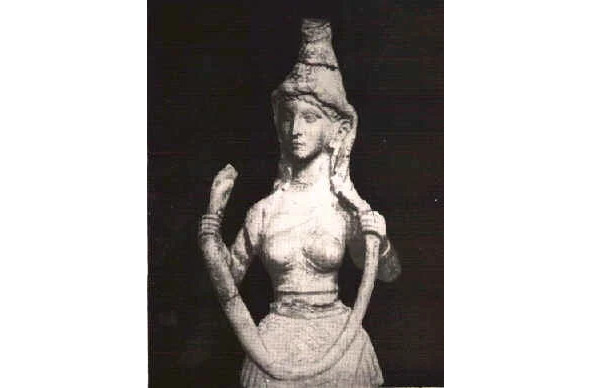
The photo above is the rarest, unfortunately, we could not find the full image. Found only in the album “Aegean Art” 1972. editions. This is about openness in science, and take a look at the stowet’s headdress. Before us is a Scythian hat, no more and no less, another proof of the migration of the Huns-Gans at the beginning of the third millennium to Hellas and Egypt. Then the Hans proceeded to India, and the myth about this remained in the form of the myth of Dionysus’s campaign in India. that is, the identity of the shepherd kings (Hyksos) and the Huns-Hans is obvious.
The name Mycenae comes from one of the names of the bull, this is the ancient Greek word from Homer μυκώμεναι (Hom.) — to roar, moo like a bull. There is also an image of a bull in the famous village of Mycenae No. 1428. The name of Mycenae, and the name of the Macedonians — the name of the city and tribe is derived from the name of a bull or a cow. And the translation of the word -δόνες- giving as a gift, worshipers, therefore, the origin of the word Danaans is likely from δόνες. Two tribes have a stem with the word δόνες, Macedonians (Greek Μακεδόνες), Myrmidonians (Old Greek Μυρμῐδόνες).
And the later Macedonians lived where myths indicate the place of residence of the Myrmidons.. So it is likely that the Macedonians are part of the Danaans. After the destruction of Mycenae and the expulsion of the inhabitants in 468. BC. The Argians took refugees in Macedonia.
“After the first fifty-oared ship built by Danaus sailed from Egypt to Hellas and was named Pentekontera, and the daughters of Danaus… she, … Gelika, and Arhedica, separated from the others, founded the sanctuary of Athena Lindia and made a sacrifice in… Linda in Rhodes, and it happened during the reign of Erichtonius in Athens, 1247 passed (1511/10). " Parian marble. That is, as you can see the proximity of the dates of 1468 BC. BC and 1511 BC. the time of events is quite understandable and does not contradict each other, but rather they explain that the Argians wanted to wait a reasonable time so as not to be punished. Moreover, the myths say that Mycenae was founded (captured) later, and not by Danae or Egypt himself, but by his grandson or great-grandson Perseus. It is likely that, as in the case of the curse of the Locrians, the period of patience of the Argos had to last 1000 years, and the date of the capture of Mycenae by the Danes in 1468 BC is obtained., though rather the Argians bided their time. Date of foundation of Mycenae-from 1511—1468 BC e. And this dating is quite real, as it is confirmed by two sources — the Parian marble and the date of the expulsion of the Mycenaeans by the Argians.
New migration 13—11 c. BC. Veneds and Sardons go to the West
Thus, the Indo-European tribes settled by the beginning of the 17th century BC in the vastness of Eurasia, reaching both the Balkans and Denmark, as far as Hindustan and China from the Urals and the Ob. But in 12—11 thousand BC, everything changed again. What happened is unclear, but new waves of Indo-Europeans rushed to the West of Europe.
History “Legends about Slovenia and Ruse”. “The Legend of Slovenia and Ruse and the City of Slovensk”, also known as the story “About the history of the hedgehog about the beginning of Rusky lands and the creation of Novagrad”, exists in more than 100 copies of the 17th and 18th centuries; the oldest dates back to 1630. Most of them belong to the second half of the 17th century, including the lists in the Chronicle of Patriarch Nikon, the Chronograph of 1679, and the Novgorod III Chronicle. Modern editions are usually based on a list from the Chronograph of 1679. Historians suggest that the Legend… was compiled by the founder of the Siberian chronicle, Metropolitan Cyprian (1626—1634)
“Little by little, the great-grandchildren Afetov Scythian and Zardan separated from their brethren and from their kind from the Western countries, and touched the midday countries, and took possession of Eksinopont, and they live there for many years, and from these sons and grandchildren were born and multiplied greatly, and nicknamed after the great-grandfather of his Scythian Scythia the Great. And there was strife between them and civil strife and sedition are many and crowded for the sake of a place.”
Here is the most important opus about Sardons, referred to as a kindred people to the Scythians. The Sardons settled as far as Narbonne Gaul, and their city was called Ruscino, now the region of Roussillon. The self-names of the Lydians were Sardones, and the Shardens are known from the Egyptian papyri.
Sardones
The Srdn-w Shardans are the people of the sea who briefly formed the personal guard of the Egyptian pharaohs. They are identified with the people, which around the 14—13th centuries. BC e. arrived in Sardinia and founded the culture of the Nuraghe builders there. In the same period, similar cultures arose in Corsica (Torre builders) and in the Balearic Islands (Talayot builders). They are first mentioned in 1350 BC in a letter from the prince Rib-Hatta to Pharaoh Akhenaten. Further, the shardens are mentioned in the troops of Ramses II, but already under Merneptah they invade Egypt, and were defeated only by the pharaoh Ramses III at the epic Battle of Sais. Sardons-Shardens are an Indo-European tribe, even rather a conglomerate of tribes. The Lydians also called themselves Sardis, or rather Shards (Arrian’s Greek spelling is sfarda, but there is no letter Ш in Greek). The capital of Lydia is Sardis. This people settled both Corsica and Sardinia, and even reached Gaul, settling its southern part. The toponyms remained in the form of Roussillon, formerly called Ruscino. In Corsica there is the city of Rusio, and the Settlement Rossignoli on the coast of the island. Chertkov A.D. he is one of the undeservedly forgotten and unmentioned Russian historians, whose contribution to historical science is underestimated. Chertkov’s works were very important for this book. Chertkov Thracian tribes who lived in Asia Minor. — 1st ed. — M.: In Univ. Typ., 1853. — 140, approx. 32 s.
Chertkov “Pelazgo-Thracian tribes that inhabited Italy and from there moved to Rhetia, Vendelikia and further north, to the Maina River.” — 1st ed. — M.: In Univ. Typ., 1853. — 102, approx. 46 s.
Chertkov “On the language of the Pelazgians who inhabited Italy, and its comparison with ancient Slovene”. — 1st ed. — M.: In Univ. Type., 1855. — 193 p.
Talos (ancient Greek Τάλως, Τάλων) — in ancient Greek mythology, a bronze knight, given by Zeus to Europe to protect the island of Crete. The last of the “copper ash”, Zeus gave it to Europe. According to another version, the son of Adonis and Eurynome. It is also called Hephaistoteukton (ancient Greek ἦφαιστότευκτον “created by Hephaestus”), Zeus gave him to Europe as a guard. Apollonius of Rhodes calls Talos the last of the “copper ash-born”, in the Orphic Organautics he is called “three times copper giant.” The only place where he could be injured was the heel, where there was a vein filled with ichor (blood of the gods). Three times a day, he ran around the entire island, despite its size. It is called “three times copper giant” (according to others, a bull). He did not allow foreigners to enter the island, throwing stones at them, and if they did stick to the shore, he heated himself in fire and killed them in his arms. (Orphic Argonautics 1350—1352 // Losev A. F. Mythology of the Greeks and Romans. M., 1996. S. 157) According to Simonides and Sophocles, he burned the victim (according to Simonides Talos was from Sardinia), and killing, he laughed, which is why sardonic laughter is called. Or, since the Cretans founded Troy, and the Lydians were also Sards or Sardons, then some of the Cretans were Sardians, and hence Talos was thought of as a Sardon. So the tradition of the smile of death is much older than the words of the great Marcus Aurelius.
Stari Ras (Serb. Stari Ras / Stari Ras) is a complex of medieval monuments located on the territory of Serbia. UNESCO World Heritage Site since 1979. The tectonic region of Sardona (Glarnsky naryazh) is a mountainous region in the north-east of Switzerland, apparently, the name given by the ethnonym Sardov-Sardons.
Roussillon (Cat. Rosselló, French Roussillon) is a historical province in southern France between the Pyrenees and the Mediterranean Sea. The main city is Perpignan (now the department of East Pyrenees). In the Middle Ages, the county of Roussillon was located here, then — the Catalan comarca Roussillon. The ancient inhabitants of Roussillon were the Sardon tribe; their main city, Ruscino, was destroyed by the Normans. The name comes from the name of the fortified settlement Ruscino (Latin Ruscino, Rosceliona) near modern Perpignan, the former center of the region of civitas Ruscinonensis, which was part of 121 BC. e. in the ancient Roman province of Narbonne Gaul. In 462, the region, along with the rest of Septimania, was annexed to the Visigothic kingdom by King Theodoric II. Sordons or Sardons are a people who lived in the pre-Roman era in the extreme northeast of the Iberian Peninsula.
The main cities of the Sordones were Ruscino (now Château-Roussillon, fr: Château-Roussillon near Perpignan) and Illyberis (now Elne, fr: Elne)
But, the sardons-chardons left place names in the form of city names in the form of Alba. Albi is a city in southern France, near Toulouse, where this tribe settled. the city of Alba is in Sardinia and on the Apennine Peninsula in Liguria. Alba (Italian Alba) is the main city of the Langhe region on the border of Liguria and Piedmont, along the Tanaro River, in the Italian province of Cuneo. The famous Alba Longa, where the founding fathers of Rome came from.
Olbia was probably also founded earlier by the Sardones. The Moesians were also a related tribe, as evidenced by the name of the city of Sarda, or the romanized name of Serdika, the present Sofia of Bulgaria. And in France, a treasure was discovered with a large number of tablets, with a letter resembling Etruscan and Lydian. The name Chardon is still used in France today. And, the southern part of Gaul was not inhabited at all by the Celts, but by the Sardinian Sardons, close to the Etruscans, and the rapid Romanization of the region in the future is connected with this. The Etruscans-Rasena, this is also part of the union of the Sardon tribes, and the Greeks called them who came from Lydia. Procopius in his war with the Goths mentions in central Italy, the fortress RUSSIANU.
“Meanwhile, Belisarius summoned John to Driunt (Hydrunt) and, together with Valerian and other leaders, assembled a large fleet and immediately sailed with haste to Rusciana.”
The self-name contains the root of the RAS, which was repeatedly used in toponymy of the places of settlement of the Sardons-Sardians. We can say this is one of the historical peoples who populated vast spaces in Europe at the end of the Bronze Age.
What does the root RAS-RUS mean in Indo-European languages?
Rasa (literally rāsa, “sap of plants”; figuratively “best, strongest” is a Sanskrit theological concept used in the traditions of Krishna-bhakti, in particular in Gaudiya Vaishnavism. As we will see later, this concept best fits the meaning of RAS -Rus in ancient times, as a concept of nobility, nobles in Indo-European communities.
Giant in German is Riese, Hüne. That is, the value is HIGH. In Russkoye — ROSLY, ROSTOK. As you can see, the meaning of this in the Indo-European languages is identical, in the meaning of high, noble, best.
“In a little time, the great-grandchildren Afetov Scythian and Zardan separated from their brothers and from their kind from the Western countries, and touched the midday countries, and took possession of Eksinopont, and they live there for many years, and from these sons and grandsons were born and multiplied greatly, and nicknamed by the name of his great-grandfather Scythian Scythia the Great. And there was between them strife and civil strife and sedition, a lot and cramped for the sake of a place. " (“The Legend of Slaven and Ruse, Published according to the Complete Collection of Russian Chronicles. T. 31. L., 1977)
Here is the most important opus about Sardons, referred to as a kindred people to the Scythians. The Sardons settled as far as Narbonne Gaul, and their city was called Ruscino, now the region of Roussillon. The self-names of the Lydians were Sardones, and the Shardens are known from the Egyptian papyri.
I.e. As you can see, the Zardons-Sardons were known in Russia as early as the 17th century, judging by the “Legend of Slaven and Rousse”, thereby confirming its authenticity.
Etruscans as part of the Sardons
Since, as Herodotus argued, the Etruscans are immigrants from Lydia, a region in Asia Minor, — Tyrrhenians or Tyrsenes, forced to leave their homeland due to catastrophic crop failure and hunger. According to Herodotus, this happened almost simultaneously with the Trojan War. Gellanicus from the island of Lesbos mentioned the legend of the Pelasgians, who arrived in Italy and became known as Tyrrhenians. The Lydians, or Meons, were a disappeared people who spoke the Lydian language of the Luwian subgroup of the Anatolian group (or branch) of Indo-European languages. They were called Lydians by the Assyrians and Greeks, and the self-name was “meons”, another the self-name was “sfardeny”. Arrian called them Sfardens, or more likely, Shardens in his book about Alexander the Great. According to Xanthus of Lydia, the first king of the Meons was Atius, who had two sons: Lid and Torreb. They were divided into Lydians and Torrebians. The Lydians were excellent horsemen, and only military cunning allowed the dogs to defeat the Lydian horsemen in battle. They are referred to as residents of Lemnos and Crete, and Troas. One of the four main regions of Thessaly in historical time was called Pelasgiotida (Strabo. Geography IX 5, 3 (p. 430). The Pelasgic plains stretched from Fer to Magnesia. By the way, the dynasty of Epirus was always associated with Troy through the marriage of Achilles’ son Neoptolemus with Andromache And in the family of the Epirus kings and kings of Macedonia, the name ALEXANDER was used, which was not used in the rest of Hellas, except Thessaly.
Thus, the Pelasgians are associated in many respects with Troy, and therefore with Asia Minor.
The Venets, the Etruscans’ neighbors in Italy, also came from Asia Minor, and they are mentioned by Quintus Curtius Rufus living there in the book about Alexander the Great.
Roman writer Justin, processing the “World History” of Pompey Trogus, 1st century. BC, wrote:
“After all, the Tusa peoples (populi), who own the coast of the Lower Sea, came from Lydia, and the Veneti, whom we now see living near the shores of the Upper Sea, were brought here by their leader Antenor, when Troy was taken and conquered.” Justin, XX.1.7—8.
That is, Justin confirms the arrival of the Veneti from Asia Minor, and as you can see, the writing of the Veneti and Etruscans was identical. By tus he means the Etruscans; the Romans called the Etruscans tus. Tusci. The Etruscans expelled the ancestors of the Germans, actually the Tus, from Italy. In Rome, Etruscans were considered natural-born sorcerers and the cult was organized according to the Etruscan rite. Even the word CEREMONY has Etruscan roots, from the famous lukomons from CERE, the city of Etruria.
The connection between the Etruscan language and the Italic dialects, in particular with the Sabine and Latin, is very interesting. There are many Latin and Sabine words of a clearly Etruscan character. Etruscan origin Roman male names in a: Sulla, Cinna, Catilina, Perperna (Etruscan name Porsenna). A connection can be made between Etruscan personal names and some of the names and terms of early Rome. The names of the three old Roman tribes — Ramna, Titia and Lucera (Ramnes, Tities, Luceres) correspond to the Etruscan generic names rumulna, titie, lucher. The names “Rome” (Roma) and “Romulus” (Romulus) find a close analogy in the Etruscan rumate, the Etruscan-Latin Ramennius, Ramnius, etc.
Бесплатный фрагмент закончился.
Купите книгу, чтобы продолжить чтение.